The Apple Watch had been my primary workout companion for a number of years, until a friend recommended that I try WHOOP, a high-tech fitness tracker that was different from anything I had seen before.
I’ve now been wearing WHOOP since January 2019, and in this review, I’ll share some of the insights I’ve gained from using the device over the past few years, including:
- Stress and other lifestyle factors measurably impact my heart rate variability (HRV), resting heart rate (RHR), recovery and sleep quality.
- My HRV is a reliable indicator of when I’m about to get sick (and when I recover).
- Alcohol ruins my sleep (no surprise there).
- Late meals decrease the quality of my sleep (they result in less slow-wave and REM sleep).
- Reading a book before going to sleep (instead of reading on my iPhone or iPad) helps me sleep better and longer.
- Intermittent fasting dramatically impacts my sleep and recovery.
While some of the information in this review applies to all WHOOP generations, including the WHOOP 2.0 and 3.0, some of it only applies to the latest-version, the WHOOP 4.0.
WHOOP 4.0

Summary
WHOOP gives you valuable insights into your exercise performance, recovery, rest and sleep in a way that no other device can. I’ve worn WHOOP since January 2019, and the data it has provided has helped me optimize my diet, workouts and lifestyle habits.
Pros
- Packed with sophisticated sensors that collect five health metrics 100 times per second.
- Accurate sleep and HRV tracking.
- Provides insight into your daily strain and recovery rate, as well as detailed sleep performance data.
- Long battery life.
- You can recharge WHOOP without taking the strap off your wrist.
- Comfortable to wear 24/7.
Cons
- Doesn’t support third-party chest straps (HR monitors).
- Strain tracking is more reliable for cardio workouts (than HIIT or Olympic lifting).
- Doesn’t offer airplane mode to reduce EMFs while sleeping.
WHOOP gives you insight into exercise performance, recovery, rest and sleep in a way that no other device can.
As an enthusiastic CrossFit athlete and healthy living advocate, I’m always on the lookout for ways to hack my performance and improve my sleep quality and post-workout recovery. That’s one of the reasons I was such a fan of the Apple Watch.
While I appreciate that Apple has turned its wearable device into an excellent fitness companion, it still has many limitations:
- Detailed sleep tracking (even in the Apple Watch
- It offers no useful analysis and reporting around exercise performance and recovery.
However, it’s not just the Apple Watch that struggles with those issues. Other wearables, such as Fitbit and Android-based smartwatches, also suffer from the same shortcomings.
WHOOP founder and CEO Will Ahmed, a Harvard graduate, must have felt similarly when he decided to develop a solution that fills all of the above gaps and more.
WHOOP accurately tracks cardiovascular strain, as well as exercise and sleep performance. It also tells you how well you recovered overnight, and how hard you can push it that day.
The result is WHOOP, a clever combination of wearable technology with a membership that provides professional-quality analytics of your data, paired with a community of like-minded users that includes professional athletes (e.g., NBA players), coaches, trainers and Fortune 500 CEOs.
What Is WHOOP?
Contrary to what you might think, WHOOP is not just another fitness tracker, like Fitbit. It’s also a membership that connects you to a community of like-minded health enthusiasts.
More importantly, it enables you to “unlock the secrets your body is trying to tell you.” What that means is that WHOOP provides insights into your performance, recovery and sleep data that go way beyond what most consumer-grade fitness trackers offer.
WHOOP is a high-tech gadget that can guide you through exercise, recovery and sleep. For example, it tells you if your body has recovered sufficiently to push it during your next workout, or if it’s better to take it easy for a day. It also lets you know how much sleep you’ll need tonight, based on your level of activity during the day and any sleep debt you might have accrued.
WHOOP Hardware and Sensors

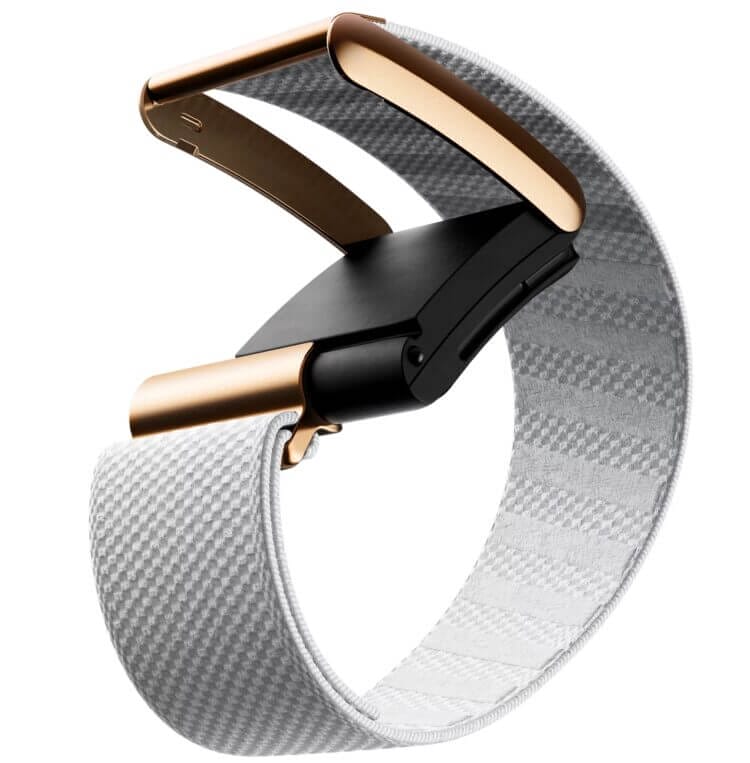
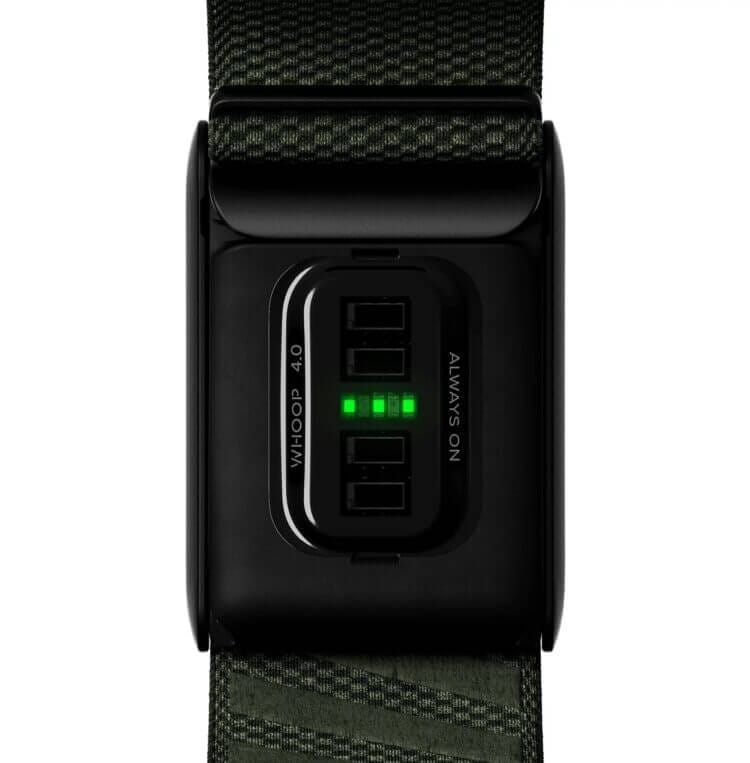
One of the things I immediately noticed when I put the strap on for the first time was that WHOOP doesn’t have a display or buttons. In fact, it can’t even tell you the time. There’s no way to interact with the device, other than double-tapping it to see the remaining battery life via a tiny LED on the side.
But don’t be fooled by WHOOP’s simplicity! The wearable device contains a ton of sophisticated sensors that can measure your heart’s beats per minute, heart rate variability (HRV), electro-dermal activity (EDA), skin temperature, blood oxygen saturation (SpO2), movement and 3D acceleration.
I’ll explain what all that means and why it’s important in a bit, so hang tight!
How Is WHOOP Different?
The key differentiator of WHOOP is that all those sensors collect data 100 times per second (and 24/7), as long as you wear the strap. In comparison, the Apple Watch only collects heart-rate data at a high frequency during workouts. Otherwise, it only samples your heart rate every few minutes. The same is true for many of the other fitness trackers I’ve reviewed, including the Fitbit Versa.
By collecting such an incredible amount of data, WHOOP can detect minuscule changes in how your body responds to exercise, rest and other stimuli throughout the day and overnight.
Heart rate variability (HRV) is the difference in timing between heart beats expressed in milliseconds and a proxy of the balance between your sympathetic and parasympathetic nervous systems. You can learn more about HRV and how to improve it in this blog post and YouTube video.
Besides collecting an incredibly large amount of data, WHOOP can also correlate changes to your core biometrics (such as resting heart rate and heart rate variability) and sleep quality to lifestyle choices, such as a late meal or alcohol consumption. That enables you to improve your sleep and performance by making adjustments to those lifestyle factors.
Since so much of the information you get from WHOOP relies on its sensors and their accuracy, let’s talk about the hardware in more detail.
Optical Heart Rate Sensor
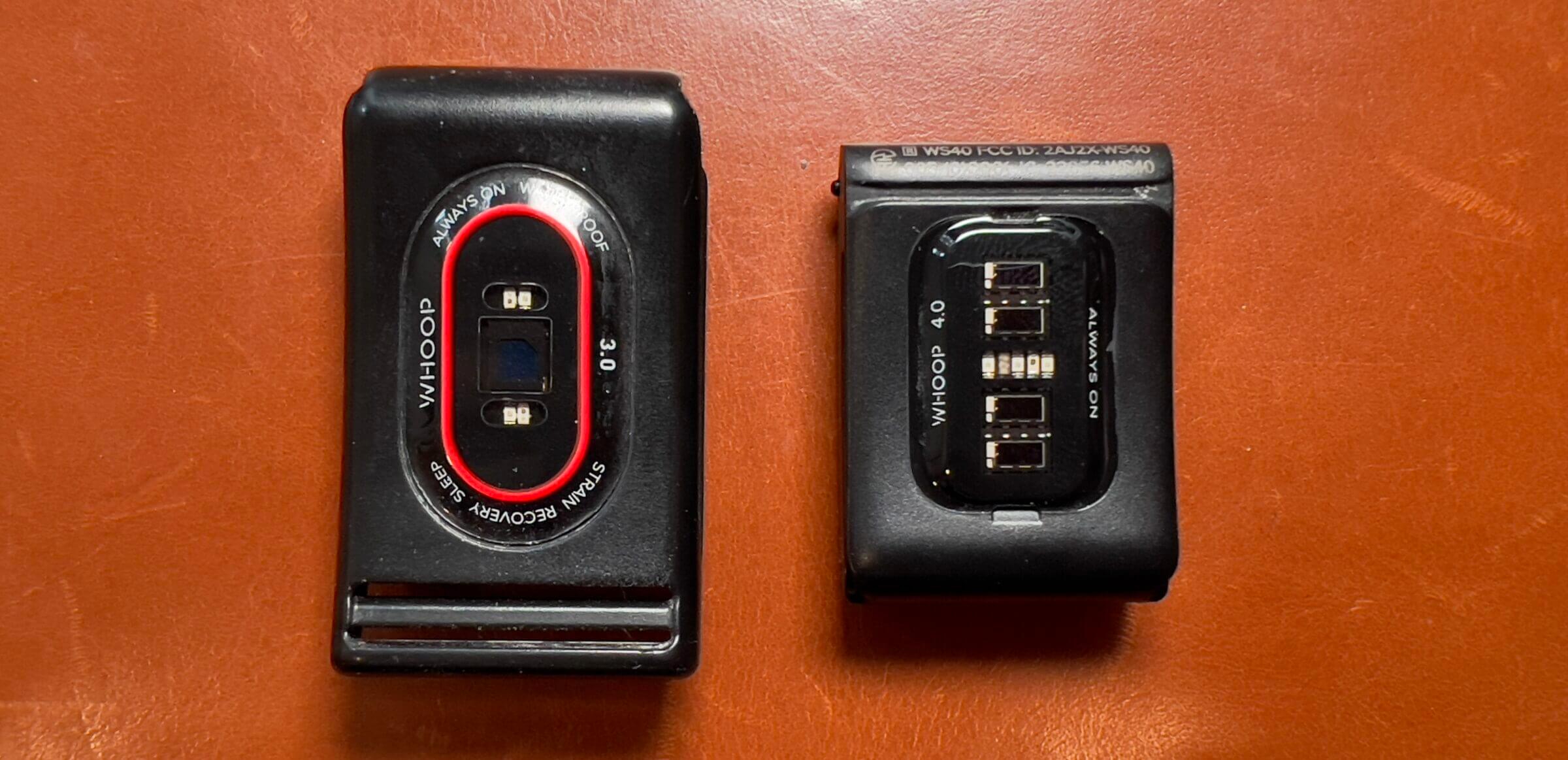
The WHOOP 4.0 features an optical heart rate sensor with green LEDs that shine light through the blood vessels underneath your skin and four photodiodes that collect the reflected light. The technology behind WHOOP’s HR sensor is called photoplethysmography (PPG), and it enables WHOOP to measure your heart rate and heart rate variability.
While WHOOP 3.0 leveraged the same technology, the old strap only had two green LEDs and one photodiode. In theory, the additional LEDs and photodiodes should improve WHOOP’s HR measurements, especially under less-than-ideal conditions. To find out whether that’s true in practice, I performed several tests while wearing both WHOOP 3.0 and WHOOP 4.0. You can scroll down to my side-by-side comparison to see how the devices compare.
Pulse Oximeter
In addition to the standard optical heart rate sensor, WHOOP 4.0 uses pulse oximetry to reach deeper blood vessels and differentiate between oxygen-carrying and non-oxygen-carrying hemoglobin. That enables WHOOP to track blood oxygen saturation (SpO2) using a combination of one red and one infrared LED.
Aside from unlocking SpO2 monitoring, pulse oximeters are more reliable when used on darker skin tones, pigmentation and tattoos. The downside of red LED-based sensors is that they’re more prone to interference, especially when there is movement involved (i.e., during exercise). That’s why WHOOP only uses its pulse oximeter for sleep tracking. During the day, WHOOP relies on its green LEDs to track your heart rate and any cardiovascular strain you might accumulate.
Skin Conductance Sensor
The skin conductance sensor keeps tabs on changes in how your skin conducts electricity. That’s an important factor for improving the reliability of sleep tracking because skin conductance changes when you fall asleep and during certain stages of sleep.
Interestingly enough, electrodermal activity also changes under stress and during epileptic seizures. For example, a study from 2010 showed that epileptic seizures induce a surge in EDA. So I’m curious if WHOOP has any plans to add stress and seizure monitoring to its platform in the future.
Skin Temperature Sensor
Much like EDA, your skin temperature changes in certain conditions, such as during strenuous exercise, when you have a fever, or during certain parts of the menstrual cycle. WHOOP can monitor and correlate data from its various sensors to understand when and why your skin temperature deviates from your baseline, which is helpful for predicting the onset of a fever or a menstrual cycle.
Additionally, the body also undergoes changes in core temperature (which are often also reflected on the skin) during sleep onset, and as it transitions from one stage of sleep to another (e.g., when transitioning from deep to REM sleep).
3D Accelerometer and Gyroscope
The 3D accelerometer built into WHOOP detects any movement. That’s obviously important for workout detection and exercise tracking. However, WHOOP also uses the accelerometer to assist with heart rate monitoring (the sensor is sensitive enough to pick up individual heart beats) and to keep tabs on your respiration rate while sleeping.

The gyroscope detects any changes in WHOOP’s orientation triggered by wrist movement. Together with the 3D accelerometer, the gyroscope is an essential tool for helping WHOOP differentiate between types of movements.
Battery Life
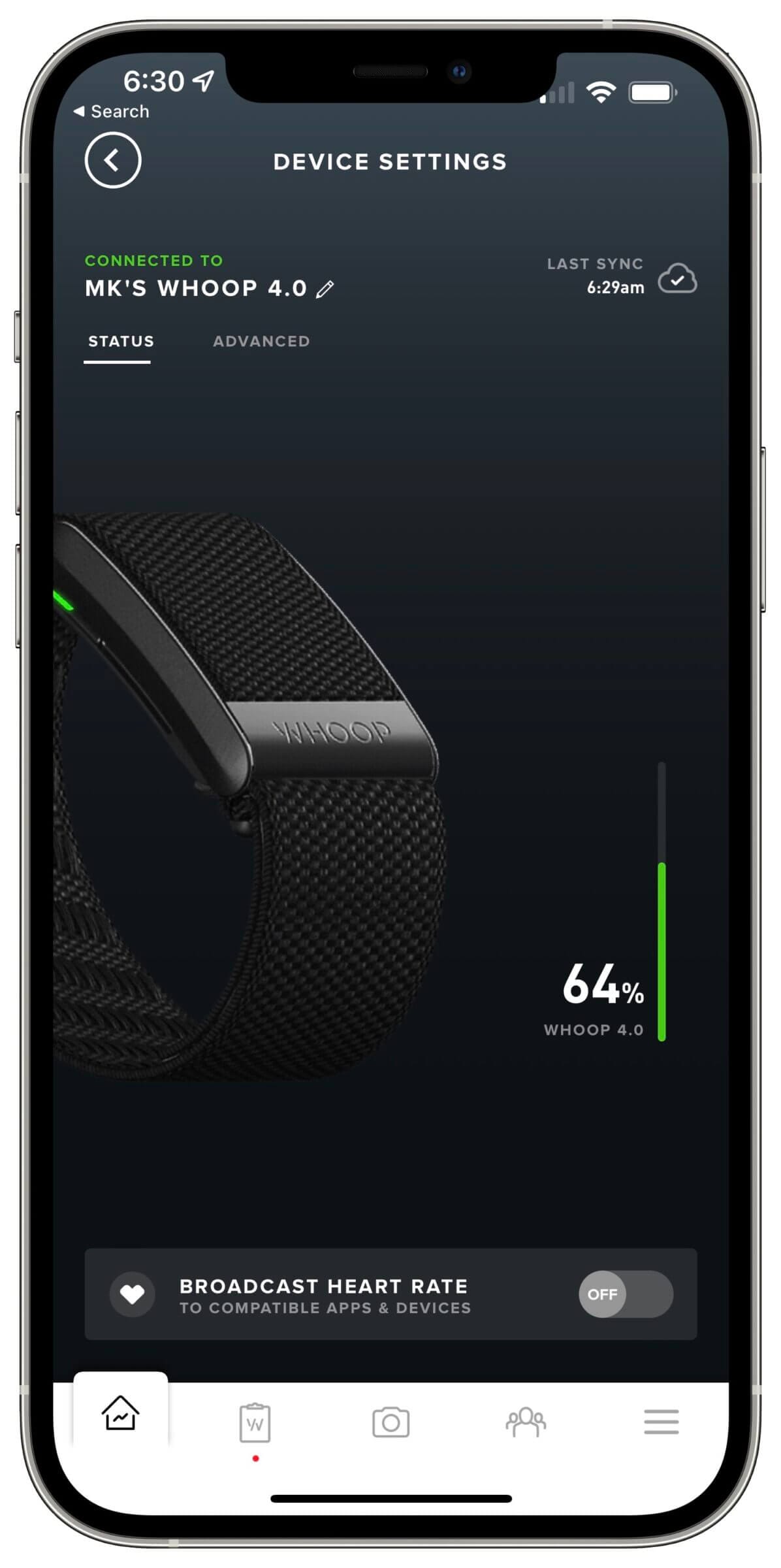
According to the company, WHOOP 4.0’s battery should last for approximately five days. That’s the same battery life as the WHOOP 3.0 and it lines up with my hands-on experience.
While the WHOOP app gives you an exact indication of how much juice you have left, you can also double-tap the device and get a visual indication via an LED on the side:
- Solid green = 50-100% charge.
- Solid yellow = 20-49% charge.
- Solid red = 1-19% charge.
On a side note, WHOOP 4.0’s battery pack has the same color indicators as the sensor (red, yellow and green). In comparison, the WHOOP 3.0 (and its battery pack) had three LEDs that provided a more fine-grained indication (eight charge levels) of how much battery you had left.
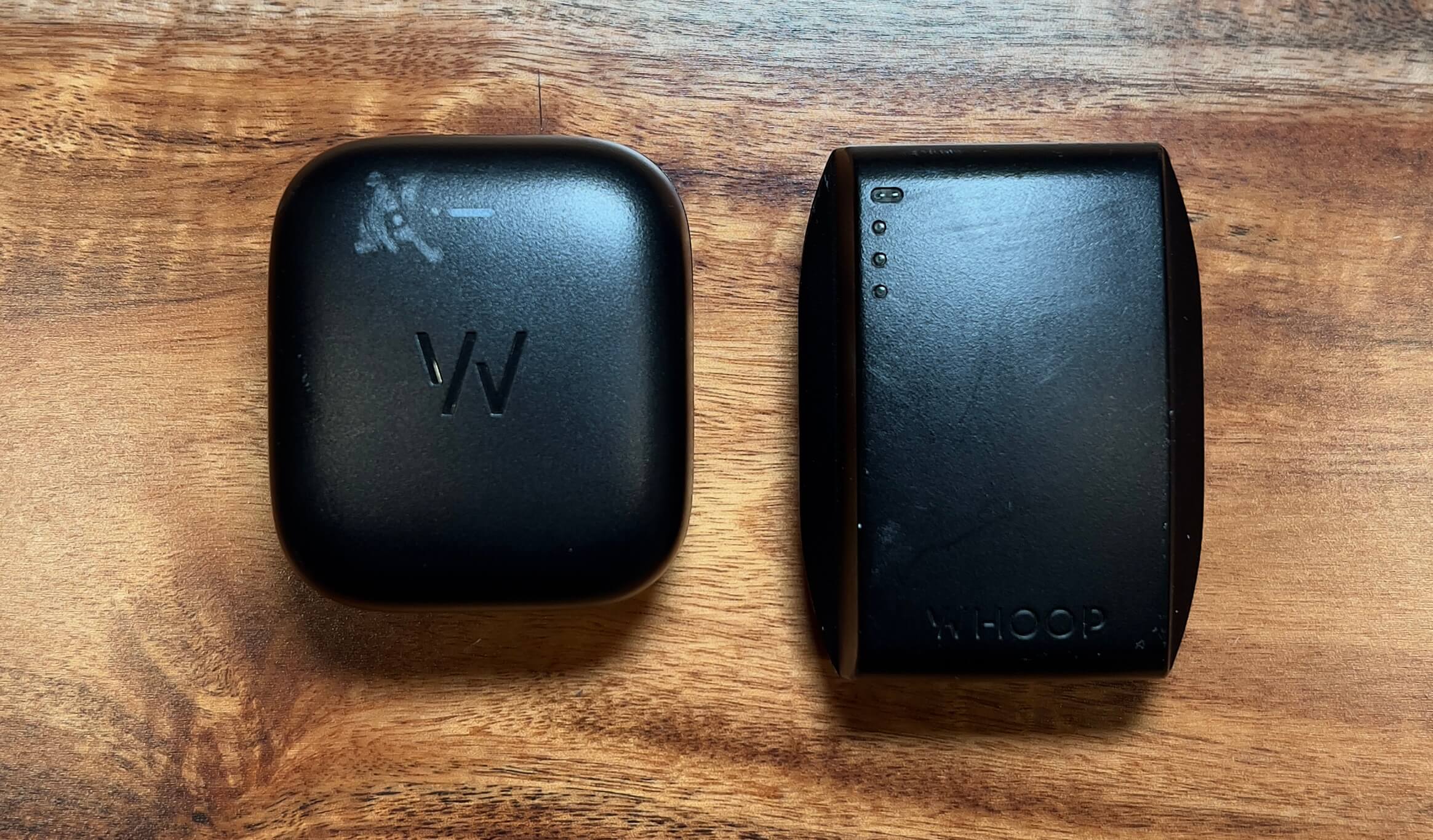
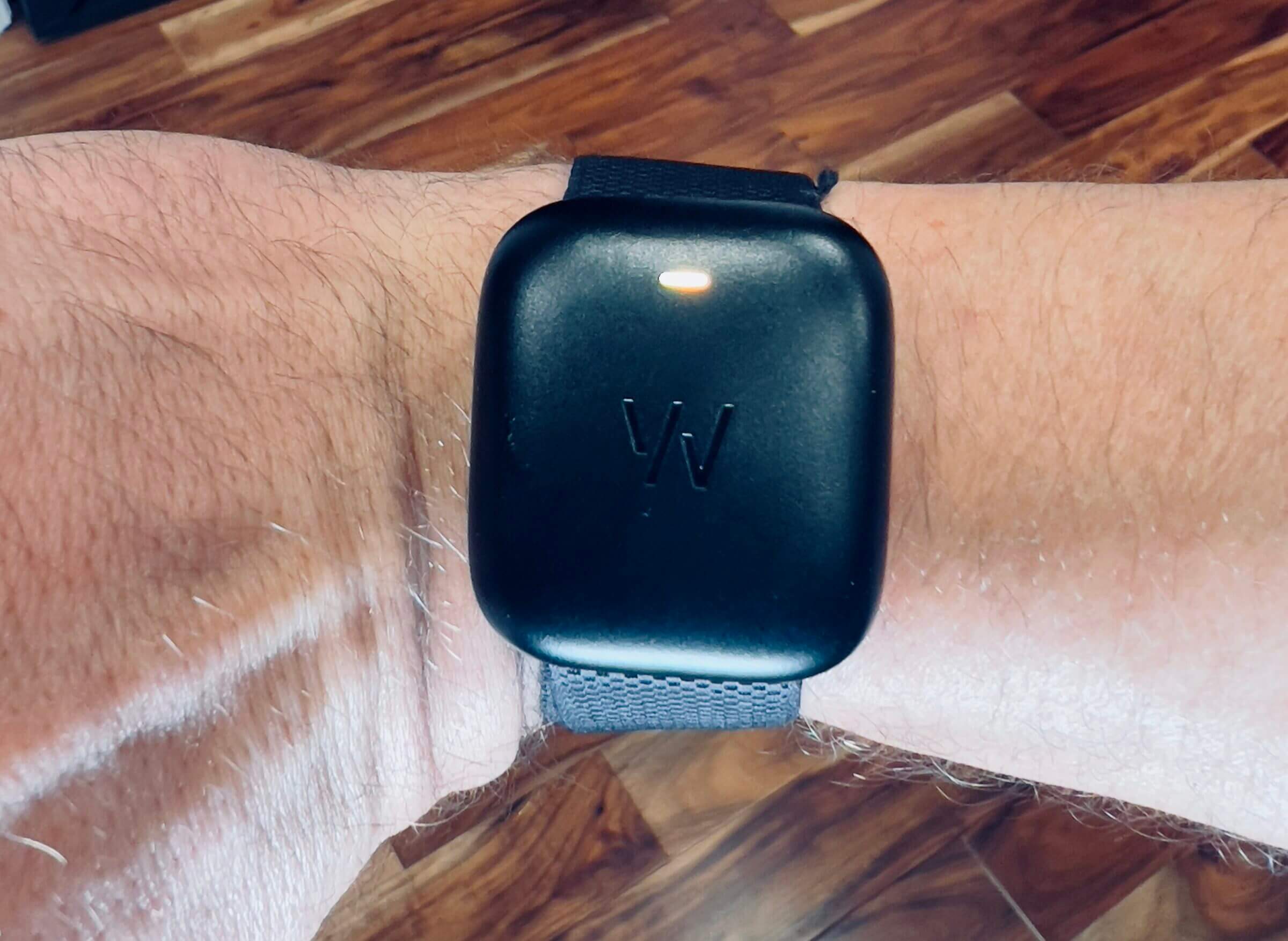
You can find more information about battery life on WHOOP’s support page.
With every other fitness band I’ve used — including the Apple Watch, Oura Ring, Fitbit Versa and Biostrap — I had to take the device off for charging. WHOOP has figured out a way to recharge the strap without having to remove it from the wrist.
WHOOP comes with a charger in the form of a small battery pack that you can slide on top of your strap to charge it. A complete charge takes between 120 and 180 minutes. After charging the strap, you have to charge the battery pack using the included USB-A to USB-C cable.
The previous-generation WHOOP 3.0 used a micro-USB cable, and I’m glad WHOOP decided to make the switch to USB-C.
I’ve gotten into the habit of cycling through this charging routine every four to five days, or when my strap reaches 20% remaining battery charge.
Note that as of the WHOOP 4.0, both the sensor and the battery pack are IP68 dust-proof and water-resistant at depths up to one meter for two hours. That means you can easily take your WHOOP with you into the shower while it’s charging.
That’s a welcome improvement from the WHOOP 3.0 battery pack, which wasn’t waterproof. Some WHOOP users damaged their battery pack when they forgot to remove it before jumping into the shower.
Note: If your WHOOP 4.0 battery drains quickly (i.e., in less than two days), try restarting it via the mobile app (Device Settings > Advanced > Reboot Device). That fixed the issue for me!
Design and Comfort
WHOOP’s wrist straps have come a long way since the WHOOP 2.0. The first review unit I received came with two bands: the Tecnica and the Hydroband.
The Tecnica was incredibly soft and elastic (similar to Apple’s
The Hydroband didn’t stretch, but I didn’t like it very much for two separate reasons: it was less comfortable and I couldn’t quickly move it out of the way when a workout called for gloves or grips.
When I got the WHOOP 3.0, I started using the ProKnit strap and fell in love with it. The ProKnit strap offered the perfect compromise between comfort and function, allowing the WHOOP’s sensors to remain in constant contact with the skin without feeling too tight or uncomfortable.
With the launch of WHOOP 4.0, the company released a new flagship band called the SuperKnit strap. It’s my favorite strap yet and even more comfortable than the ProKnit. It’s incredibly thin, lightweight and comfortable to wear 24/7. It’s arguably the best wrist strap I’ve ever used in any device.
Plus, it has a new “Fast Link” feature that allows you to easily switch bands (see the image below for an example).

The only downside to any of WHOOP’s bands is that they’re not as easy to keep clean as straps made from food-grade silicone. While I don’t care about that (I just rinse my bands whenever I take a shower), it could be an issue for those who work in the medical field, where contamination with germs can be a problem.
That’s one of the reasons why companies like Biostrap stick with silicone bands, even though it renders their bands less comfortable and more difficult to adjust.
Exercise and Fitness Tracking

Since WHOOP doesn’t have any buttons or a display, you can’t tell the device to start tracking a workout routine. The good news is that you don’t have to. Remember, WHOOP measures your heart rate 100 times per second, all the time. That allows the device to detect when you’re working out.
WHOOP can automatically detect over 80 types of exercises, as long as they last longer than 15 minutes or result in a strain score of eight or higher. (I’ll explain what a strain score is in a bit, so hang tight!
Additionally, WHOOP uses a classic accelerometer and gyroscope to detect movement. That’s helpful for certain types of exercises, like lifting weights, that increase your heart rate only moderately. Alternatively, you can use the WHOOP app on your smartphone to start or log an activity instead of relying on the tracker’s automatic detection capabilities.
What’s crucial is that WHOOP uses the collected data to calculate your daily strain. In other words, the device can tell you how hard your cardiovascular system worked on a given day. That’s important because it directly influences your recovery and
WHOOP measures your daily accumulated strain score using a scale from 0 to 21:
- 0 – 9.9: Light
- 10 – 13.9: Moderate
- 14 – 17.9: Strenuous
- 18 – 21: All out
Note that WHOOP calculates strain from your max heart rate, which means the score is highly personalized. The same workout performed by different people (or even pro athletes) might result in different strain scores, so don’t compare your results to someone else’s.
By default, WHOOP detects activities if they last for 15 minutes or longer. So it won’t recognize those 20-second sprints on CAROL, the REHIT bike I’ve been using to complement my CrossFit workouts.
However, even strain endured during shorter physical activities — such as carrying heavy grocery bags from the store to your car — adds to your daily strain score.
Why You Might See Low Strain Scores
Some people, including my wife and I, often see less than optimal strain scores reported by WHOOP — even after intense types of workouts such as CrossFit.
There are a couple of reasons why you might see lower strain scores than anticipated, including:
- A loose-fitting strap that prevents the sensor from maintaining good contact with the skin.
- Physical activity that didn’t increase your heart rate (long) enough.
The first issue can be easily fixed by either making sure your WHOOP is tight enough, by moving the strap farther away from your wrist bone, or by wearing WHOOP on your bicep using a bicep strap or sleeve.
The second issue is usually influenced by the type of activity you perform. For example, endurance training — such as running, biking or swimming — often causes your heart rate to stay elevated for extended periods. That makes it easier for WHOOP (and other wrist-worn devices) to capture your HR readings.
But high-intensity workouts like CrossFit often cause massive HR fluctuations (combined with wrist movements) that can make it difficult for any wrist-worn device to get a good reading. As a result, you can expect lower strain scores for these types of workouts.
Additionally, some HIIT workouts are relatively short. The ones I do are often in the 10-20 minute range, and while they might be exhausting they don’t cause my heart rate to be elevated for extended periods. That’s a crucial factor because WHOOP tracks strain based on how long your HR remains elevated above your “baseline.”
WHOOP starts accumulating strain when you reach 30% of your HR reserve, which is calculated based on the following formula: Max HR – Resting HR = HR Reserve.
So if your max HR is 200 bpm and your resting HR is 50 bpm, then your HR reserve is 150 bpm. As a result, WHOOP would start tracking strain when your HR reaches 95 bpm (50 + 0.3 * (200-50)).
The problem is that strength training and shorter CrossFit-type workouts usually don’t cause a lot of (cardiovascular) strain (they might cause muscular load instead) and thus you won’t see a high strain score in the WHOOP app.
For reference, I usually accumulate a strain level of 8 to 12 during CrossFit workouts. But building a chicken coop for our Homestead caused a massive 20.2 strain level — the highest I’ve ever recorded.
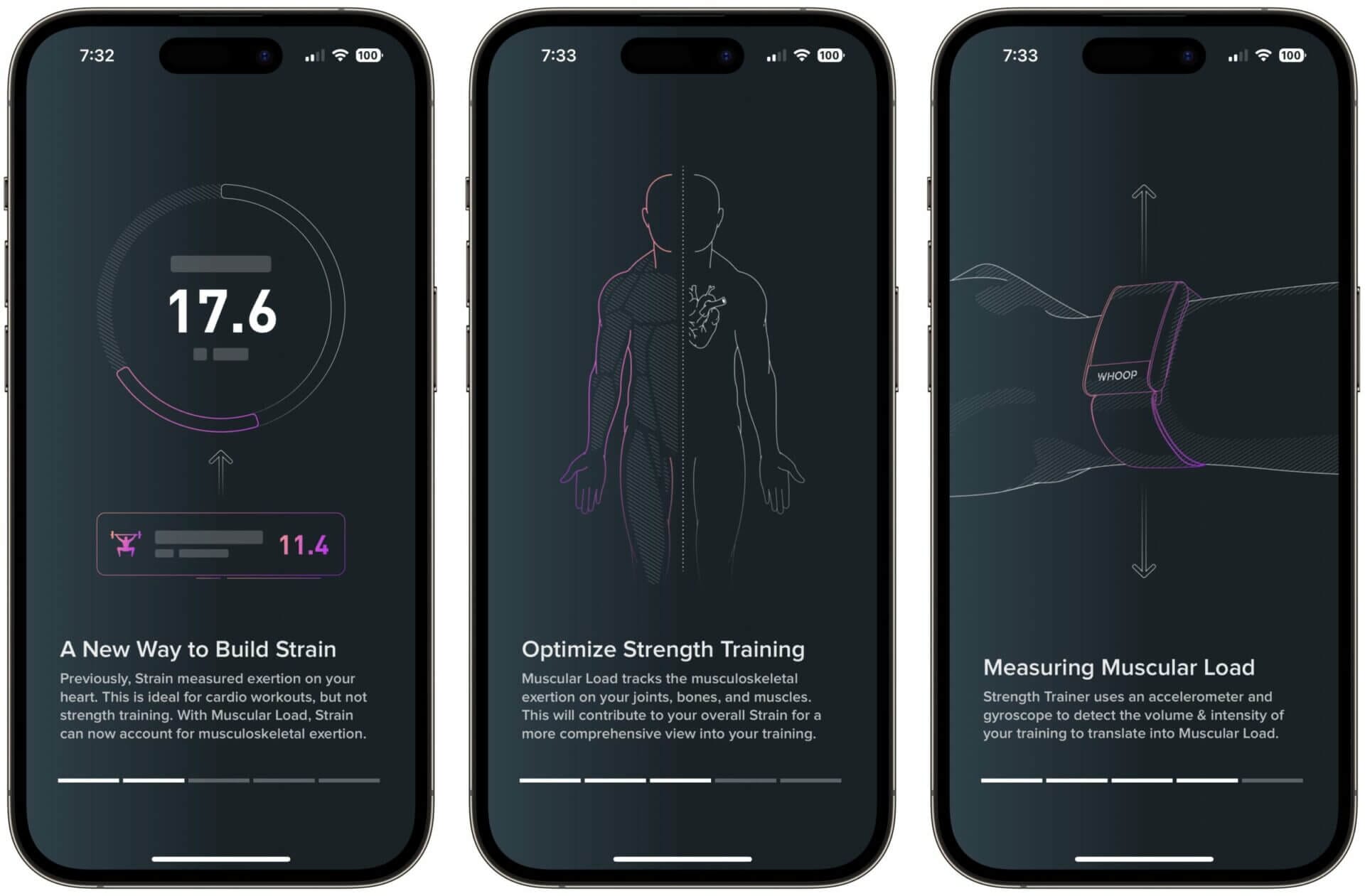
The good news is that WHOOP recognized that shortcoming and added a feature called Strength Trainer to better capture muscular load from olympic lifting and resistance training exercises.
According to WHOOP, Strength Trainer quantifies the muscular load of your workouts by tracking weights, reps and sets to calculate the most complete strain score yet.
How Strength Trainer Works
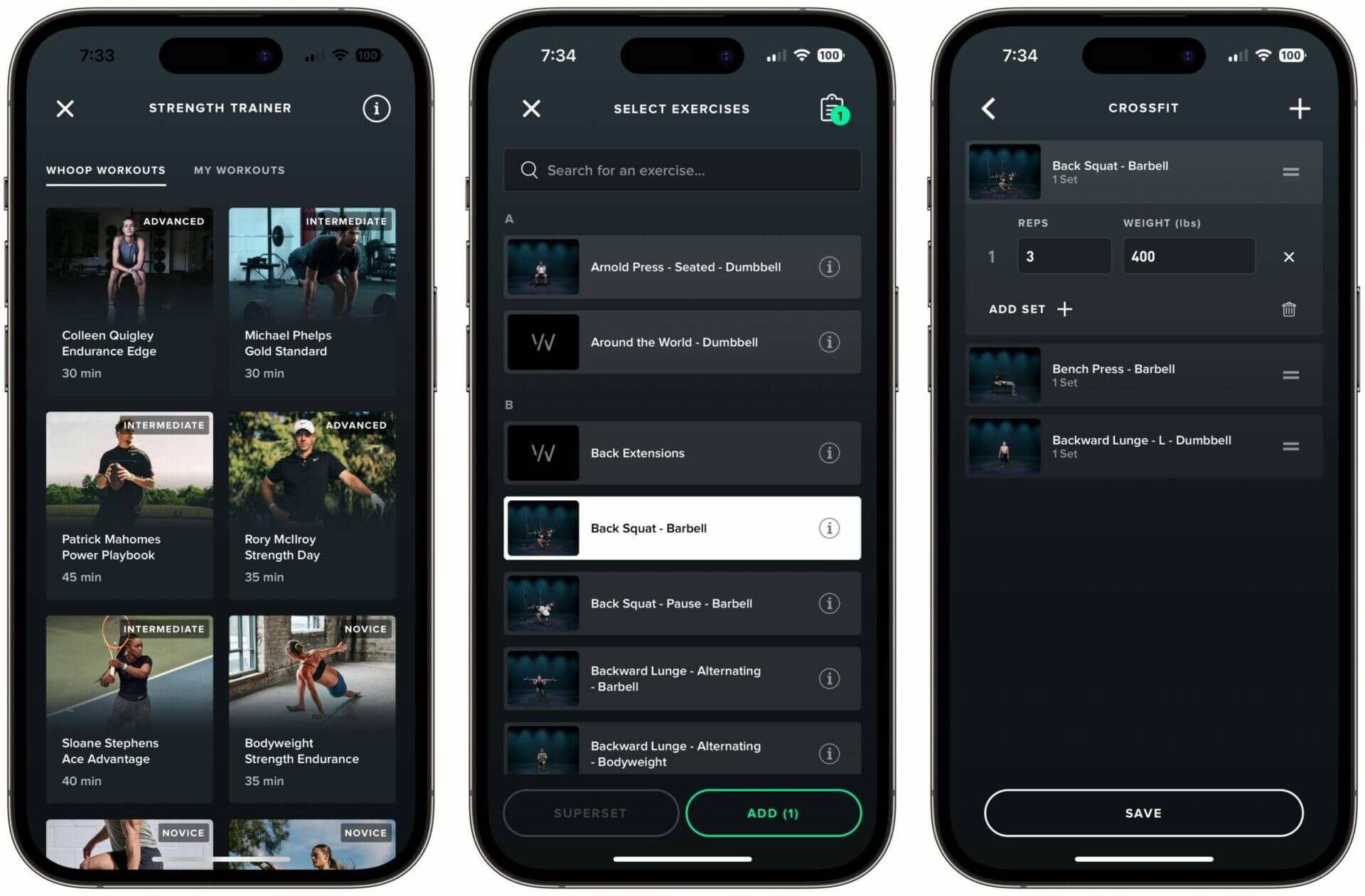
Using Strength Trainer, you can build your own workout or choose pre-built options to make sure you get accurate strain scores. Strength Trainer then quantifies the muscular and cardiovascular load of your workout based on its volume and intensity.
Why You Might See Higher Than Expected Strain Scores
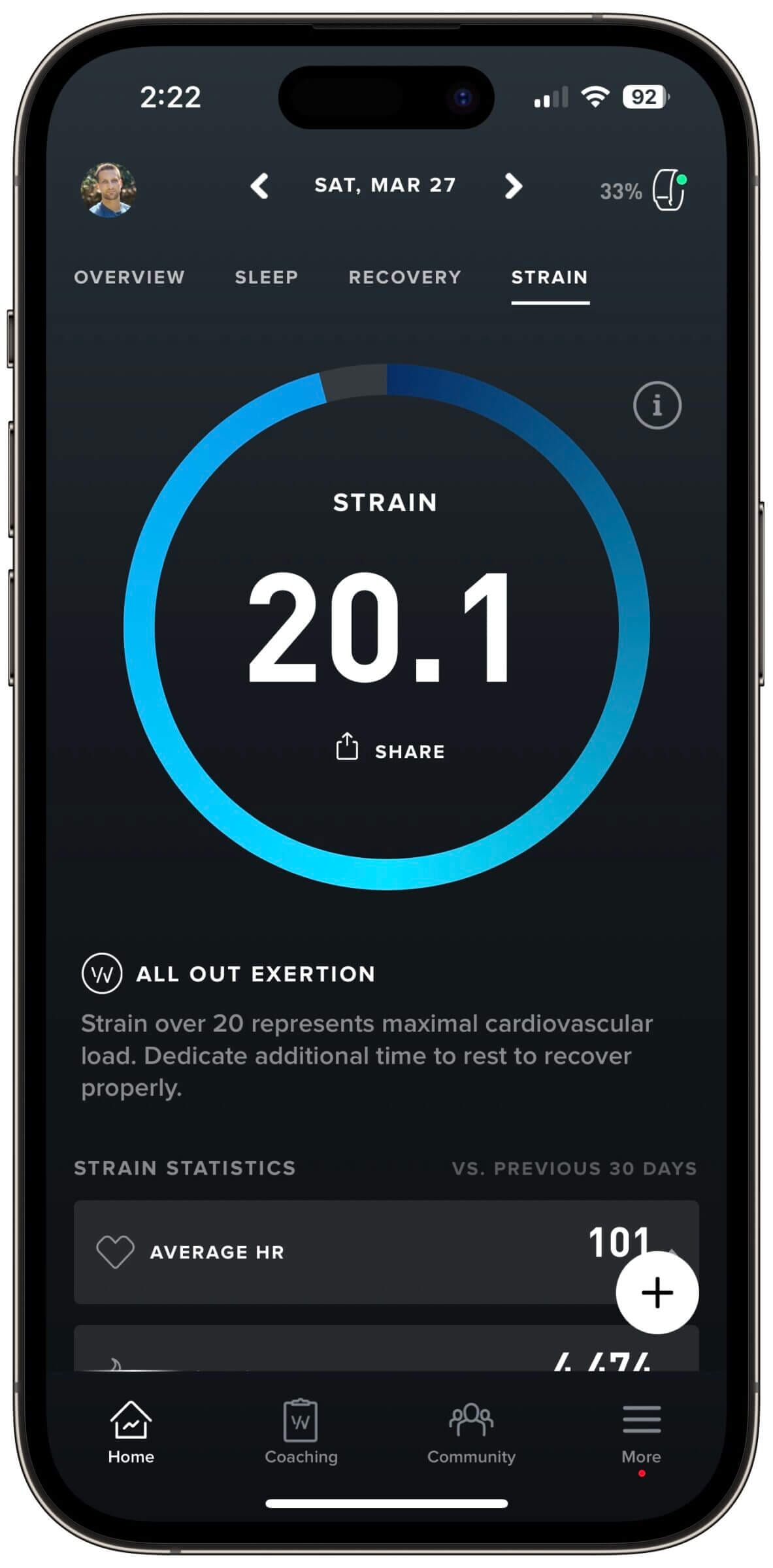
While some people have complained about lower-than-expected strain scores, others have experienced the opposite.
As mentioned above, I recorded my highest-ever strain score while building a chicken coop. While I’m sure using a hammer and drill and lugging lumber around for several hours increased my heart rate, I didn’t have to go all out. In other words, I was much less exhausted building a chicken coop than I usually am after completing much shorter (but more intense) CrossFit workouts that lead to a much lower strain score (usually between 8 and 15).
So what’s going on here?
The problem is that certain movements cause WHOOP (and other wrist-worn devices that use optical heart rate sensors) to incorrectly report a higher heart rate than you actually have. For example, clapping your hands for several minutes or tapping them on a table as if you’re playing a drum set leads to inflated heart rate readings, and thus higher strain scores.
I did the “tap test” in my office while wearing WHOOP and a Polar chest strap. While WHOOP showed a heart rate of over 110 beats per minute, my chest strap accurately reflected my heart rate, which hovered around 70 beats per minute.
That explains why preparing food, chopping onions or performing other common household chores can lead to high strain scores.
I don’t know exactly if the root cause of this problem is that the motion sensor confuses the force of the impact (i.e., the tapping) with a heart beat, or if it’s because the optical heart rate sensor shifts around and thus doesn’t get a good signal. Either way, if this was an easy-to-fix problem, someone would have solved it already. So far, every fitness band I’ve tested suffers from it.
Update: I can confirm that moving the sensor from my wrist to larger body parts (by leveraging WHOOP Body — the company’s new line of functional garments) has fixed the problem. In other words, if I wear WHOOP on my hip, then chopping onions, clapping or tapping no longer causes inflated heart rate readings and strain scores.
How I Leverage WHOOP’s Strain Score
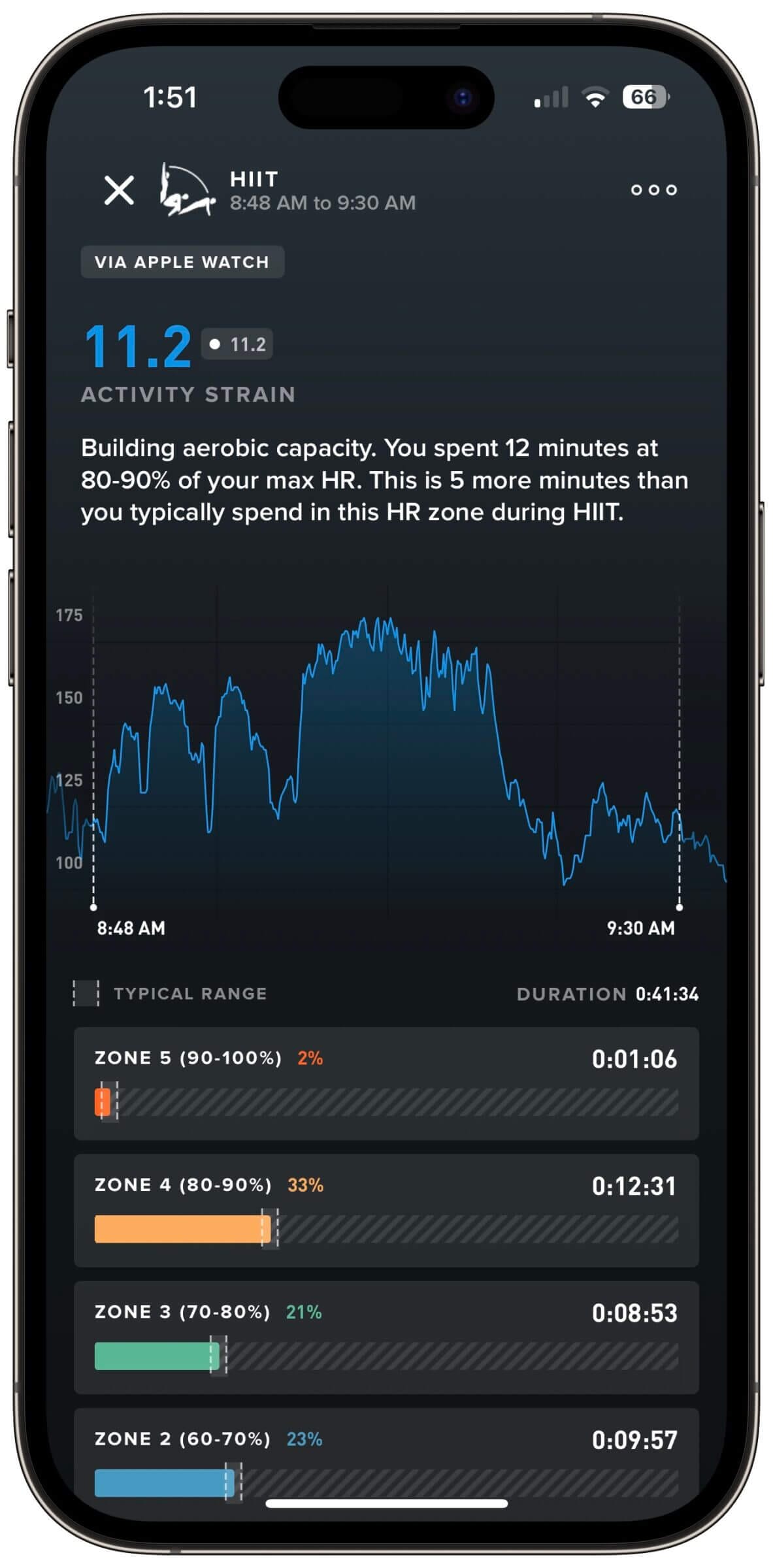
To be perfectly honest, I don’t care much about my strain score or the calorie burn reported in the WHOOP app.
That’s because the type of workouts I perform aren’t conducive to tracking cardiovascular strain. I explained the problem with tracking the strain of CrossFit workouts in the previous section, but I wanted to give you another example.
I have an AI-powered reduced-exertion high-intensity interval training (REHIT) bike called CAROL. Each ride on CAROL lasts for only 8 minutes and 40 seconds, but my heart rate only spikes during the two 20-second sprints that are part of the workout.
However, those two short sprints empty 30% of my muscle glycogen stores and activate certain metabolic pathways (such as AMPk) that improve my cardiorespiratory fitness at the same rate as a 45-minute run.
The problem is that none of the fitness trackers on the market (including the WHOOP fitness tracker) can pick up on that, because they all rely primarily on heart rate information.
As a result, I build very little cardiovascular strain. That’s why I don’t bother with WHOOP’s strain scores.
As I explained in my article comparing WHOOP with the Apple Watch, calorie tracking is a gimmick because it relies on relatively unreliable data models and estimates of how many calories someone with your height, weight and gender might burn at rest.
It’s not WHOOP’s fault that the calorie burn the app reports might be way off; it’s just that you can’t determine actual calorie burn without telling the device what your basal metabolic rate (BMR) is (i.e., the calories you burn without any physical activity).
Determining your BMR requires special equipment and a standard test on a bike ergometer. I’ve done that in the past and I hope that at some point in the future, WHOOP will allow me to enter my BMR data via the app.
Recovery Tracking
I’m incredibly competitive (primarily with myself), and I’m in a constant battle with my mind during workouts. For example, if my brain
The issue with such a strategy is that it can take an incredible toll on your body. Sometimes, I feel like although my mind is getting stronger my body isn’t — or at least not at the rate I’m expecting.
Over time, I’ve come to realize that there needs to be a balance between strain and recovery. If your body endures too much strain without sufficient opportunity to recover, you end up with what’s called a recovery deficit. The result? You don’t improve, but you do increase your risk of injury.
Aside from “listening to my body,” I haven’t had a means by which to evaluate how recovered I was on a particular day. That’s where WHOOP can help.
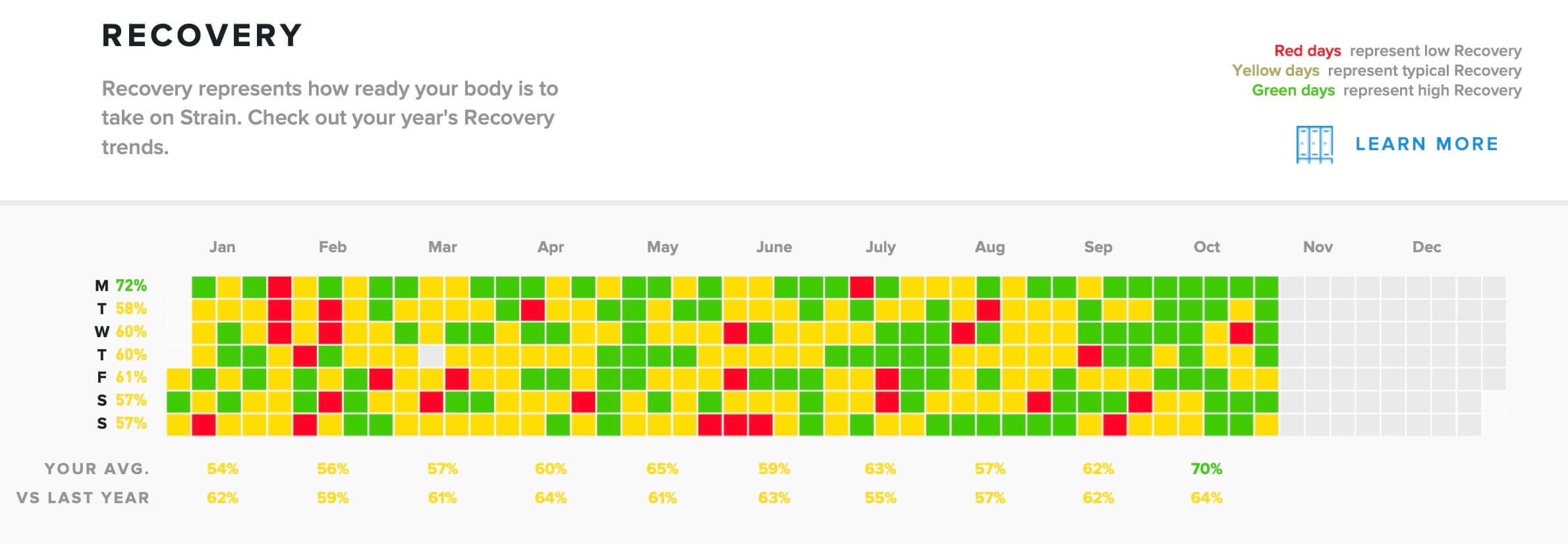
Every morning, the WHOOP app gives me a recovery score, expressed as a percentage (e.g., 75% recovered), based on key metrics from my heart, nervous system and sleep performance. Depending on my recovery percentage, WHOOP suggests my optimal strain for that day to prevent over-training and to lower the risk of injury.
Considering what I wrote above about the limitations of tracking cardiovascular strain, I use WHOOP’s recovery percentage as a general guideline for my training load and how much stress I should expose my body to.
By “stress,” I mean anything that stresses my body, either mentally or physically, including exercise, intermittent fasting or even the consumption of coffee and alcohol.
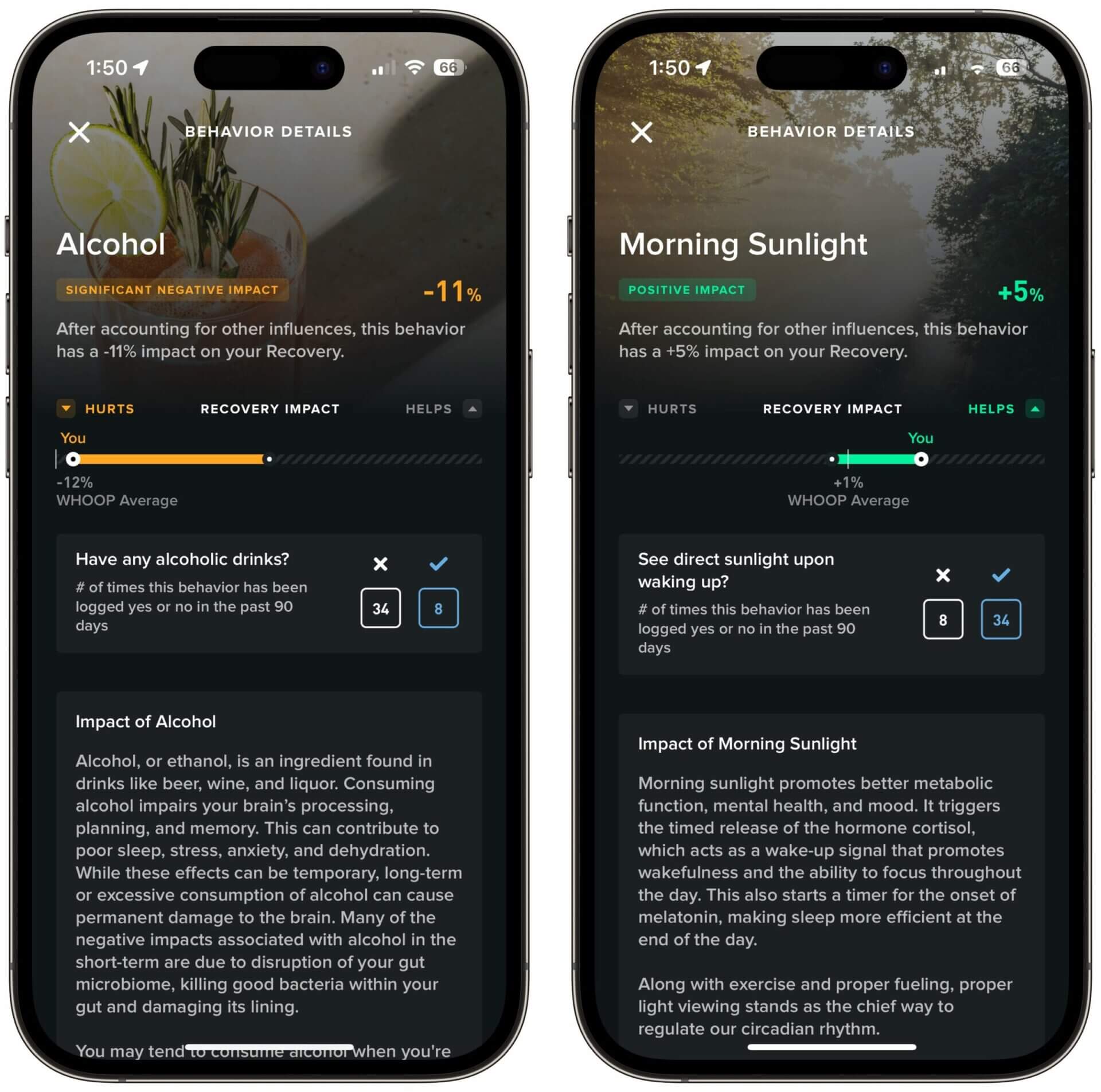
What’s interesting is that you can use the recovery score for much more than planning your next workout. For example, having a low recovery score for a few days in a row without an obvious reason (i.e., strenuous workout sessions) has been an incredibly reliable indicator that my body is fighting off a virus.
On the flip side, my recovery score improved immediately as soon as I started to feel better.

For example, the picture above shows my friend’s recovery scores in the week that she got diagnosed with COVID-19.
What I’m trying to say is that you can benefit from WHOOP even if you’re not an athlete!
What’s important to understand is that a low recovery doesn’t mean you should stay home instead of going to the gym, much like a green recovery score doesn’t mean you should go all-out if you know you have an important competition coming up in a couple of days.
WHOOP’s recovery score is merely a reflection of how your central nervous system is responding to the stimuli and lifestyle choices of the previous day(s). You can use that information, combined with how you feel and what you have planned for the coming days, to structure your training and exposure to stress.
Said differently, I’ve had days where I crushed a workout despite having a low recovery score, and days with a high recovery where I didn’t feel like my best.
On the flip side, listening to your body and taking heart rate variability (the core metric WHOOP uses to calculate its recovery score) into account has been shown in several studies to improve athletic performance, and cardiorespiratory fitness in particular.
One of the most useful features of WHOOP’s recovery tracking is the WHOOP Journal, because it enables you to answer a few questions every morning (about lifestyle choices and medical conditions) that WHOOP can then correlate with changes in your recovery and sleep scores.
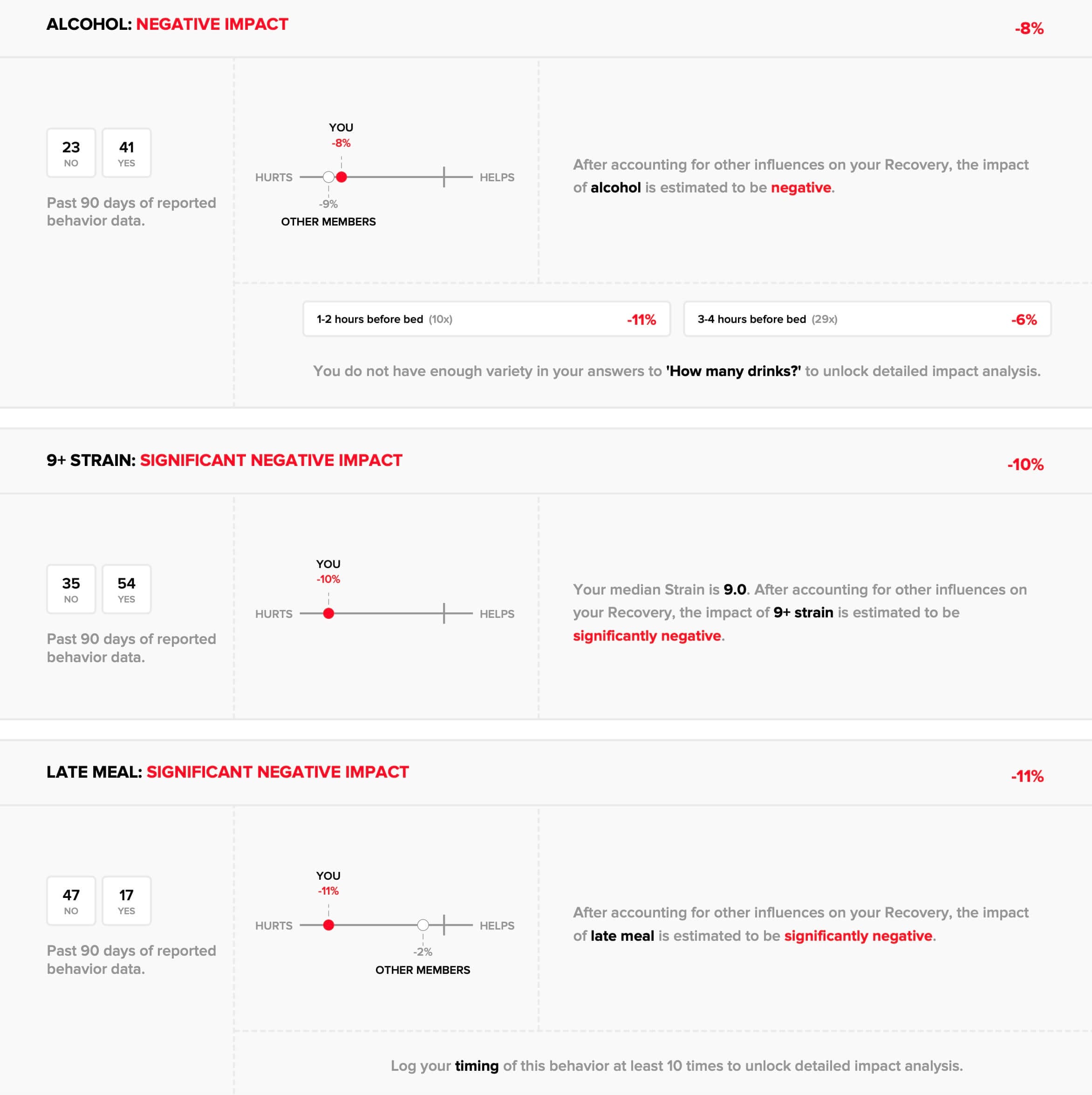
That’s how I found out, among other things, that eating a late meal negatively impacts my HRV and slow-wave sleep. I’ll cover the WHOOP Journal in more detail below, but in a nutshell, understand that it enables you to make better lifestyle choices to improve your sleep and recovery.
How Does WHOOP Know How Recovered I Am?
In a nutshell, the WHOOP analysis engine uses three key metrics to measure recovery:
- Resting heart rate (RHR).
- Heart rate variability (HRV).
- Quality of sleep.
A high heart rate variability and a low resting heart rate, compared to your baseline, indicate that your body is recovering well. A low HRV and high RHR indicate that your heart is working harder to supply nutrients via the bloodstream. It also means that your nervous system is busy trying to meet your body’s “physiological demands, such as musculoskeletal recovery, stress, illness, and fatigue” (source).
Of course, your sleep performance also plays a crucial role in recovery. The more quality sleep you get, the quicker you recover.
What’s important to understand is that the recovery score WHOOP calculates is not correlated with the previous day’s strain. In other words, a high strain score doesn’t necessarily lead to a lower recovery score if your body is able to handle the strain well.
WHOOP-Induced Anxiety
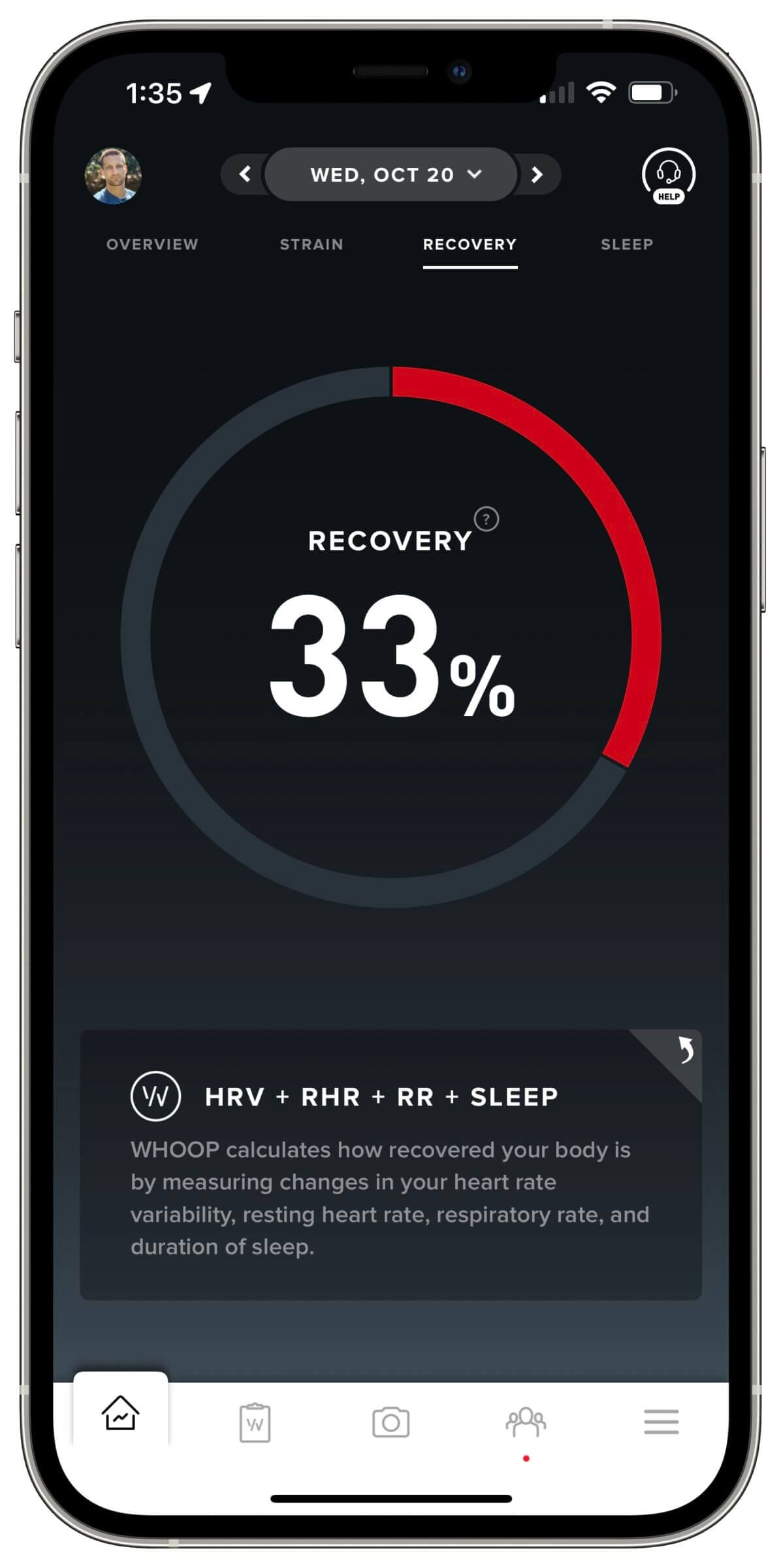
I’ve heard from several WHOOP members (including my wife when she first started wearing WHOOP) that they would get anxious when WHOOP reported a “red” recovery.
What’s important to understand is that being in the red isn’t necessarily a bad thing — much like being in the green all the time isn’t necessarily a good thing.
You have to see your recovery score in the context of what you’re trying to achieve. For example, if you’re trying to improve your fitness, you need to functionally overreach. In other words, you have to stress your body enough (i.e., incur muscle damage) to become stronger and fitter.
When you do, your body has to work hard to repair and recover, and you’ll end up with a yellow or red recovery score. That’s part of the process.
If you’re always in the green, you’re most likely not improving. So don’t get stressed out over your recovery score. Rather, take it as a clue of how your nervous system is adapting to stressors from the previous day.
On the flip side, you shouldn’t be in the red for two weeks in a row. If you are, you’re either overtraining or something else is going on that requires your attention.
Sleep Tracking
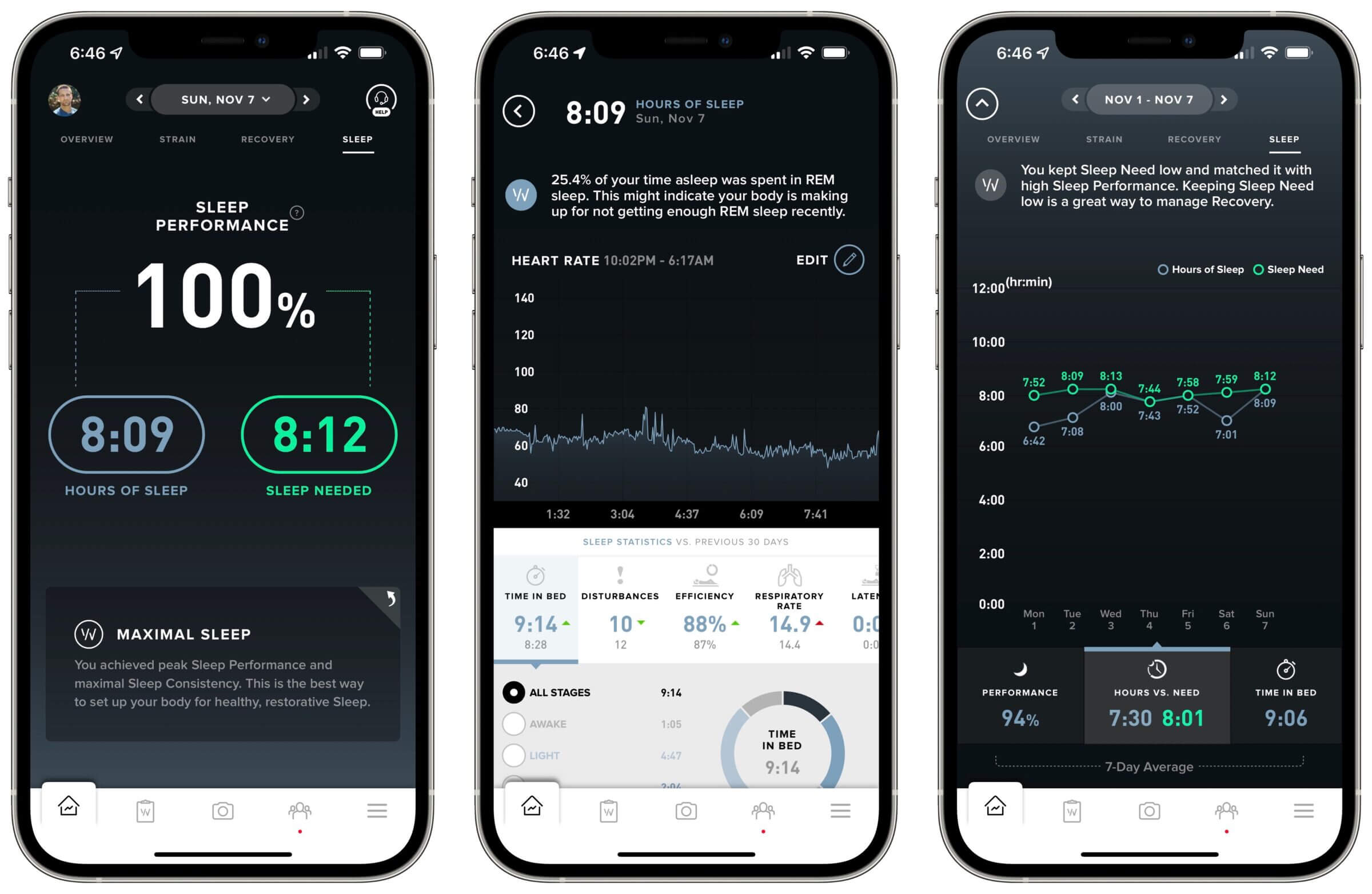
One of the features I was most excited about when I learned about WHOOP was sleep tracking. I had tried various apps and gadgets in the past, such as the now-obsolete Jawbone UP and Sleep++, but none were reliable.
Thanks to the advanced sleep monitoring technology in WHOOP, the device can not only measure how much time I spend in bed, but also how much time it takes me to fall asleep (sleep latency), how long I sleep, how much time I spend awake after sleep onset (WASO), and what stage of sleep I’m in.
A typical sleep cycle consists of four stages:
- Slow wave sleep (SWS, which is also known as deep sleep).
- REM sleep.
- Light sleep.
- Wake.
WHOOP uses its sensors to detect changes in my heart rate, the ambient temperature, electrodermal activity and movement patterns.
Every morning, I get a detailed report telling me how much time I spent in bed, how long it took me to fall asleep, how long I spent in each stage of sleep, and how many times my sleep was disturbed.
Additionally, you can also check your respiration rate (how many breaths you take per minute). That number should be relatively stable from night to night. If you see significant changes, it could indicate an underlying issue, such as a viral infection.
Sleep Efficiency
In February 2019, WHOOP launched a new sleep-related metric called Sleep Efficiency.
Sleep Efficiency is therefore a measure of sleep quality, and when considered alongside the rest of the WHOOP Sleep Pillar metrics, provides actionable insight into where your sleep could improve.
WHOOP
While sleep efficiency is an excellent metric to track, WHOOP also keeps tabs on wake time after sleep onset (WASO). That’s the amount of time I’m awake after falling asleep and an excellent indication of sleep quality.
How Accurately Does WHOOP Track Sleep?
According to WHOOP, their sleep metrics are 95% accurate compared to the calibration tests the company has done in sleep labs. The University of Arizona recently published a study on sleep trackers and called WHOOP “highly accurate.”
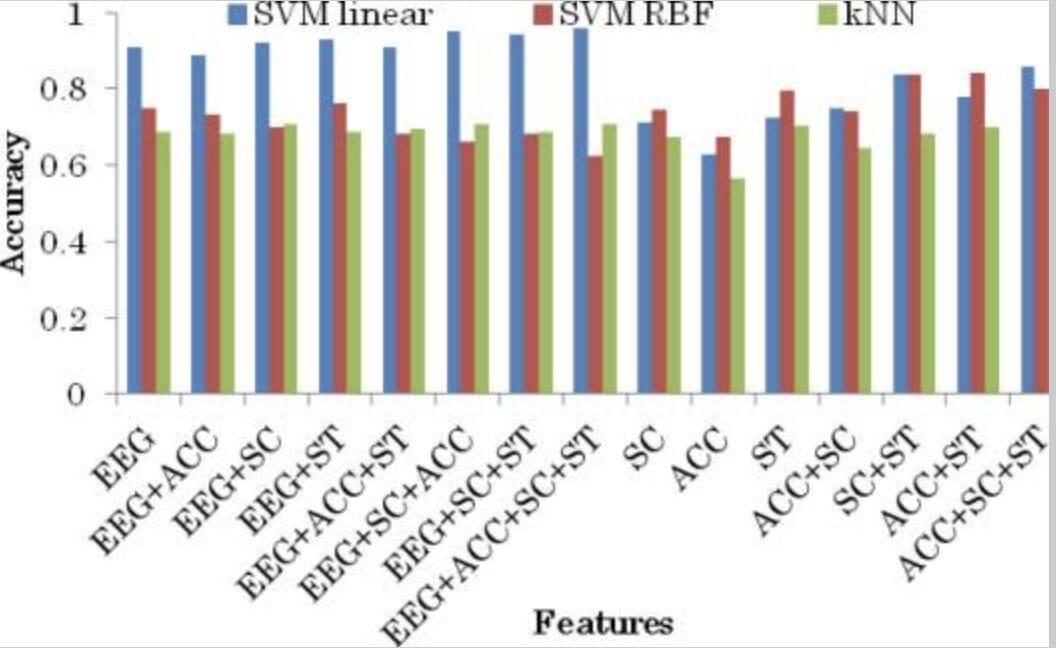
I have read numerous studies suggesting a relationship between an increase in electrodermal activity and skin temperature during slow-wave sleep. I found another study that outlined the accuracy of various monitoring devices, including electroencephalography (EEG), skin conductance (SC), skin temperature (ST) and accelerometers (ACC).
You can see the results below:
- EEG showed 91% accuracy.
- EEG plus other features boosted the accuracy to 95% (EEG + SC + ACC).
- EEG + ACC + SC + ST boosted the accuracy to 96%.
It shouldn’t be surprising that EEG-based monitoring is relatively accurate, especially when paired with additional (wrist-worn) sensors.
Note: The reason why even the gold standard of sleep tracking (EEG) isn’t 100% accurate is because brain-wave information is subject to interpretation by the medical professional analyzing the data.
However, even without an EEG, scientists have confirmed the relatively high accuracy of wrist-worn devices:
- ACC + SC + ST showed 86% accuracy.
- SC + ST or ACC + ST showed 84% accuracy.
So, based on those findings, I expect WHOOP to be about 86% accurate. From an observational perspective, I woke up feeling groggy a few times lately, and I always suspected that I must have been in the middle or at the end of a deep-sleep cycle.
The other day, I woke up in the middle of a dream (or at least that’s how it felt). More than that, I felt like I was dreaming the whole night, and I have vivid recollections of my dreams.
After each of those events, I compared my suspicions with WHOOP’s sleep performance report and it was always spot on.
What’s important to understand is that while most advanced sleep trackers, including WHOOP, are relatively accurate at differentiating between light sleep and deep sleep, they’re less accurate at differentiating between deep sleep and REM sleep.
That’s because these two restorative stages of sleep look relatively similar from the outside. That’s why you need an EEG to monitor electrical brain activity to get an accurate indication of REM sleep.
That’s one of the reasons why Biostrap decided to lump both deep and REM sleep into a single metric instead of trying to differentiate between the two.
Considering that the body spends as much time as it requires in either deep or REM sleep, I usually look at how much time I spend in both stages combined. As long as I’ve spent 40% or more of my total sleep in those two stages, I’m OK.
Sleep Coach and Silent (Smart) Alarm

In addition to my sleep performance report, WHOOP offers a sleep coach via its mobile app that suggests when I should go to bed based on my level of expected athletic performance the next day, the accumulated strain, any sleep debt I might have accrued, and how long it usually takes me to fall asleep.
Thanks to the haptic engine in the new WHOOP 4.0, you can also set non-audible alarms based on the following characteristics:
- Wake up once you’ve hit your sleep goal.
- Wake up once you’ve achieved a green recovery score.
I’ve set my WHOOP to gently vibrate when I’ve reached my sleep goal for the day, as suggested by the Sleep Coach. My sleep goal is set to “peak” or 100% of my sleep need. Once I’ve reached that, WHOOP wakes me up. If I don’t reach 100% of my sleep need by 6:30 a.m., WHOOP wakes me up anyway.
Of course, you can also set an exact time when WHOOP should wake you up. That’s useful, if you have an early flight to catch or an appointment in the morning you can’t miss.
What I’d like WHOOP to add is the ability to set your own sleep goal in hours and minutes. In other words, instead of relying on Sleep Coach, I’d like the option to be woken up once I’ve slept for 7 hours and 30 minutes (the amount of sleep I know I need on an average day).
Coincidentally, that’s pretty much in line with what Sleep Coach recommends anyway. However, my wife feels best with 8 to 9 hours of sleep — much more than Sleep Coach recommends. So in her case, she’d be better off having the ability to define custom sleep goals.
It’s worth noting you can create your own schedule to customize your wake time by day of the week.
Health Monitor

One of WHOOP 4.0’s most exciting new features is Health Monitor, which gives you a daily report of your five most important health metrics, including:
- Respiratory rate.
- Resting heart rate (RHR).
- Heart rate variability (HRV).
- Blood oxygen saturation (SpO2).
- Skin temperature.
Any deviation from the baseline of these metrics could be an indication of a potential health issue or lifestyle choice your body was struggling with during the night.
Blood oxygen and skin temperature are metrics exclusive to WHOOP 4.0, while the other three are also available with WHOOP 3.0.
For example, after having consumed two glasses of red wine relatively close to my bedtime, my resting heart rate increased to 60 beats per minutes (which is relatively high for me). As a result, I got a warning right on the home screen of the WHOOP app.
While I was already aware of the negative impact alcohol has on my biometrics and sleep quality, I consider the Health Monitor an invaluable tool for the early detection of infections.
Skin Temperature Monitoring
Skin temperature monitoring is a new feature of WHOOP 4.0, thanks to a new sensor that wasn’t present in the previous generation.
In a nutshell, monitoring skin temperature can give you insights into your sleep quality and overall wellness.
Additionally, if you menstruate, being aware of sudden increases in skin temperature can give you a heads up as to when your period is about to start.
What’s cool is that you can tell the WHOOP app (via the WHOOP Journal) if you’re sick or menstruating, so the algorithm can learn how these conditions impact your skin temperature. As a result, WHOOP can more reliably predict the onset of an illness or menstrual cycle in the future.
But that’s not all. WHOOP can also correlate skin temperature measurements with sleep quality and recovery scores. For example, if you’re too hot under the sheets, that might impact how fast you can fall asleep or how deep you sleep.
Your skin temperature may reflect that, which is one of the reasons why I use a mattress cooling solution to ensure I support my body by regulating its core temperature during sleep.
What’s important to understand is that your skin temperature is usually a bit lower than your core temperature. As a result, skin temperature fluctuates during the day, while your core temperature remains stable at around 98.6 degrees Fahrenheit (or 37 Celsius).
Blood Oxygen Monitoring
Keeping tabs on your blood oxygen saturation (SpO2) is a new feature that is made possible by the new blood oximeter built into WHOOP 4.0. Specifically, the new WHOOP now includes red and infrared LEDs and additional photodiodes to penetrate the skin deeper and to differentiate between oxygenated and non-oxygenated hemoglobin.
From a technical perspective, the light reflected by those hemoglobin proteins has a different wavelength depending on if they carry oxygen or not. That’s how WHOOP’s photodiodes can tell how much of your hemoglobin is oxygenated.
If you asked your doctor, he’d tell you that a normal blood oxygen saturation is between 95% and 100%, and a deviation from that can indicate a potential health issue. For example, if you suffer from snoring or sleep apnea, your SpO2 levels might drop below 95%.
However, I recently learned on a podcast with Dr. Paul Saladino that lower SpO2 levels of 90-95% are actually a sign of improved CO2 tolerance (an indicator of cardiovascular fitness) and that levels closer to 100% can be a sign of low CO2 tolerance. I regularly see SpO2 levels of 93-97% in my WHOOP app and started to wonder what was going on.
That said, it’s worth noting that SpO2 levels below 90% can be a sign of a problem. For example, I’ve heard reports of low oxygen saturation in patients who were diagnosed with a respiratory infection, such as pneumonia or COVID-19.
Last but not least, monitoring blood oxygen saturation is useful for athletes who train in high-altitude conditions. I’m currently training with LiveO2, an oxygen deprivation system that mimics high altitude to improve my cardiorespiratory fitness and red blood cell count.
In other words, it’s important to monitor blood oxygen saturation at night to detect potential health issues before they lead to more severe problems.
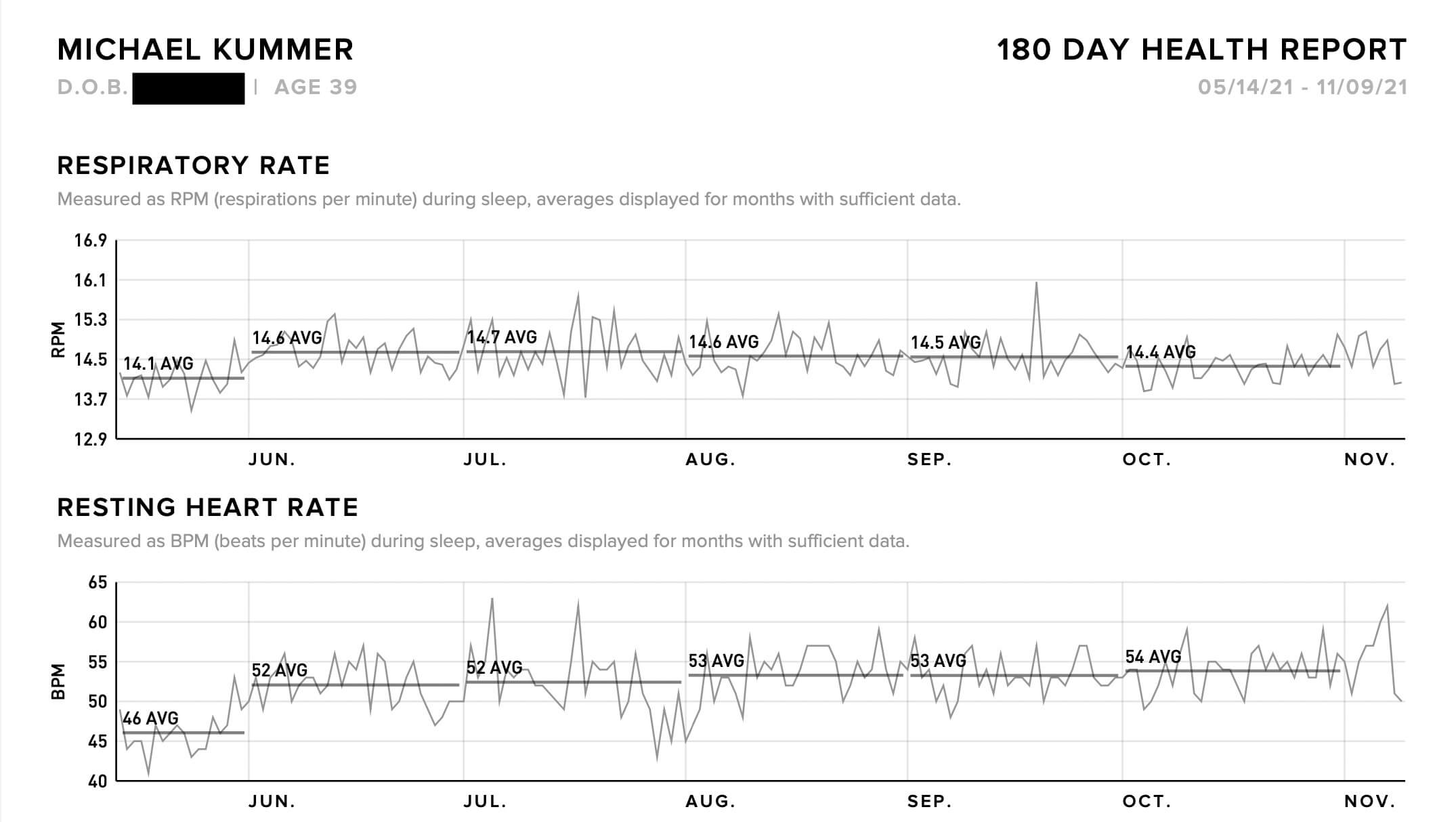
What’s cool is that you can share your 180-day health report with your doctor, physician, trainer or anyone of your choosing directly from within the app.
Note: Read my LiveO2 review and learn more about the benefits of altitude and intermittant hypoxic training.
Stress Monitor
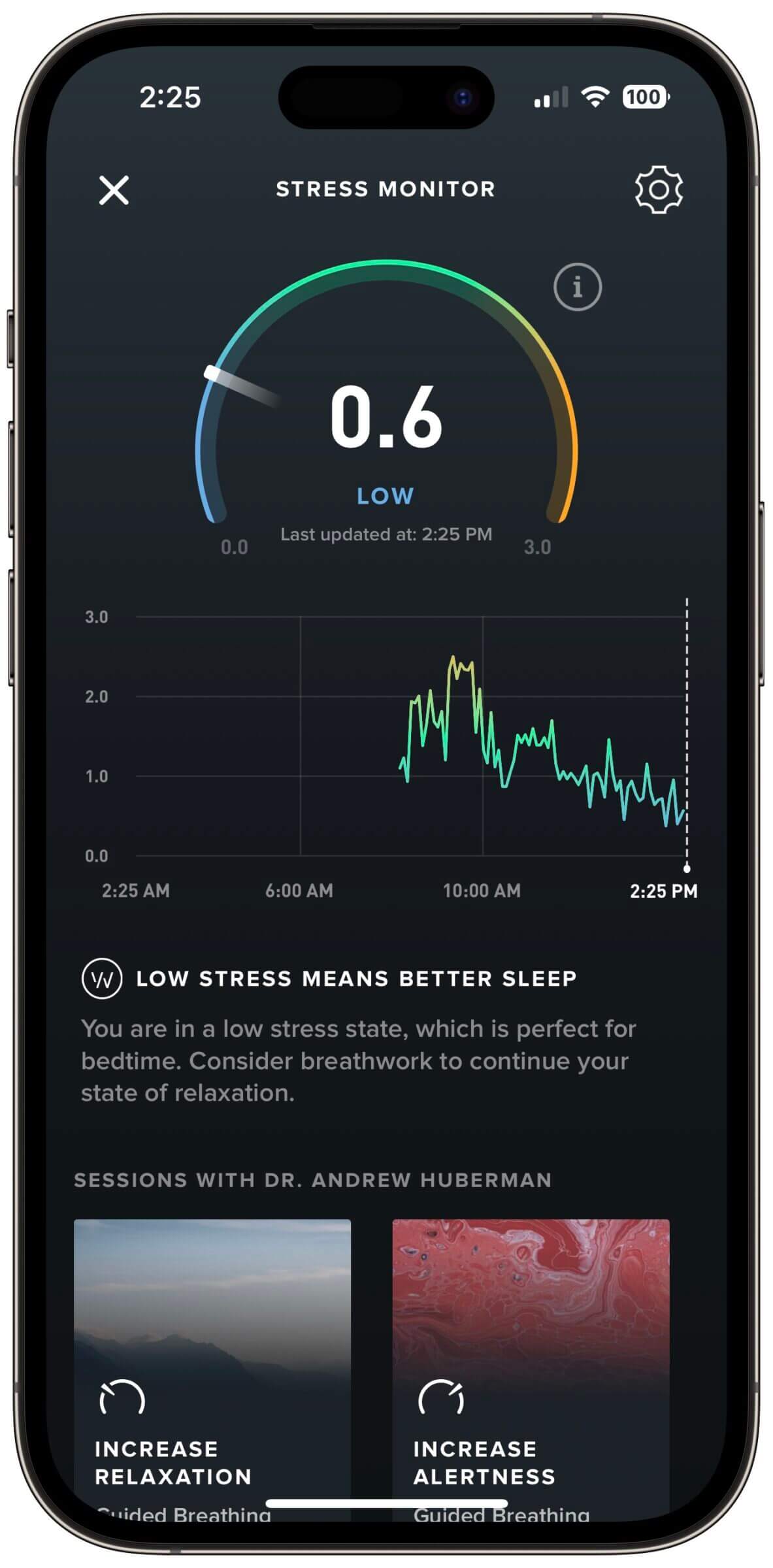
In April 2023, WHOOP introduced a stress monitor feature that I had been testing as part of a beta program for a few weeks leading up to the official launch.
What’s cool about this feature is that it gives you real-time information about how stressed you are based on relative changes to your heart rate and heart rate variability (HRV), compared to your baseline.
WHOOP’s stress score goes from zero to three, with zero indicating no stress and three indicating high stress. Based on your individual stress score, the WHOOP app recommends science-backed breathing sessions that the company developed in partnership with Dr. Andrew Huberman, a neuroscientist and one of my favorite biohackers.
In addition to providing a real-time stress score, you can also get a daily summary of your cumulative stress.
One thing worth noting is that WHOOP can’t differentiate between good or bad stress, or between physical or mental stress. It simply measures how “activated” the sympathetic branch of your nervous system is.
For example, it’s perfectly normal (and healthy) to show a stress response during and after intense exercise, or in the middle of an important presentation at work. After all, our stress response helps us perform optimally.
However, if your stress levels are constantly elevated, you’re likely dealing with chronic stress, which is detrimental to your health. WHOOP can help you keep tabs on that and suggest counter-measures in the form of breathing exercises.
During my testing, WHOOP’s stress monitor has been spot-on. My wife has also been testing the feature and has discovered that parenting is her number one contributor to elevated stress levels.
WHOOP Application
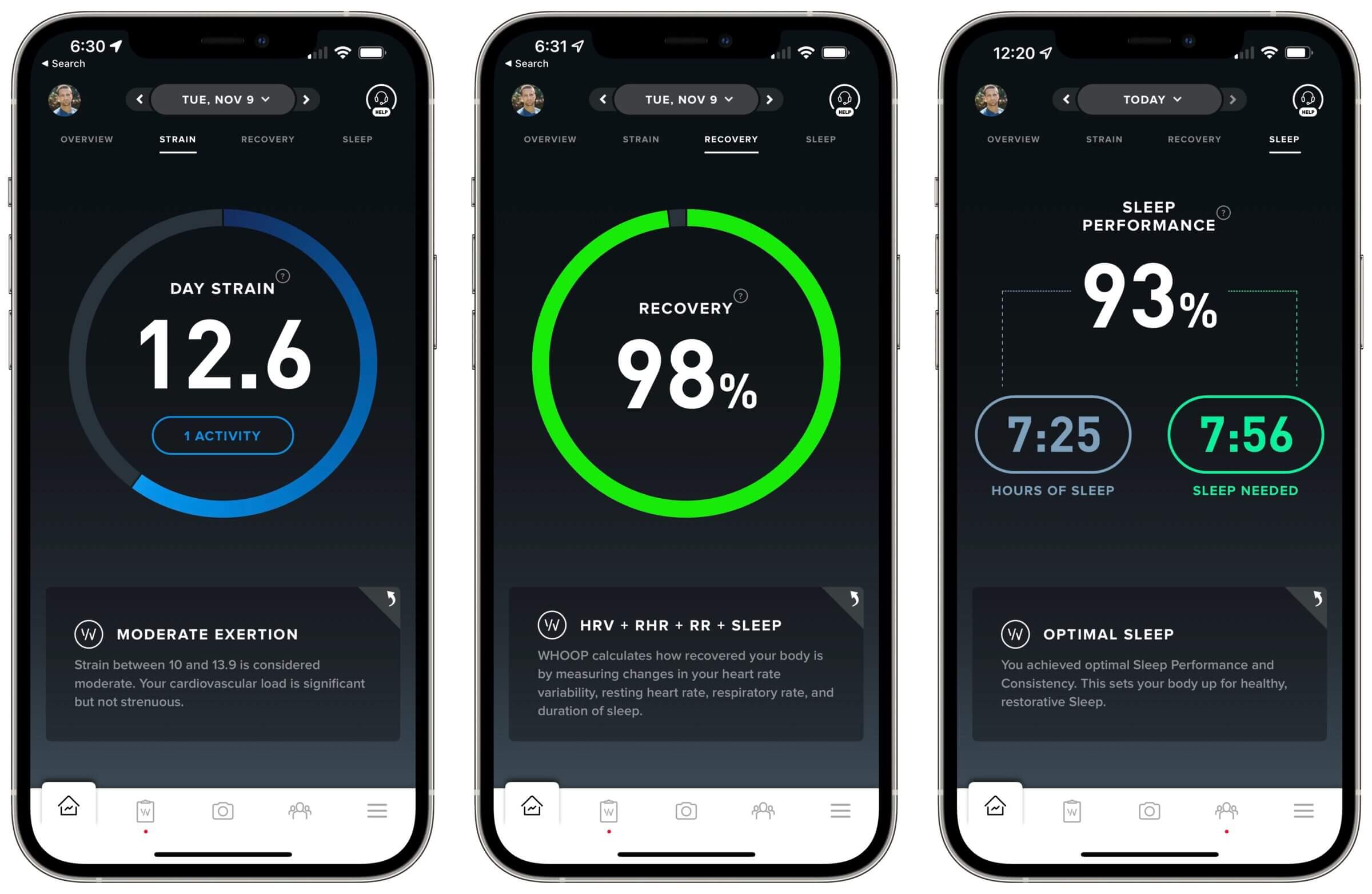
The WHOOP app offers a treasure trove of information, and you might find it intimidating at first.
That’s because the WHOOP app supports various input options, including taping and swiping to reveal different information. I admit that doesn’t always make it easy to find what you’re looking for. But once you get the hang of it, navigating the WHOOP app becomes second nature.
Here are a few examples of how you can navigate the home screen:
- Swipe up to reveal a graphical representation of your weekly strain and recovery scores.
- Swipe left and right to toggle between the overview, strain, recovery and sleep screens.
- Tap on any recorded activity to reveal more details. For example, tapping on the recorded sleep activity jumps directly to the sleep screen.
Today View

The home screen offers you an excellent overview of your most important metrics, including:
- Recovery score.
- Day strain.
- Heart rate variability.
- Calories burned.
- Any detected activities, including sleep, naps or workouts.
- Health Monitor.
- Battery life and cloud connectivity status.
You can also manually log an activity right from the home screen, or edit your WHOOP Journal entries.
As mentioned above, you can swipe left and right to switch between different “Today” views, including the home, strain, recovery and sleep screens.
On each of those screens you can swipe up to get a graphical representation of your data that spans multiple days.
In addition to the weekly trends, the WHOOP app also now gives you insights into your monthly trends. That’s useful to see the bigger picture of how your metrics change over time. The monthly trend view is available for the following metrics:
- Day Strain
- Average Heart Rate
- Calories
- Recovery
- Heart Rate Variability
- Resting Heart Rate
- Respiratory Rate
- Sleep Performance
- Hours vs. Need (Sleep)
- Time in Bed
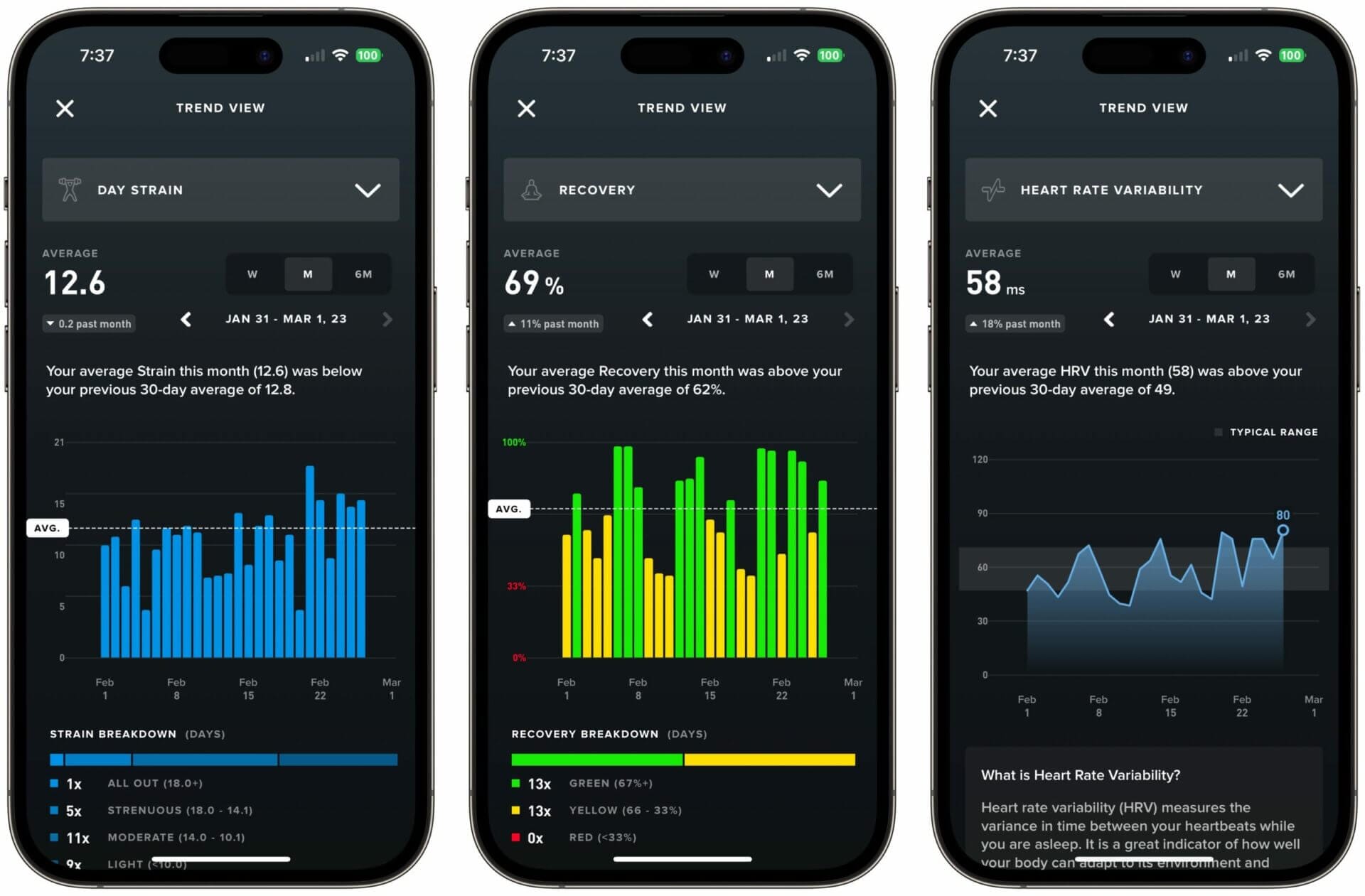
Athlete Profile
You can access your athlete profile by clicking on your profile image in the upper left corner of the home screen. In addition to allowing you to update your personal settings (e.g., name, birthday, gender, etc.) you can also change your profile picture, weight and height.
Additionally, you can get an overview of your key metrics from the last 30 days, as well as some all-time stats. Examples include the number of recoveries you logged using WHOOP; your average strain, HRV and RHR; your recent activities; and your sleep performance.
Shortcuts (Menu Bar)
On the bottom of the screen inside the WHOOP app, you can see a couple of icons that represent shortcuts to commonly used functions.
The first icon gets you back to the home screen from anywhere in the app. The second icon is a shortcut to WHOOP’s coaching features, including the strain and sleep coach (which we’ll discuss further down).
From within the coaching section, you can also access your weekly and monthly performance assessments, which provide you with an overview of how your lifestyle choices (as tracked by the WHOOP Journal) have influenced your sleep and recovery over the past week or month.
The camera icon in the middle of the menu bar opens WHOOP Live, a feature that allows you to record workouts while overlaying your heart rate, strain, calorie, recovery and sleep information.

It’s a fun way of recording short workout videos and publishing them on social media.
The community icon allows you to create or join teams of fellow WHOOP owners and to share strain, recovery and sleep metrics with them. I don’t use WHOOP teams a lot but I’m a member of several teams and enjoy sharing my WHOOP data with family members and close friends from my CrossFit box.

A relatively new addition to WHOOP Teams is the ability to exchange images and messages via the built-in chat function.
Application Menu
The application menu is the fifth and last icon in the menu bar and it enables you to make changes to your WHOOP account, change activity detection settings, explore app integrations with Strava or TrainingPeaks, update the Strap’s firmware and more.
Strain Coach
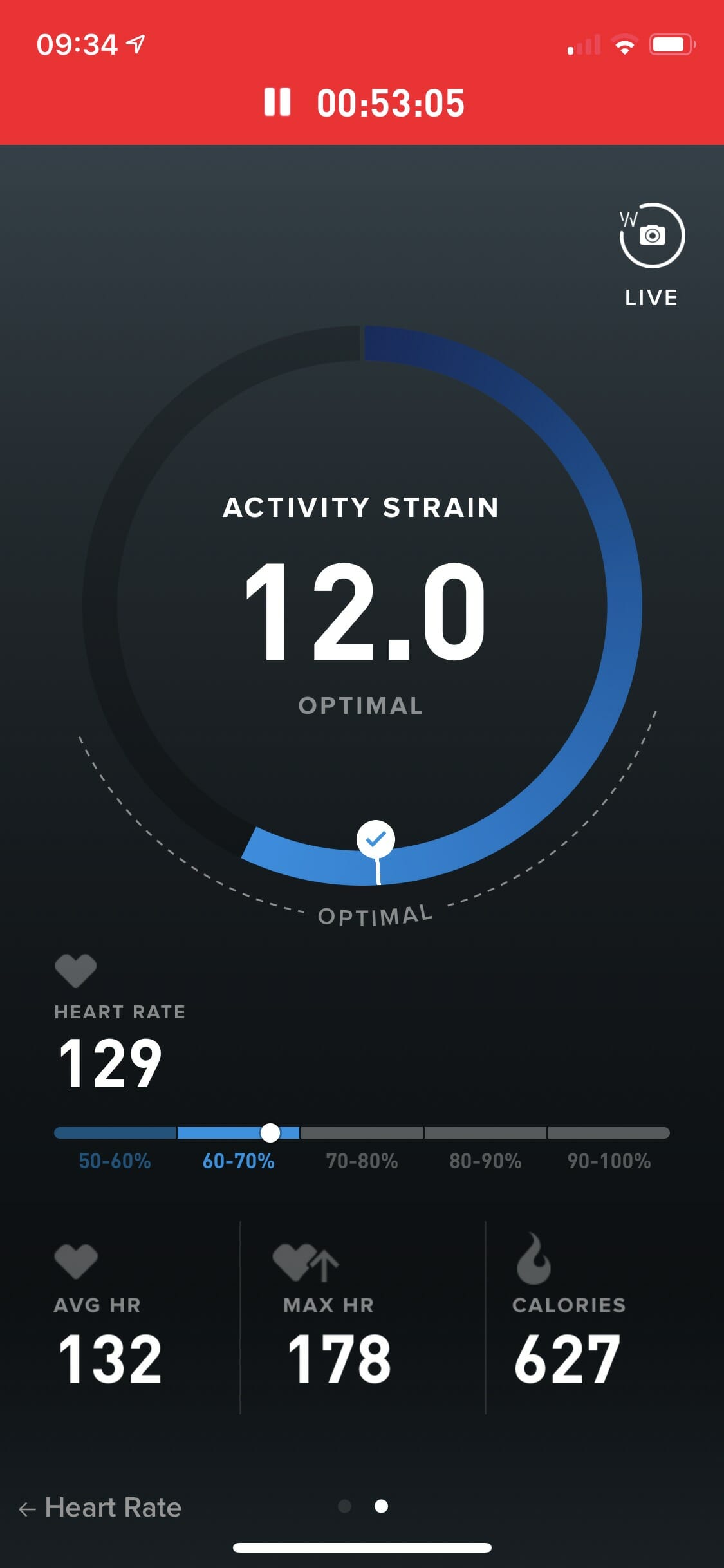
Strain Coach provides you with live data — including your strain, heart rate and calories burned — that you can leverage during a workout. That way, you can make instant adjustments to your workout activity, based on your recovery.
I used Strain Coach just once (to see how it works), because I don’t think it adds any value to my exercise regimen. I usually plan my workouts based on how I feel on a given day. More importantly, WHOOP isn’t good at tracking strain for the type of workouts I perform, as I noted earlier in this article.
If you’re new to fitness and recovery tracking and predominantly perform cardio-types of exercises, I think Strain Coach can be a valuable tool to avoid overtraining.
Some reviewers are under the impression that Strain Coach can or should replace a real coach. Obviously, that’s an unrealistic expectation — much like it’s unrealistic for a Tesla to operate entirely autonomously. Maybe we’ll get there at some point, but we aren’t there yet as of this writing.
So if WHOOP’s Strain Coach suggests that you push it hard during a workout on a given day, but you know that you have a race coming up, maybe don’t follow the recommendation and use your brain instead.
Sleep Coach

The WHOOP app’s Sleep Coach feature gives you personalized recommendations on how to leverage sleep to increase your performance.
To get started, you can tell Sleep Coach what level of performance you’re aiming for, including “peak,” “perform” or “get by.” I always go for “peak” performance!
Additionally, you can tell the app what your desired wake-up time is. In my case, that’s 5:30 a.m. From there, Sleep Coach tells you when you should go to bed and how many hours of sleep you’ll need.
Regardless of your desired wake-up time, Sleep Coach also tells you when you should go to bed and when you should wake up for maximal sleep consistency and to achieve 100% of your sleep needs.
When I first installed the app, I didn’t know that I could choose my desired performance level and wake-up time, and was surprised when Sleep Coach suggested a bedtime that was much later than I was used to.
Some people get discouraged when WHOOP suggests earlier-than-expected bedtimes or a much higher-than-anticipated sleep need. But based on everything I know about how WHOOP calculates your sleep need (and based on my personal experience), I think you should follow WHOOP’s recommendations.
In many cases, extensive strain and sleep debt cause a much higher sleep need than you might like. However, it’s important to reduce your sleep debt by sleeping longer — otherwise, you’ll never reduce it.
While I’ve never seen WHOOP overestimate my sleep need, my wife’s WHOOP 3.0 keeps telling her that she sleeps too much. But she feels better and more rested by sleeping longer than what WHOOP recommends.
WHOOP Journal
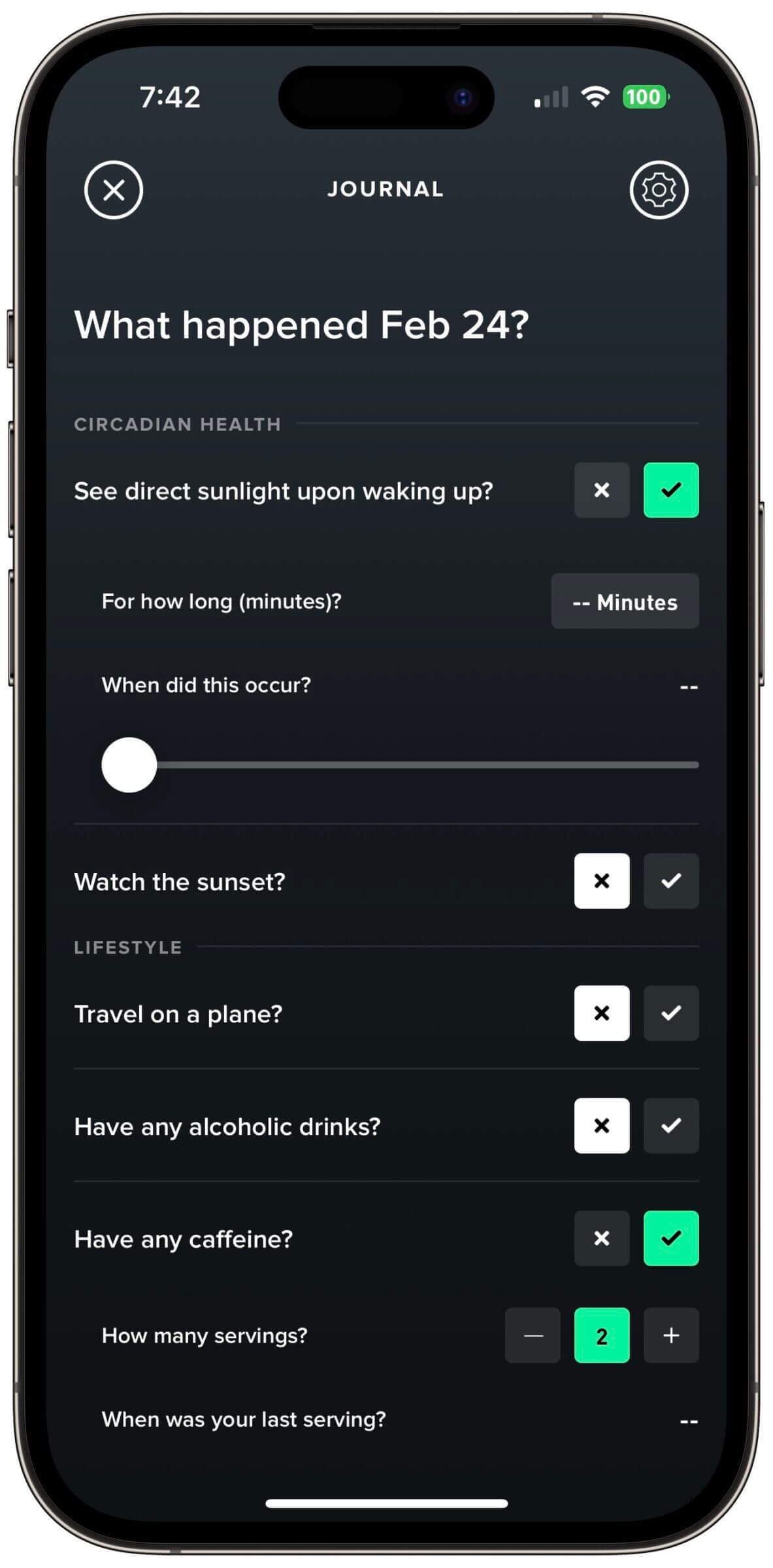
The reason the regular performance assessments are so useful is that they give you an indication of what lifestyle factors might have impacted your recovery and sleep scores.
For example, by answering a few simple questions every day, WHOOP can tell you how alcohol use impacts your sleep performance and/or resting heart rate.

While the first iteration of the WHOOP app wasn’t incredibly granular in collecting that important information, newer versions allow you to select only the questions you want the app to ask you. Additionally, you can also tell the app exactly how much alcohol you had (and when you had it).
Overall, the app knows dozens of behaviors, from the consumption of your last paleo meal to air travel and everything in between. Plus, WHOOP keeps adding new journal entry “behaviors” every couple of months.
I absolutely love the granularity and I can’t wait to see the results as part of my next performance assessment.
What I’d really like to see is the ability to add custom journal entries. For example, if I try a new sleep supplement, I’d love to log that using the WHOOP Journal. Unfortunately, WHOOP doesn’t allow that.
I assume the reason is data consistency, so that WHOOP can continue aggregating journal information across its entire user base to fine-tune its algorithm and better understand how certain behaviors impact users.
WHOOP Performance Assessment
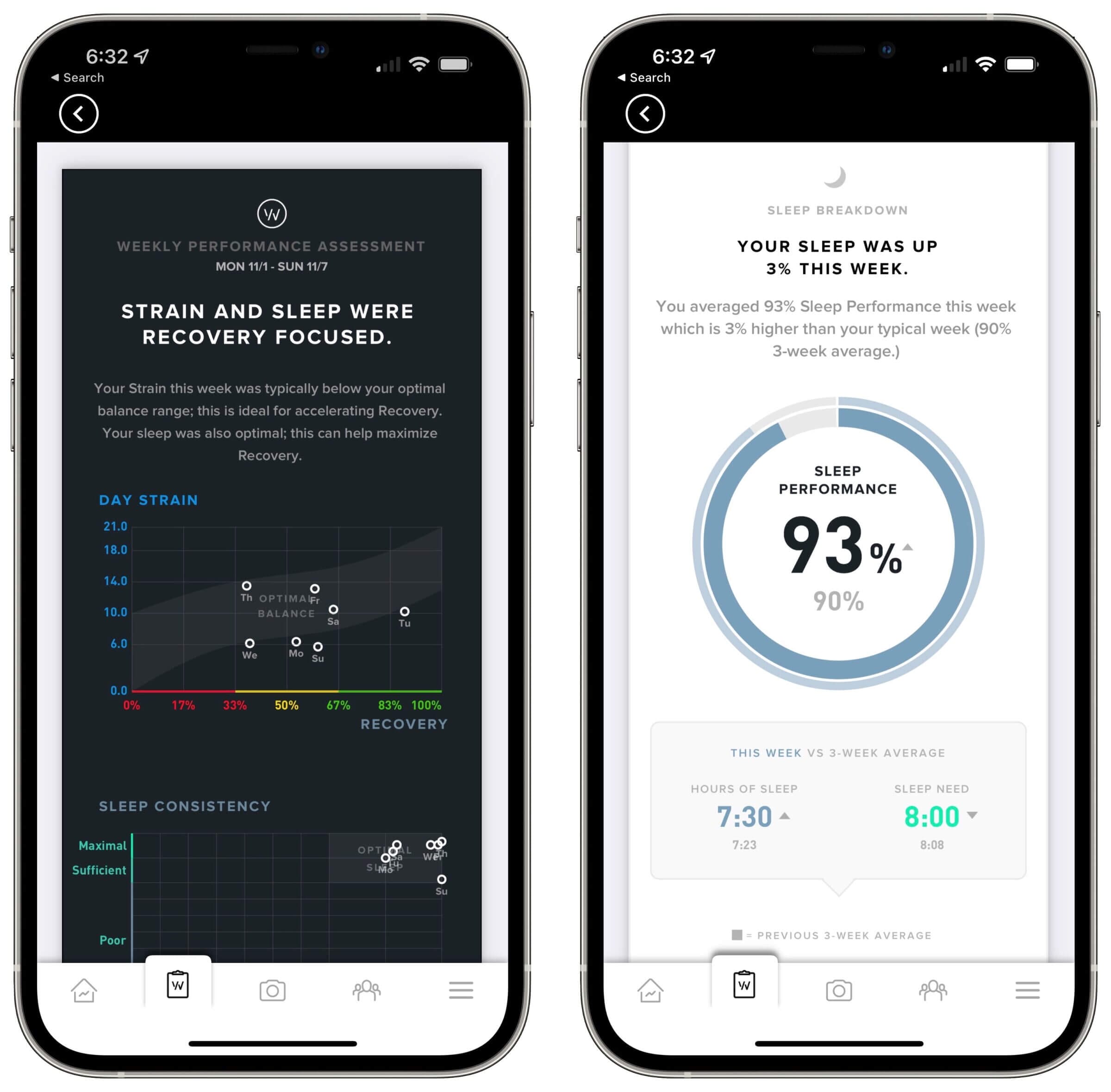
Once you’ve worn your WHOOP tracker for 28 consecutive days, you’ll get a weekly performance assessment. The report visualizes your current training state based on your daily strain, your rate of recovery, and your sleep performance. You’ll also get an indication of how you compare to other members of the WHOOP community.
My first weekly performance assessment report told me that both my training state and sleep performance were optimal. However, my daily strain was 8% lower than the average male WHOOP user in the 35-50 age bracket. (That’s likely because of the factors I’ve mentioned several times throughout the article.)
In addition to the weekly performance assessment, WHOOP also offers a monthly (and even a yearly) report that turns a huge volume of data into actionable insights.


WHOOP Pricing and Discount Code
When the WHOOP fitness tracker first launched, it had a hefty $500 price tag. While that’s in line with what I paid for my Apple Watch, it’s still a lot of money.
These days, you don’t have to pay for the hardware up-front. Instead, you can sign up for a WHOOP membership in the form of a monthly or annual subscription.
- Monthly membership: $30 per month.
- Annual membership: $219.08 (used to be $239.00).
- 24-month membership: $382.38 (used to be $399.00).
- Lifetime membership: $399 one-time payment (only available to founding members).
If you’d like to give WHOOP a try, you can use the link below to get a free one-month trial. If you decide to keep your membership, you’ll also get one free month added to whichever subscription you choose.
Note that if you opt into the one-month free trial, you’ll receive a pre-owned WHOOP device. If you’d rather get a brand new device, you have the option to skip the free trial and just sign up for your preferred membership (and you’ll still get a free month added to your subscription).
I know there are pros and cons to WHOOP’s subscription model vs. paying for the hardware up-front. Based on my experience over the past three years, I can say that WHOOP has constantly improved the platform for its paying members. In other words, I’ve gotten a lot of value out of my membership. Additionally, hardware upgrades are free. As a result, I consider the WHOOP membership model a win-win for both the company and its customers.
In case you’re wondering, WHOOP is not available on Amazon.
WHOOP 3.0 vs. WHOOP 4.0

If you’re still using WHOOP 3.0, you might be wondering if it’s worth upgrading to WHOOP 4.0. Considering what I told you about the cost of upgrading above — it’s free if you have six or more months left on your current membership — I see no reason why you shouldn’t get the new Strap.
| WHOOP 2.0 | WHOOP 3.0 | WHOOP 4.0 | |
|---|---|---|---|
| Battery Life | 2 Days | 5 Days | 5 Days |
| Bluetooth LE | ✘ | ✔️ | ✔️ |
| Band | Tecnica | ProKnit | SuperKnit |
| Pulse oximeter | ✘ | ✘ | ✔️ |
| Skin temperature | ✘ | ✘ | ✔️ |
| Green LEDs | 2 | 2 | 3 |
| Red/IR LEDs | 0 | 0 | 2 |
| Photodiodes | 1 | 1 | 4 |
| Sensor size | Large | Large | Small |
| Battery Pack | Not waterproof | Not waterproof | Water-resistant |
| Easily swap bands | ✘ | ✘ | ✔️ |
| WHOOP Body Support | ✘ | ✘ | ✔️ |
Compared to the previous generation device, the new WHOOP 4.0 takes up less room on your wrist (something everyone with smaller wrists ought to appreciate). It packs additional sensors to enable more comprehensive health monitoring. And the battery pack is finally water-resistant, so you won’t damage it when you (accidentally) take it into the shower with you.
Additionally, WHOOP has made it super easy to swap bands, thanks to the new Fast Link system. With previous generations of WHOOP, swapping bands was a little bit of a pain. Plus, many users (including yours truly) often weaved the band through the loop of the sensor incorrectly, resulting in potential reliability issues.
So I’m thrilled that WHOOP introduced a slider mechanism that makes it incredibly easy to swap bands. I usually wear my strap until it’s so dirty that it has to be replaced anyway, but others (e.g., my wife) prefer using different band colors for different occasions. If you fall into the latter category, you’ll appreciate the Fast Link slider!
Is WHOOP 4.0 More Accurate than WHOOP 3.0?
A question that’s on the mind of many current WHOOP 3.0 owners is whether the new sensor is more accurate than the old one. In theory, WHOOP 4.0 should be more accurate than WHOOP 3.0 because of the additional LEDs and photodiodes. But how does that translate into real-life accuracy?
We see on average across all of the different activities we collected on (over 30 different types) on over 20k data sets a 10% improvement [in accuracy]. We also saw a significant reduction in “outliers” – or really bad data spikes/data points. We saw particular improvements with cycling and weightlifting.
WHOOP
To find out, I wore both WHOOP 3.0 and WHOOP 4.0. Here are my findings.
Sleep Tracking Accuracy
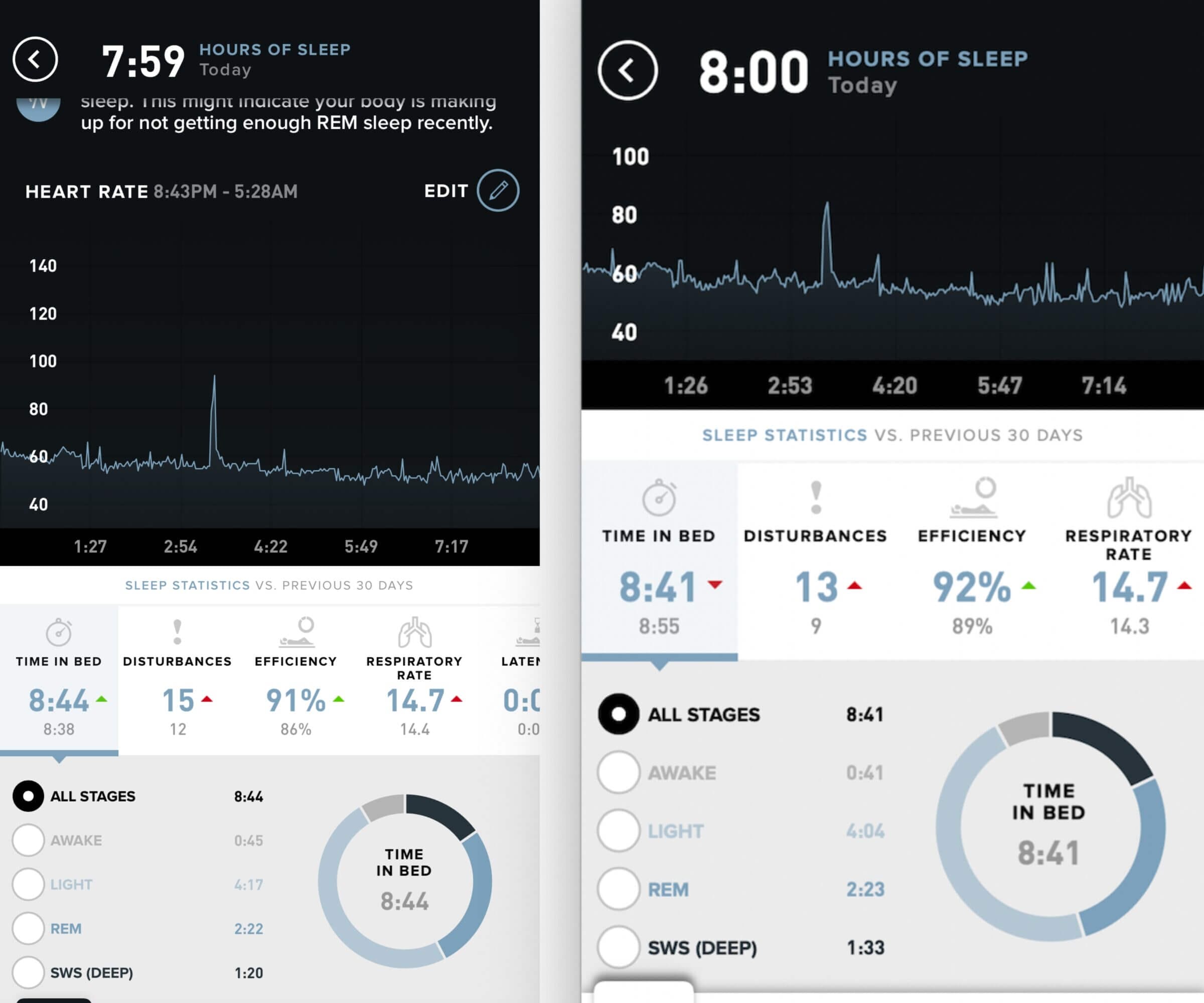
You can see in the table below that both generations of WHOOP reported relatively similar results when it came to sleep tracking. However, I’ve seen a trend of WHOOP 3.0 reporting more time asleep and time spent in various stages of sleep than WHOOP 4.0. I don’t know for certain which sensor is right, but I’m leaning towards WHOOP 4.0 just based on my own assessment.
| WHOOP 3.0 | WHOOP 4.0 | |
|---|---|---|
| Total sleep | 9:18 | 9:14 |
| Awake | 1:17 | 1:31 |
| Light | 4:03 | 3:50 |
| REM | 2:14 | 2:13 |
| SWS (deep) | 1:44 | 1:40 |
| Disturbances | 7 | 9 |
The comparison table above shows an example of WHOOP 3.0’s potential over-reporting. In case you wonder why I’m awake for more than an hour every night, it’s because we recently got a German shepherd puppy who still needs to pee once or twice a night.
Recovery Tracking Accuracy
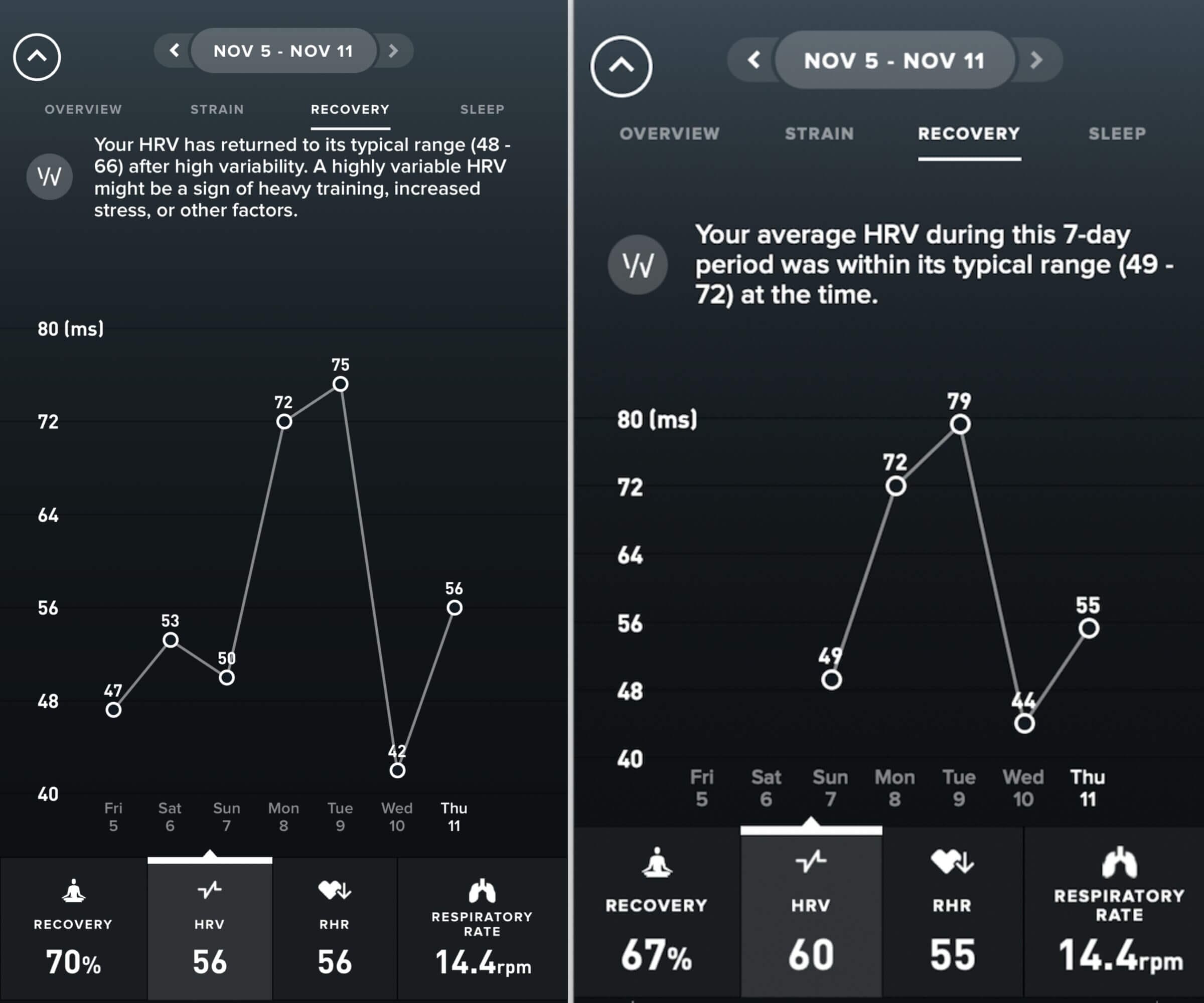
Considering that WHOOP’s ability to accurately capture heart rate data at rest (i.e., without movement involved) has always been excellent, I didn’t expect any major differences in recovery tracking.
| WHOOP 3.0 | WHOOP 4.0 | |
|---|---|---|
| Heart rate variability | 72 | 72 |
| Resting heart rate | 51 | 51 |
| Respiratory rate | 13.9 | 14 |
As you can see, the data captured by the devices is pretty consistent. During some nights, I noticed a difference in HRV of 1 ms, but that was likely due to differences in capturing time. Remember, WHOOP captures HRV during the last five minutes of deep sleep. Any variation in detecting deep sleep between the two sensors would explain a slightly different HRV.
Activity Tracking Accuracy

My first workout while wearing both WHOOP sensors was a recovery bike ride on CAROL. I didn’t even think about logging that activity (I wanted to wait for my next CrossFit workout instead). But coincidentally, both sensors automatically detected the bike ride, and logged it.
| WHOOP 3.0 | WHOOP 4.0 | |
|---|---|---|
| Calories | 286 | 283 |
| Avg HR | 135 | 135 |
| max HR | 155 | 155 |
| Duration | 28:36:00 | 28:35:00 |
As you can see, the sensors recorded pretty much the same data as far as heart rate and calorie burn are concerned.
Then it was finally time for a CrossFit workout…
| WHOOP 3.0 | WHOOP 4.0 | |
|---|---|---|
| Calories | 416 | 532 |
| Avg HR | 125 | 125 |
| max HR | 154 | 168 |
| Duration | 0:53 | 1:05 |
| Strain | 9.6 | 11 |
As you can see, there is a significant difference in the data reported by the devices.
Based on my experience with WHOOP tracking my heart rate during CrossFit workouts, and previous data captured by chest straps, I’d say that WHOOP 4.0 is much better at reflecting my actual heart rate during those challenging workouts.
For example, I’m convinced that my heart rate during the workout in question was much higher than 154 (what WHOOP 3.0 reported) — just based on how exhausting it was and how heavy I had to breathe. As a result, I firmly believe that WHOOP 4.0 more accurately captured my HR data, calorie burn and cardiovascular strain.
That’s great news because, frankly, I didn’t expect improved data collection!
Over the next few weeks, I’ll do more side-by-side comparisons between WHOOP 4.0 and my Polar chest strap to see how aligned those devices are. I’ll make sure to update this review and my “how accurate is WHOOP” article.
What’s Missing in WHOOP 4.0
While I’m excited about all the new features introduced in WHOOP 4.0, there are still a few things missing that could improve the overall platform.
Specifically, I’m referring to…
- Support for third-party chest straps (for even more accurate HR monitoring).
- The ability to enter my basal metabolic rate (BMR).
- Airplane mode.
Integration with Apple Health.
My number one request for WHOOP is to support airplane mode to reduce my exposure to EMFs while I’m sleeping. All the other fitness trackers I own already support airplane mode, including Oura, Biostrap and my Apple Watch Ultra. WHOOP is the only holdout (and the reason why I wear WHOOP on my ankle these days).
What I’d like to see is a smart implementation of airplane mode that gets enabled automatically when WHOOP detects that I’m sleeping and disabled automatically when I’m awake. That way, I wouldn’t have to do it manually like I have to with my Oura Ring and Apple Watch.
I’d also like to see additional integration with third-party platforms, such as Levels Health (continuous blood glucose monitoring) and Eight Sleep (my temperature-controlled smart mattress).
Customizable WHOOP Journal entries would also be a welcome addition because it would enable me to correlate new supplements, medication or lifestyle choices (that aren’t currently covered) with improvements in sleep quality and recovery.
Last but not least, live HRV monitoring would be cool, so I could see how deep breathing or meditation impacts my HRV.
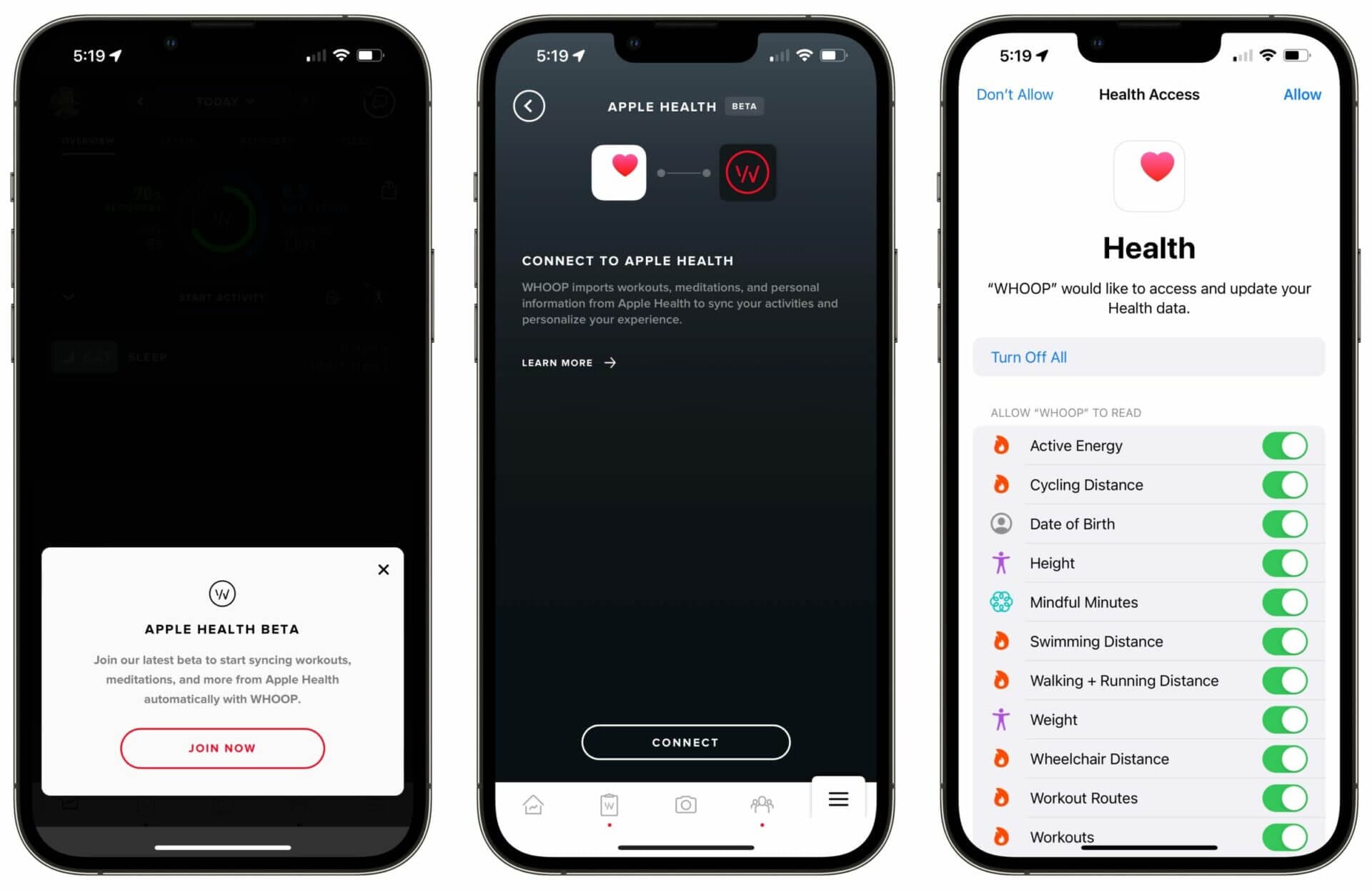
Update: After months of begging WHOOP to integrate with Apple’s HealthKit, the company has released exactly that. Orginally, WHOOP only supported reading information (i.e., Mindful minutes) from HealthKit, but the ability to write data to HealthKit was added in March 2022. You can learn more about WHOOP’s integration with Apple Health in this knowledge base article.
WHOOP Accessories
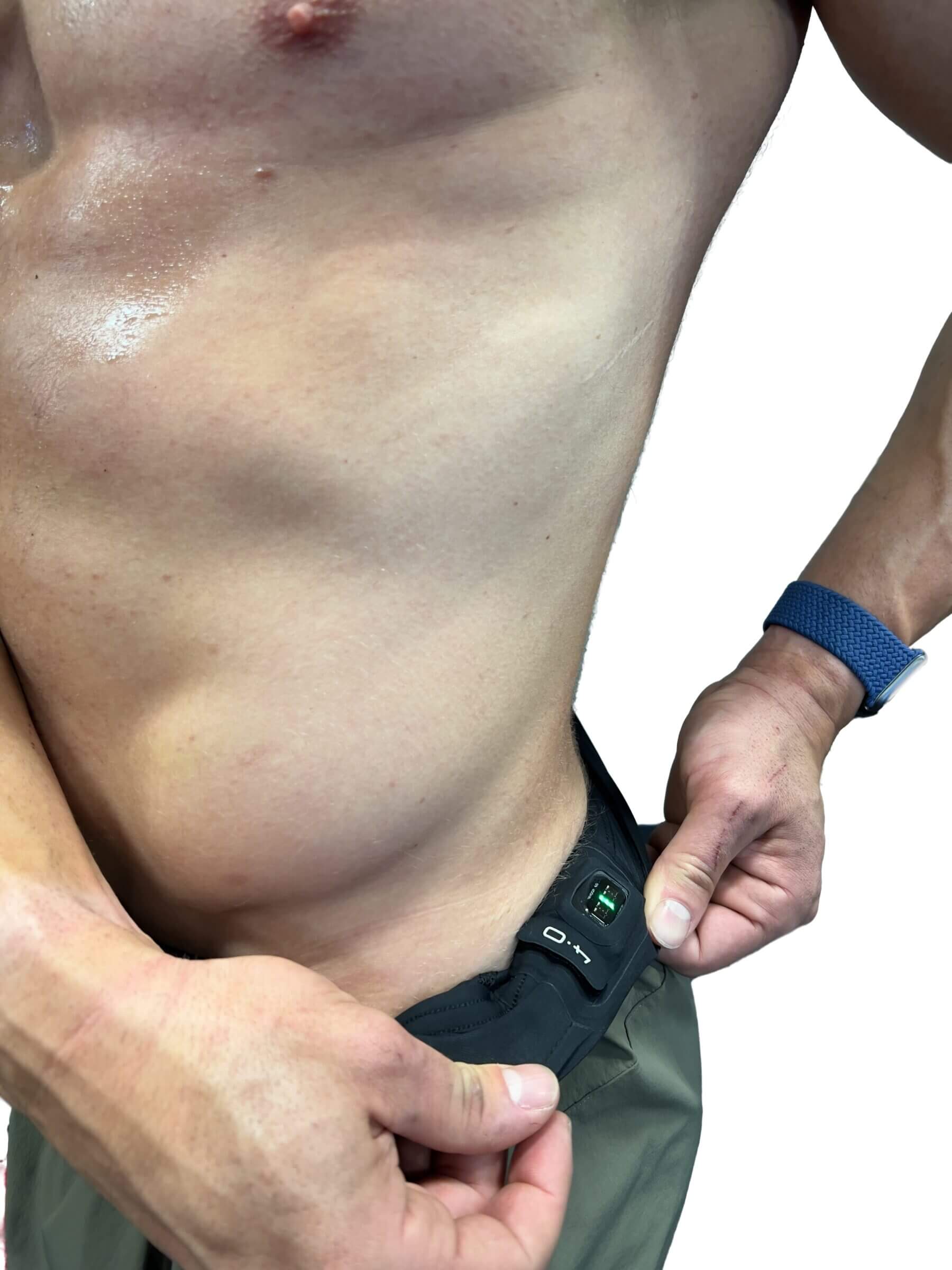
In addition to various strap designs and colors, WHOOP also offers several accessories you might find useful, including a bicep strap, a biceps sleeve and a Hydrosleeve (for athletes who compete in water sports).
However, I’m most excited about WHOOP Body, a new line of activewear that features built-in pockets that allow you to wear the WHOOP sensor on your hip or upper arm.
That’s useful for exercises that make it difficult to wear something around your wrists, such as boxing or other forms of martial arts. Other examples include NFL players who might be prohibited from wearing a wrist strap for safety reasons.
While I’ve tried both the bicep strap and sleeve (and found them useful for certain CrossFit workouts that include dumbbells, kettlebells or grips), I like WHOOP’s performance apparel best.
The only downside to using wearable methods is that it takes a few seconds to transition the sensor from your wrist to its new location.

I wouldn’t want to do that five times a week for every workout, but I do it on days that I wear workout gloves.
WHOOP vs. Other Popular Fitness Trackers
Over the past few years, I’ve had the chance to test and review many popular fitness trackers and compare them to WHOOP. The table below gives you an overview of how WHOOP compares to the Apple Watch, Biostrap, Fitbit Sense and Oura Ring.
Below the table you’ll find links to in-depth comparison articles and YouTube videos I recorded along the way.
| Apple Watch | Biostrap | Fitbit Sense | Oura Ring | WHOOP | |
| Heart rate tracking | ✓ | ✓ | ✓ | ✓ | ✓ |
| Workout tracking | ✓ | ✓ | ✓ | ✓ | ✓ |
| Automatic workout detection | ✓ | ✘ | ✓ | ✘ | ✓ |
| Calorie tracking | ✓ | ✓ | ✓ | ✓ | ✓ |
| Support for chest straps (HR) | ✓ | ✓ | ✘ | ✘ | ✘ |
| HR broadcasting | ✘ | ✘ | ✘ | ✘ | ✓ |
| Guided workouts | ✓ | ✘ | With subscription | ✘ | ✘ |
| Strain tracking | ✘ | ✘ | ✘ | ✓ | ✓ |
| Sleep tracking | ✓ | ✓ | ✓ | ✓ | ✓ |
| Sleep stage analysis | ✘ | ✓ | With subscription | ✓ | ✓ |
| Sleep quality score | ✘ | ✓ | ✓ | ✓ | ✓ |
| Recovery score | ✘ | ✓ | With subscription | ✓ | ✓ |
| Airplane mode | ✓ | ✓ | ✓ | ✓ | ✘ |
| Battery life | 16 to 28 hours | 1 to 2 days | 2 to 6 days | 4 to 7 days | 5 days |
| Pricing | $399 to $799 | $249 – $329 | $299.95 + $9.99 (optional premium subscription) | $299 – $399 | $18 to $30 per month |
WHOOP vs. Apple Watch
Considering that I’m a die-hard Apple fan and love my Apple Watch, I wasn’t sure if I would continue wearing WHOOP after I was done testing it for this review. But a couple of weeks with the device had me hooked, and I haven’t looked back since. Today, I wear both devices.
In my opinion, each one fulfills a purpose by bridging the other device’s gaps — although there are a few areas in which their features overlap.
I use my Apple Watch primarily as a timekeeping device, as a notification center, to send and receive messages, and to interact with Siri and HomeKit-enabled devices.
I also use it to track most of my workouts, because I have other apps that integrate with Apple’s Health app to correlate the data with my blood glucose levels and other biometrics.
What I don’t use the Apple Watch for is sleep, HRV or recovery tracking, because the features either don’t exist or are too rudimentary to be useful.
Check out my in-depth comparison of the differences between WHOOP and the Apple Watch to learn more.
WHOOP vs. Biostrap
Much like WHOOP, the goal of Biostrap is to measurably improve your sleep, recovery and performance.
But despite their similarities, there are plenty of differences between these two wearable fitness trackers. To learn all about how these devices are different, check out my in-depth review and comparison of Biostrap vs. WHOOP.
If you don’t have time to read the full comparison article, below is an overview of the major differences:
- Biostrap’s battery lasts less than two days and you can’t recharge the device without taking it off.
- I really like Biostrap’s support for chest strap HR monitors and the shoe pod to capture leg movement (especially while sleeping).
- I found WHOOP’s ProKnit strap to be more effective and comfortable at keeping the sensor in close contact with my skin.
- Biostrap uses a pulse oximeter (red light), which allows for additional data capturing but is prone to interference.
Overall, I can say that Biostrap has a couple of interesting features, such as blood oxygen monitoring and support for chest straps. What’s missing from Biostrap is recovery tracking and the actionable insights I get from WHOOP.
That said, I’m currently testing the Biostrap Evo, which came out after I published my initial WHOOP vs. Biostrap review. So stay tuned for updates over the next few weeks.
WHOOP vs. Fitbit
Fitbit offers numerous fitness straps and smartwatches. Not all of them use the same technology to track activity and sleep, and it’s difficult to compare apples to oranges.
So instead of trying to compare WHOOP to a particular Fitbit model, I decided to compare the underlying technologies. That’s the same approach I took in my review and comparison of the best sleep trackers.
The top-of-the-line Fitbit straps, such as the Fitbit Versa 2 and the Fitbit Ionic watch, include the following (fitness or sleep-related) sensors:
- 3-axis accelerometer.
- 3-axis gyroscope.
- Optical heart rate monitor.
That’s pretty standard, and assuming a correct fit of the strap, it’s good enough to monitor heart rate and track physical activity (especially arm movements). As a result, I’d argue that Fitbit can keep relatively accurate tabs on calories burned and other standard metrics.
Note: After this review was published, I decided to write a detailed comparison of WHOOP and Fitbit’s flagship smartwatch, the Fitbit sense. The article covers how the two devices stack up and takes a deep dive into Fitbit’s fitness tracking platform.
From a pure fitness tracking perspective, Fitbit is like my Apple Watch: both provide some value, but if it wasn’t for things like notifications, timekeeping and Apple Pay, I wouldn’t be wearing it. Instead, I would use WHOOP exclusively.
WHOOP adds real value by giving you insights into what your body is trying to tell you. That’s valuable, regardless of whether you’re an athlete or just someone who wants to perform better at the gym, at work, or generally in life.
WHOOP vs. Oura Ring
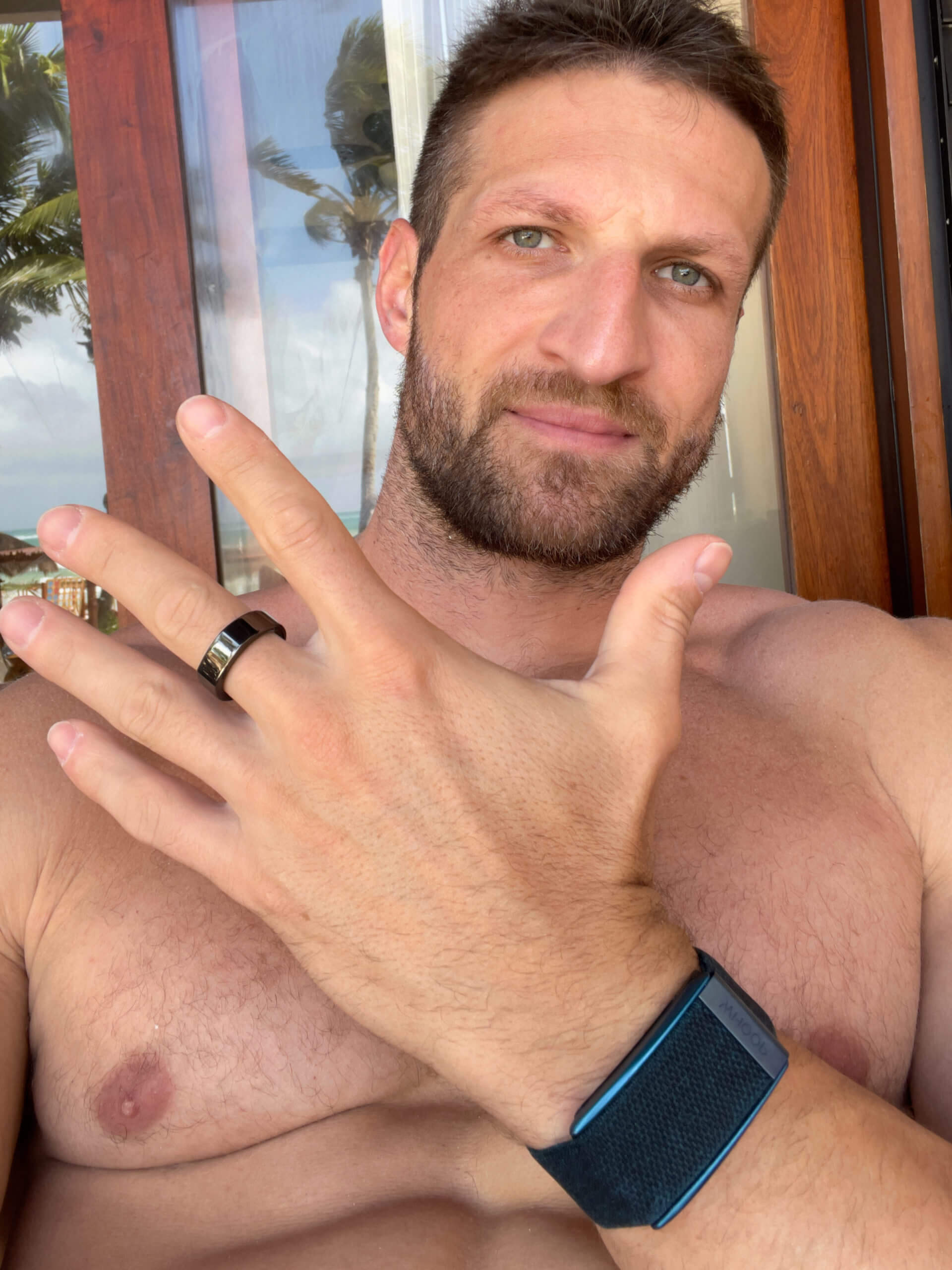
The Oura Ring is a fascinating device that packs numerous wearable technologies into a tiny form factor.
Oura’s goal is to provide you with daily feedback you can use to improve your health. Specifically, Oura analyzes your biometric data to calculate a sleep score, activity score and readiness score.
The latter is similar to WHOOP’s recovery feature, taking into account such parameters as:
- Previous night’s sleep score.
- Sleep balance over the past two weeks.
- Activity and strain on the previous day.
- Activity balance over the past five days.
- Body temperature.
- Resting heart rate (RHR).
- Heart rate variability.
I really like the form-factor of Oura Ring and the data it provides, even though its sleep tracking appeared to be less accurate in my tests compared to WHOOP.
Check out my in-depth comparison article to learn more about how the Oura Ring stacks up against WHOOP.
WHOOP 4.0 Issues (Growing Pains)
As with every new product or major release, there is always a chance for bugs and issues that have to be ironed out. Unfortunately, WHOOP isn’t immune to such growing pains. So here’s a list of issues that I’ve come across (or that others have reported to me).
WHOOP 4.0 Battery Drains Quickly
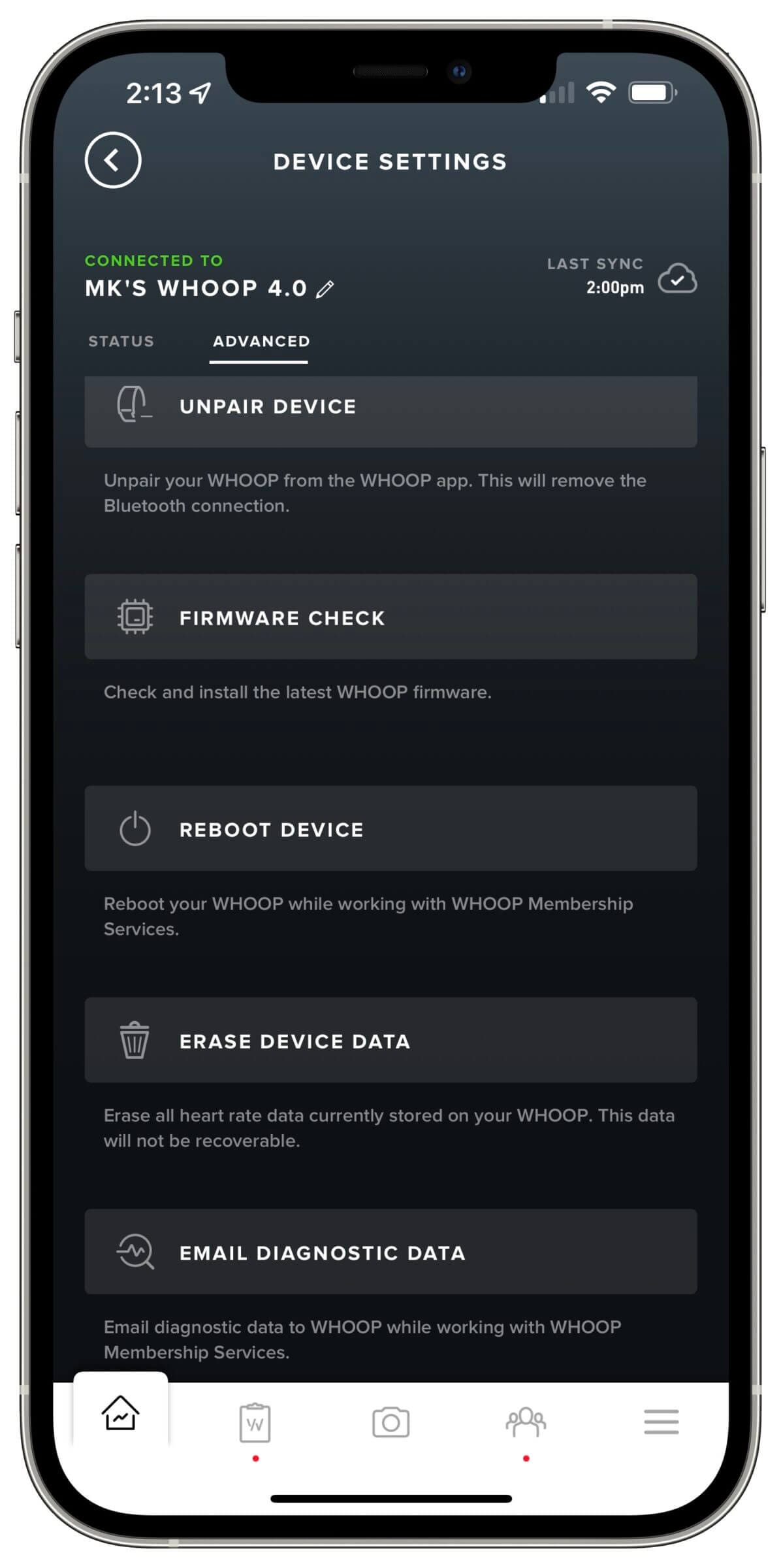
During the first couple of days of using the new version of WHOOP, I noticed that the battery would drain within a day or two. To fix the problem, I restarted the sensor via the WHOOP app and Device Settings > Advanced > Reboot Device.
WHOOP Sensor Doesn’t Turn Off

WHOOP normally recognizes when you remove the strap from your wrist. When that happens, the heart rate sensor turns off (as indicated by the green LEDs, which turn off as well). Unfortunately, there appears to be a bug (in the software, I assume) that prevents the HR sensor from turning off when you remove WHOOP from your wrist.
The problem is that while “off wrist,” WHOOP keeps recording what it believes is your heart beating at around 150 beats per minute. As a result, leaving your WHOOP lying on a table causes the sensor to record a workout and strain that might not reflect your physical activity at the time.
If you experience this issue, just reach out to WHOOP membership services via the mobile app and they’ll send you a new sensor. That’s what I did and I haven’t had any more issues since I got my sensor replaced.
WHOOP 4.0 Battery Pack Stops Charging

While I haven’t had any issues with my WHOOP 4.0 battery pack, I have heard from some users whose battery packs suddenly stopped working. The good news is that rebooting the battery pack fixed the problem in all instances.
The bad news is that you can’t reboot the battery pack from within the WHOOP app. Instead, you have to use an app that can send raw commands to the battery pack via the USB cable. If you’re on a Mac, you can download SerialTools from the App Store, connect it to the battery pack and send it a random command (e.g., a test) to force the device to reboot.
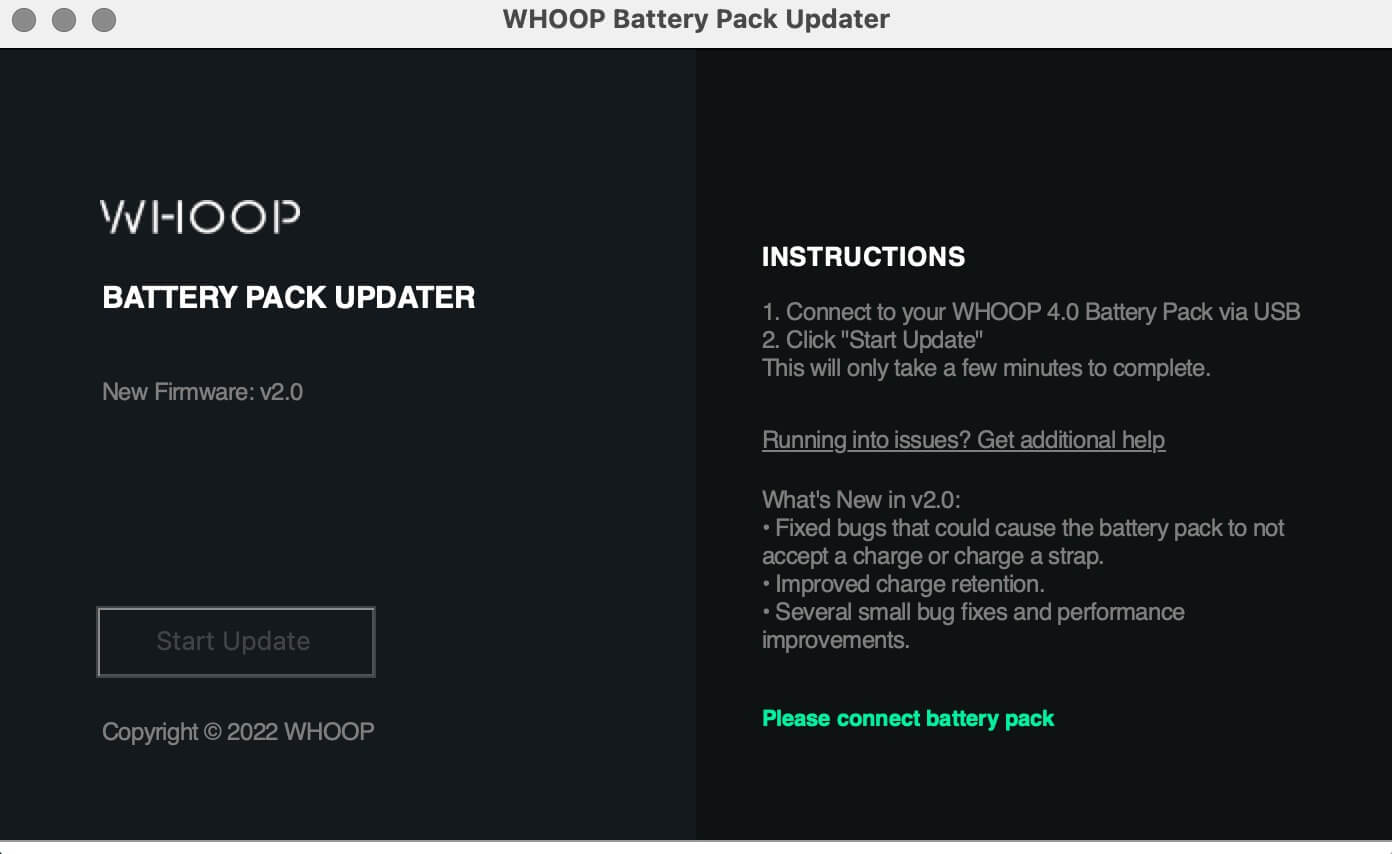
Update: WHOOP released a Battery Pack 4.0 Updater that you can download to update the firmware of your battery pack. Check out this knowledge base article for more information and download links to the update program.
Frequently Asked Questions About WHOOP

Based on the independent validation studies I referenced throughout this article, WHOOP is one of the most accurate fitness and sleep trackers on the market. In fact, a recent study conducted by the Appleton Institute for Behavioural Science in Australia concluded that WHOOP was the most accurate wearable for tracking heart rate and heart rate variability.
That accuracy is thanks in part to the fact that WHOOP uses an electro-dermal activity sensor to detect whether the unit has good contact with the skin.
Electro-dermal activity “refers to the variation of the electrical properties of the skin in response to sweat secretion (source).” That’s an ingenious way of ensuring the device is receiving accurate data, though it’s important to understand that the accuracy of any wrist-worn heart rate sensor is limited by how well it maintains contact with your skin.
As a result, such sensors are often more reliable when you’re stationary, as opposed to during high-intensity exercise routines such as CrossFit. If you suspect your heart rate readings are off during workouts, consider covering the sensor with a sleeve to keep it more securely in place.
To learn more about WHOOP’s accuracy as a fitness, recovery and sleep tracker, check out this article.
HRV is a highly-personalized metric and depends on numerous factors, including fitness, age, gender, genetics, health, and environmental conditions. As a result, it doesn’t make sense to compare your HRV with someone else’s. Instead, it’s more useful to understand the trend of your HRV compared to previous periods.
However, since we all like to share and compare, over the past month my HRV has been bouncing between 26 and 74.
The WHOOP band can store up to two weeks (used to be three days) worth of data before it starts overwriting the oldest entries. However, every time the band establishes a Bluetooth connection with your smartphone, it uploads all its data to the application, which in turn sends it to the cloud.
Proper positioning of the strap is crucial for the accuracy of the signal the sensors receive. If the strap is too loose or too tight, the sensors will either receive a lot of “noise” or no signal at all.
WHOOP recommends positioning the strap on your dominant hand, about one inch from your wrist bone. The strap should be tight enough so that it’s difficult to stick your pinky between the strap and your wrist.
If you’re having issues with your strap — especially if you were an early adopter of WHOOP 3.0 — you might have a defective unit.
A few months ago, I listened to the WHOOP podcast in which John Capodilupo, WHOOP’s CTO, explained that some users got 3.0 Straps with faulty electronics. If that’s the case for you, reach out to WHOOP support via the mobile app to get your strap replaced for free.
Note that it’s normal for WHOOP to disconnect from your phone if you move out of Bluetooth range (about 30 feet). Sometimes the strap automatically reconnects when you get back in range, but often it doesn’t. As a result, you might see a notification informing you that the app hasn’t received any data from the strap in more than three hours.
To fix the issue, just open the WHOOP app and follow the on-screen instructions to reconnect the strap. Once reconnected, the app will fetch the missing data from the strap and sync it to the cloud. You won’t lose any data as a result of this process.
If you experience frequent Bluetooth disconnections, the issue could be related to the aggressive memory management of iOS 13. With the release of iOS 13 and the launch of the iPhone 11 and iPhone 11 Pro, Apple doubled down on extending the battery life of its devices. One way the company accomplished that was by limiting how much memory background processes can consume.
If an app exceeds the allotted memory, iOS kills it. Over the past few months, that has impacted numerous apps and developers. As a result, Apple has released updates to dial back some of that aggressive resource management in later versions of iOS 13.x.
Unfortunately, some apps that require a permanent background process, like WHOOP’s data sync agent, are still affected.
To find out if iOS is the culprit for the frequent disconnections you’re experiencing, open the WHOOP app and go to Menu > Strap Settings > Advanced Settings.
Click on “Email Diagnostic Data” and enter your email address to receive the logs. When you receive the email with the log data, extract the zip file and open the log. If you see a lot of lines containing the words “MEMORY WARNING,” you know that iOS is causing the disconnections.
To temporarily work around the issue, force close some of your other apps or reboot your phone.
Most of the fitness and sleep trackers on the market use the same optical heart rate monitor technology and the same open-source algorithms to interpret the signal from the sensors.
The secret sauce of each company, including WHOOP, is the algorithm that interprets the raw heart rate data. That’s where I think WHOOP has a leg up, and independent validation studies (such as this one) confirm that belief.
Yes, WHOOP measures your ambient skin temperature, which is an important parameter for ensuring accurate sleep tracking. As of WHOOP 4.0, WHOOP also exposes the measurements via its app.
Yes, you certainly can. However, keep in mind that WHOOP needs good contact with the skin to accurately measure your heart rate. So make sure you use a strap that provides a solid fit. My recommendation would be the SuperKnit strap that WHOOP 4.0 ships with.
I have woken up several times with a high recovery score while feeling sore or even completely unmotivated to work out.
The interesting thing is that how we feel doesn’t always reflect how our body is doing. WHOOP’s recovery score is influenced by the presence of inflammation, not necessarily soreness.
So if your body is managing post-workout stress and inflammation well, your HRV might be virtually unaffected. If so, you’ll see higher-than-expected recovery scores.
Sleep performance is only one of three factors that influence your recovery score. The two others are resting heart rate (RHR) and heart rate variability (HRV).
So if your body is struggling with inflammation from a workout, sickness or other factors, your RHR and HRV might both be high. That’s then reflected in your lower-than-expected recovery score.
WHOOP measures strain based on cardiovascular output. In other words, the more time you spend in high heart rate zones, the more strain you accumulate with WHOOP.
On the flip side, if you do a workout consisting of single repetitions — for example, if you’re trying to beat your back squat 1 rep max — your heart rate will not stay elevated long enough to cause any cardiovascular strain.
WHOOP will be releasing an update in spring of 2023 to take muscle strain into account for its overall strain score. Stay tuned for more details on that feature.
As a side note, if your weightlifting session causes muscle damage (which is normal) and inflammation, you’ll see that reflected in a lower HRV, and thus, in your recovery score.
Additionally, muscle fatigue might cause a higher strain the following day because your system is working hard to recover.
Absolutely! Being able to understand how your body is doing, how recovered you are, and what lifestyle factors influence your overall performance and recovery is important — regardless of your fitness level.
In other words, it doesn’t matter whether you’re an elite athlete, a fitness enthusiast or someone who doesn’t work out at all.
For example, if your body is run down, maybe it’s not a great idea to start skydiving. Or if you work on a construction site and wake up poorly recovered, maybe you should take it a bit slower to reduce your risk of injury.
Frankly, I don’t know anyone who wouldn’t benefit from WHOOP.
Yes, I think WHOOP is worth every penny because of the insights it has been providing me over the years. These insights have helped me make better lifestyle choices, fine-tune my workout routine and training load, and keep an eye on my respiratory rate and HRV.
You can use the carrying case to securely store the battery pack and charging cable, thus reducing the risk of losing either one.
WHOOP’s Strain Coach feature can’t replace a real coach. If WHOOP suggests a high strain goal on a given day, it does so simply based on your current recovery score. If you have a race or competition coming up, you might have to take it easy and conserve energy, despite WHOOP’s recommendation.
WHOOP uses a logarithmic algorithm to calculate your strain score. For example, if your current strain score is 5.0 and then you go for a run that clocks in at 10.0, your total strain score is likely lower than the sum of both (15.0).
WHOOP does that so it can top out at 21 — the maximum strain you can achieve.
Consequently, increasing your strain from 10 to 11 is much easier than from 11 to 12.
Yes, WHOOP recently announced an integration with Strava, a popular app and social platform for bikers and runners. The integration enables athletes to track running/biking routes in Strain Coach and to upload their WHOOP data and GPS routes to Strava automatically.
Yes, you can use WHOOP for swimming or triathlons, but I recommend getting the Hydrosleeve to prevent water from getting between the sensor and the skin, and to ensure that the stays in tight contact with the skin.
Definitely! Stress, and chronic stress in particular, can have a huge impact on HRV and overall cardiovascular health. Check out this study on the subject for more information.
You can increase your HRV by adopting certain lifestyle changes, including avoiding alcohol, exposing yourself to sunlight, protecting your circadian rhythm and others. For more information, check out my YouTube video about the 10 hacks I’ve implemented to increase my HRV.
WHOOP offers a special algorithm that can be enabled to provide accurate sleep and HRV tracking for people who have irregular heart beats. Once you’ve signed up for WHOOP and notice issues, reach out to membership services immediately to get on the new algorithm. If that doesn’t work, you can always cancel (within the first month).
WHOOP measures blood oxygen saturation (non-continuously) only during sleep. The score is an average of the collection of median values from each of the sampling periods in the night.
Yes. In fact, in a recent reproductive health study, WHOOP data revealed how changes in HRV trends can help inform the onset of pre or full-term labor approximately seven weeks before it happens. As a result of those findings, WHOOP launched a Pregnancy Coaching feature to help expectant mothers better understand the weekly changes that occur throughout pregnancy.
WHOOP integrates with several health and fitness platforms, including Apple Health, Cronometer, Equinox, Hyperice (via Apple Health), Pliability and Today’s Plan.
WHOOP 4.0 Review: Closing Thoughts
I have become a huge fan of WHOOP, and I’m thankful to the folks at NCFit Alpharetta (formerly known as CrossFit Alpharetta) who introduced me to the platform.
WHOOP is an excellent tool to help you understand the secrets your body is trying to tell you, and I’ve used it for almost three years to improve my overall health, sleep patterns and stress levels.
Until recently, there were two major things I wanted WHOOP to fix: the missing airplane mode and the lack of integration with Apple’s HealthKit, which is the central hub for all my fitness and health data.
Fortunately, WHOOP just released an update for its app with support for Apple Health, so I can no longer complain about that. I’m still hopeful that WHOOP will follow up with a smart airplane mode feature.
Beyond that, there’s not much to complain about. But if I were in charge of product development at WHOOP, I’d push for supporting third-party chest straps (or even launch a WHOOP chest strap), and I’d update the mobile app to better visualize certain biometrics on a timeline.
For example, I’d like to see all of my HRV and SpO2 readings throughout the night, instead of just getting a single metric that likely reflects an average.
Custom WHOOP Journal entries would also be nice to have.
Beyond that, there isn’t much to complain about! I’ve been using WHOOP for a long time and it has helped me learn a lot about my body and better understand what it’s trying to tell me.
I’m looking forward to testing out the new stress management features and breathing exercises WHOOP is developing in partnership with Dr. Andrew Huberman, which are supposed to be released in 2023.
Do you use WHOOP? If so, I’d love to hear your experience with it. So leave me a comment below, regardless of whether you’re a health-conscious consumer or one of the many elite athletes using the strap.

Michael is a healthy living enthusiast and CrossFit athlete whose goal is to help people achieve optimal health by bridging the gap between ancestral living and the demands of modern society.
Medical Disclaimer
The information shared on this blog is for educational purposes only, is not a substitute for the advice of medical doctors or registered dieticians (which we are not) and should not be used to prevent, diagnose, or treat any condition. Consult with a physician before starting a fitness regimen, adding supplements to your diet, or making other changes that may affect your medications, treatment plan or overall health. MichaelKummer.com and its owner MK Media Group, LLC are not liable for how you use and implement the information shared here, which is based on the opinions of the authors formed after engaging in personal use and research. We recommend products, services, or programs and are sometimes compensated for doing so as affiliates. Please read our Terms and Conditions for further information, including our privacy policy.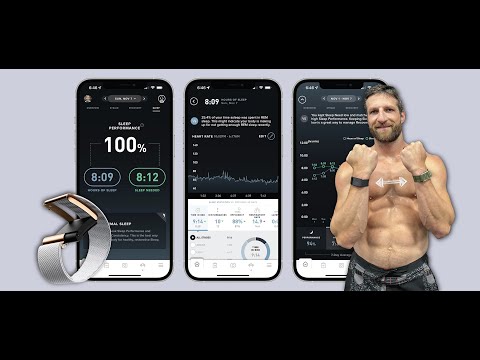



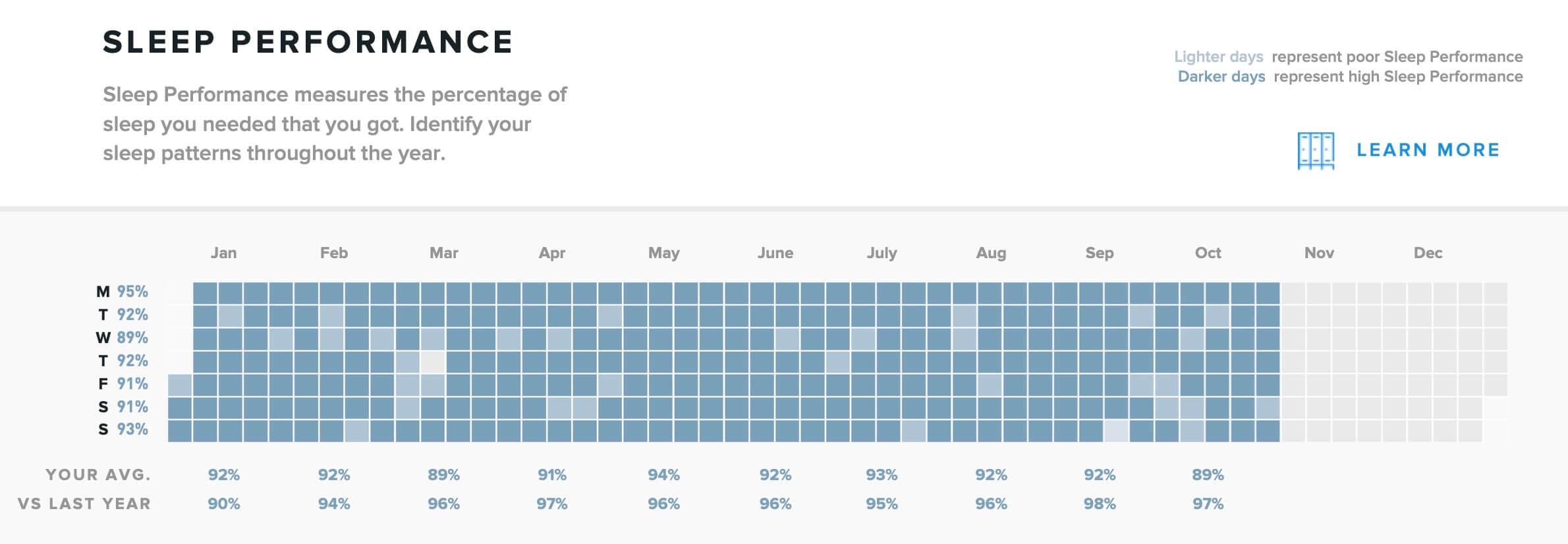
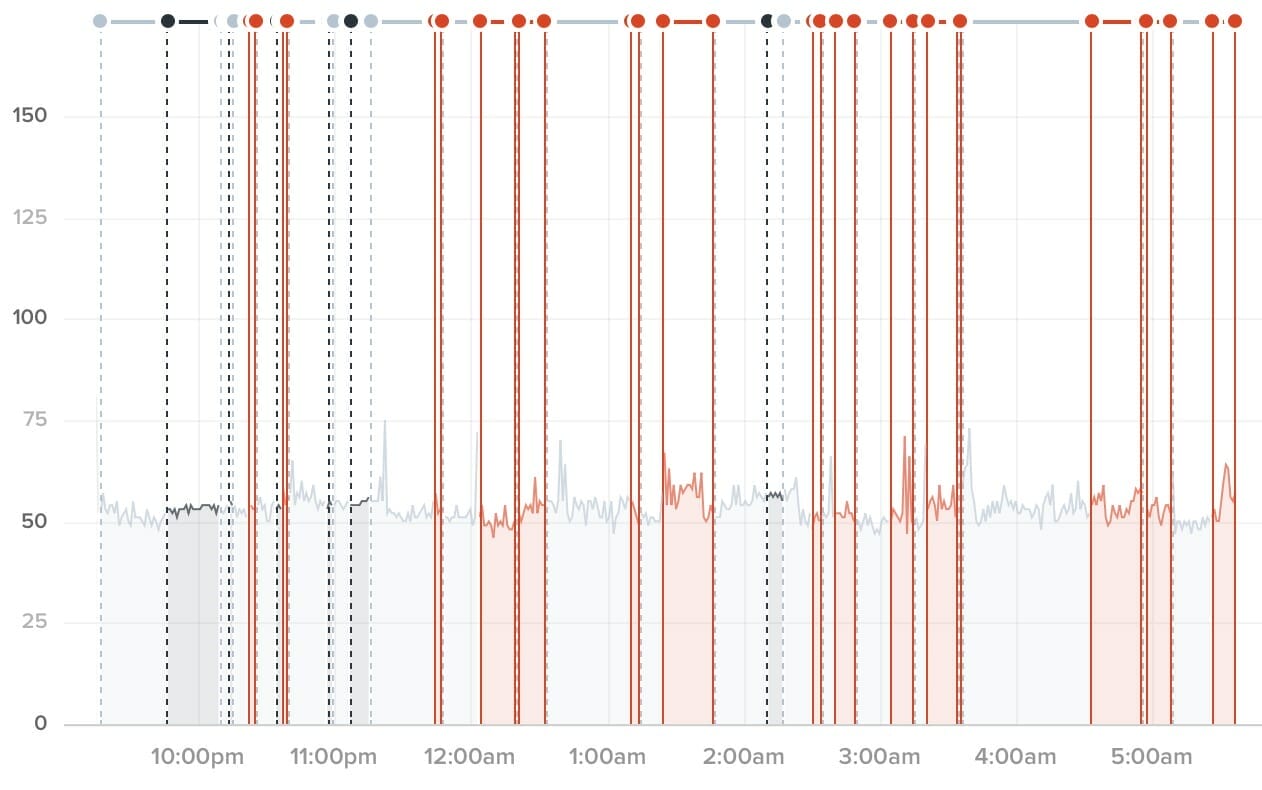
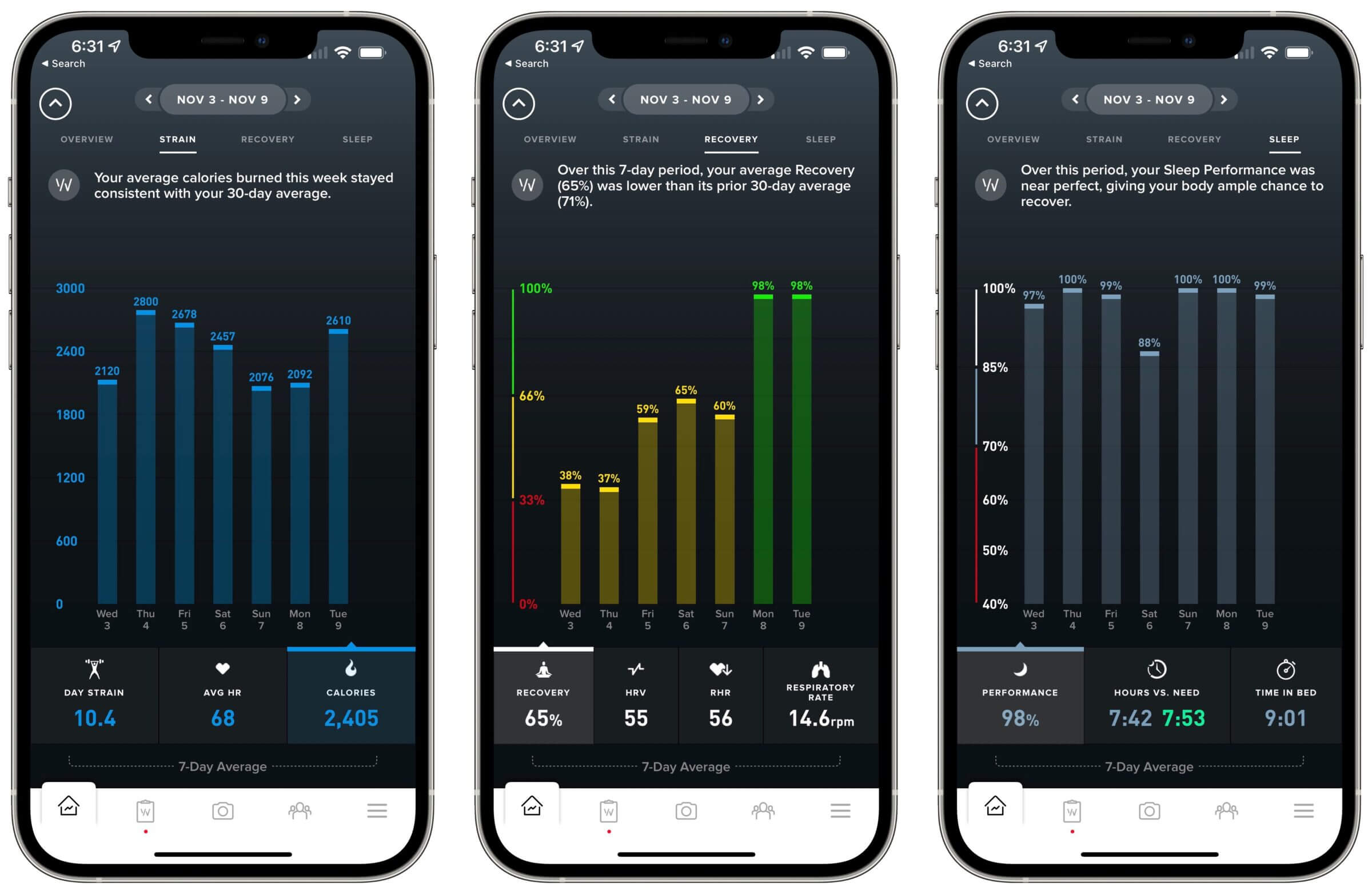

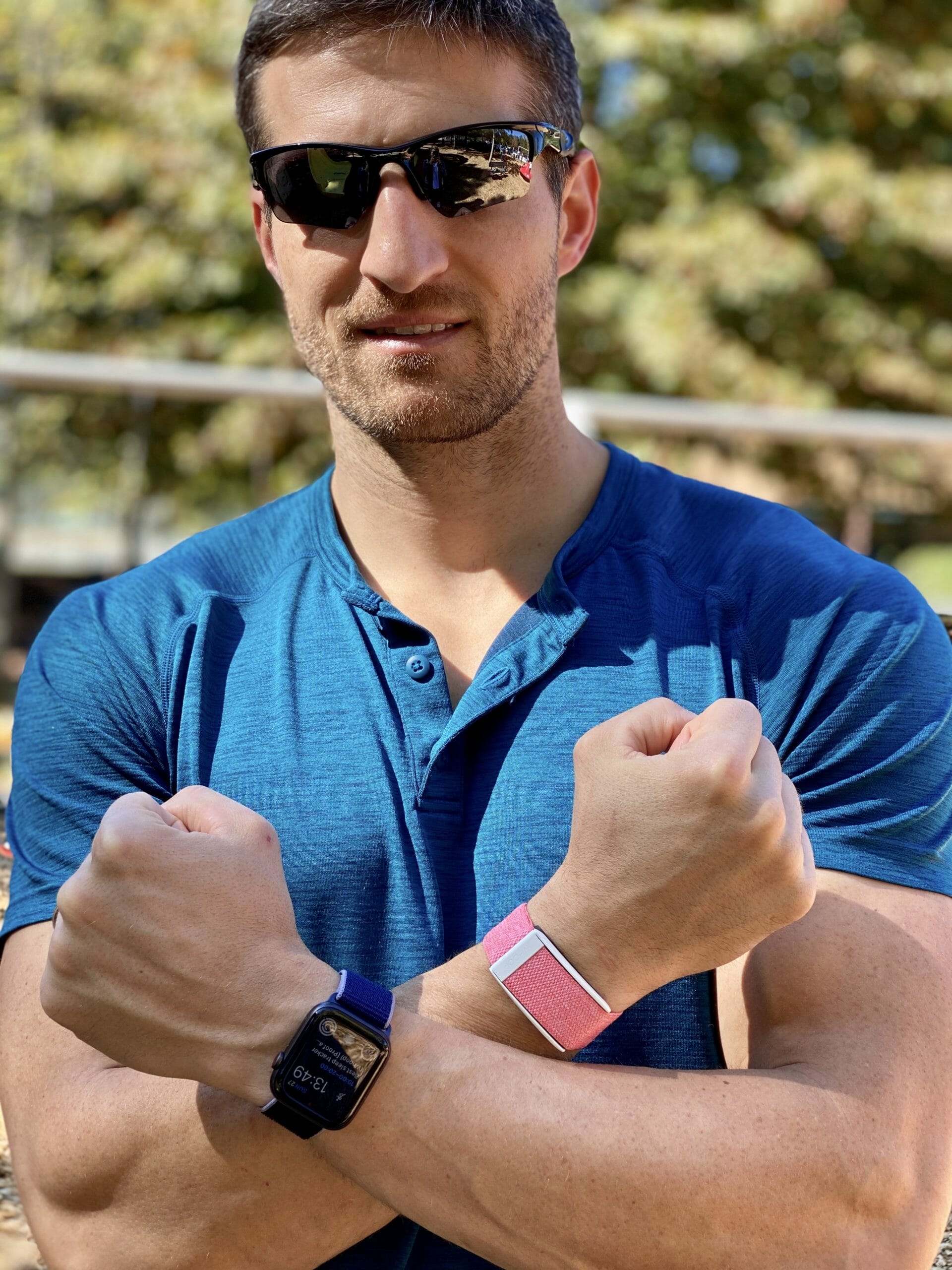


Great review Michael. I want to relate to my poor experience dealing with Whoop. My daughter gave me the gift of a 6 month membership of Whoop. However Whoop refuses to activate it unless I give them my personal credit card and authorize them to charge it for either a 12 month extension at the end of the six months or agree to let them charge me for month to month membership at the end. I think that’s a terrible business practice: refuse to provide the service already paid for. Why should I have to give them my credit card for a service that’s ALREADY PAID FOR. I’ve never used it so I don’t know if I want to continue with it yet. This is an unethical business practice and it speaks volumes about the character of the Whoop company.
Thanks for your feedback Chris and I’m sorry to hear about your issues. I agree that your CC info shouldn’t be a requirement if the first term has already been paid for.
Thank you for the review.
It seems that the sleep coach alarm function is very useful. Does Whoop 4.0 has a normal haptic function that informs messages or phone calls?
Hi Ivan,
nope, WHOOP doesn’t have any other haptic functions.
Cheers,
Michael
Looks like you’ve been wearing it in the wrong position for 4 years 🤔
How so?
Thanks for the in depth Whoop review. 2 questions:
1) You mentioned the pulse ox only operates while you sleep. Can you collect pulse ox data during the day? (I’m recovering from Covid).
2) Where is the strap made (What country of origin)? This has become an important issue lately.
Thanks for the help
Hi To,
1) I’m not aware that you could use WHOOP to capture SpO2 data during the day.
2) Do you mean the sensor or the band?
Based on https://www.federalregister.gov/documents/2020/12/14/2020-26342/notice-of-issuance-of-final-determination-concerning-a-whoop-strap-device, the hardware is manufactured in China (no surprise there) but programming takes place in the U.S.
Hope that helps!
Cheers,
Michael
Do you have any idea if hrv works well if I have an irregular heart beat – not afib? I tried the Oura ring but it had large gaps that took about 2/3 of fmy sleep time.
Hi Allen! I honestly don’t know but let me try to find out and get back to you!
I just heard from WHOOP that they can enable a special algorithm for you to work around your condition. They have done that with other members as well. I’d just mention that from the get go!
I would not recommend the Whoop. Although it does recognize activity of sleep and exercise I have found the results to be wildly inconsistent. I referred to heart rate during exercise and the corresponding algorithm results for calories burned, HRV, strain etc. I have tested it against other competitive products which has led me to this conclusion. Initially the customer support was attentive however when requesting a refund, as I had prepaid, there were crickets. This conversation started several months ago during which I was quite patient however when the refund was requested the correspondence ceased.
Michael,
Thank you for a very well written and informative review. I am not an athlete, I am in my early 60’s, out of shape, work too many hours sitting on my tail and have terrible sleep habits. Suffice to say I have a lot of work to do.
I have started initial training to be able to work up to real, age appropriate exercise and making better life/work decisions on my time and activities. I’ve shed 17 lbs in the last 2 months and building more walking stamina. I am looking for a fitness monitor that is accurate enough for my profile (not a competitor/athlete) the will provide a more fully featured range of health metrics and the Whoop sees to fit the bill. I have read many reviews over the last week on a spectrum of fitness monitors and yours stands out as convincing me that I should give the whoop a trial run.
One thing nagging me are the very poor reviews this product gets on the Google Play store. Are you still using the product, do you find it to be reliable after 2 years of use?
Regardless of the feature set in the software or data, if the thing is not reliable, it is worthless. Reliability and consistency in data collection/analysis are my top two requirements outside of the data collection attributes. Accuracy/Precision follow fast but being accurate but unreliable is a deal breaker.
Thanks in advance,
Lou
Hi Lou,
Thanks for your comment! I’m still using WHOOP and so does my wife and we haven’t had any reliability issues. As far as accuracy is concerned, there are limitations that all wrist-worn devices have. Check out https://michaelkummer.com/health/whoop-accuracy/ for more information on that.
Based on what you described, I think WHOOP will be a great fit.
Also, you might find this article interesting for your journey towards a healthier life: https://michaelkummer.com/health/healthy-lifestyle-guide/
Cheers,
Michael
Thank you for this very detailed and comprehensive review. As much as I love my Apple Watch, I prefer to wear my regular time piece when I’m not working out. Problem is I love metrics! Came down to Whoop vs. Oura Ring. This review did it for me. Went ahead and ordered the Whoop.
Thanks for the feedback, Rob! I appreciate it and I’m looking forward to hearing how you like WHOOP.
I just took my pulse manually after reading all previous comments while seated in front of
of my laptop, HR 30. I am an elite athlete with Heart Block second degree, type 1.
The HRV measurement, daily strain and recovery scores are very appealing to have,
but could they still be accurate?
I don’t see any reason why WHOOP would be any less accurate, despite your condition and conditioning.
I swim laps in a 25yd pool. Will it track my distance and any other info since it doesn’t have gps? I don’t have any type of fitness/smart watch so trying to find something that best suits me better than my lap counter.
Thank you
No, I don’t think WHOOP can count laps. The Apple Watch can.
Hi Michael,
Thanks for writing such a succinct review. I’m a review-aholic when it comes to purchasing new gadgets, or anything, really. So cheers to your review.
I have a couple of questions that you may or may not be able to answer, and I will also direct the questions to Whoop, but it’s good to get a unbiased opinion.
I’m wondering if you know how Whoop performs in ‘hot’ gyms. So, hot everything – HIIT, cycle, yoga, pilates, weight sessions, etc etc. My thoughts are that the band would loose contact or its performance hindered by copious amounts of sweat, regardless of the type of band and where it’s worn. Do you have any thoughts on this?
Also, do you know how Whoop performs for people with unusual heart rhythms? Does it adapt to the wearers own unique heart rhythms, or does it match the wearer according categories at what’s expected of people in those categories (age/sex etc)? I’m not sure if I’ve asked that very well. For example, I have a very low average and resting heart rate (pro athlete-type heart rate – and I’m definitely not a pro-athlete). When exercising, my heart rate shoots to maximum HR zone regardless – it’s near impossible to stay in a medium to high intensity zone. And the moment exercise stops, HR drops to normal/resting HR very quickly. It’s either maxed out, or average/resting. Not much in-between. Does Whoop adapt to individual biometrics that fall outside the ‘norm’?
Due to the HR irregularities I find it really difficult to know how to train and if I’m helping or hindering myself. That, and now throw menopause in the mix, I have no idea how to train anymore. I was hoping that Whoop might give me some insights.
Hi Melissa,
Thanks for your feedback, I appreciate it!
Re WHOOP: You always want the strap to be in close contact with the skin, with or without sweat. If the strap is not tight enough, you’ll get inaccurate readings.
As far as unusual heart rhythms are concerned, I’m not aware that WHOOP has been pre-calibrated for a “normal” rhythm but that’s something you’d have to confirm with WHOOP directly. But based on your example given, I can tell you that all wrist-worn devices have problems detecting rapid changes in HR (in comparison to chest straps). That’s less an issue with the calibration as it is with the technology those devices use to read HR data from the wrist.
To be perfectly honest, I’d completely ignore HR data during workouts and simply rely on the recovery data WHOOP provides. That data is not related at all to strain or HR data captured during exercise. Instead, it’s based on HR data during sleep and WHOOP can capture that very accurately. See https://michaelkummer.com/health/whoop-accuracy/ for more information on that!
Cheers,
Michael
Regarding the Oura ring, it is really not a fitness tracker in the same vein as the Apple Watch or Whoop. I know many that only wear their ring at night and just have it synced to Apple Health to get their activities included in the Oura app.
Exactly: the Oura ring only tracks HRV, temperature, &c when it detects a lack of movement. The rest of the time, it’s just an accelerometer being used to determine how active a person is, and there’s no data lost by not wearing the ring during a workout, especially if that workout is tracked by something else that integrates with Apple Health or Google Fit (Garmin, Suunto, &c).
Workouts that are written to Apple Health (or Google Fit) are automatically imported, but more as a journalling feature: the ring makes its prognosis primarily based on data it captures while sleeping, or being still (it’ll automatically detect a nap, and show change in HRV if one medidates.
Oura writes to Apple Heatlh (or Google Fit), and has an API that allows that data to be pulled into other services, such as HRV4Training.
Hi M,
Great review. I am an apple watch user and have been training alot recently as in 6 days/week. These involve lots of crossfit and hiit. However, recently have been feeling very tired and thought the whoop maybe a good tool to have. I do have a few concerns:
1) I am not allowed to wear a wrist band or strap due to infection control measures so will a bicep strap work to wear for a full day?
2) If so, will a bicep band accurately track my heart rate since the easiest place to read heart rate is on the wrist?
Thanks
Hi Zee,
based on everything I know, the biceps band appears to deliver more accurate HR tracking results because it stays in better contact with the skin — especially during exercises that involve wrist movements, such as CrossFit. So yeah, I think the biceps band would be an excellent choice for your needs.
Thanks for the extremely thorough review! You said you found out how IF effected your sleep, but I didn’t see the actual results of what you found out. I’m very curious what you found.
Good question! In a nutshell, I’ve noticed improved recovery and I spend more time in restorative phases of sleep. When I do longer fasts (30h+), my body goes into full survival mode and my HRV goes up way above baseline. See here for mt July data: https://www.dropbox.com/s/lco7vwve8l3o7q0/Screen%20Shot%202020-08-17%20at%2008.33.48.jpg?dl=0
Hi Michael, many thanks for your article. I would agree with your conclusions, except that integrations are crucial and will kill Whoop unless they grow and mature the offer. It is impossible to gain a truly accurate picture of total health and wellbeing without blood sugar, hydration, weight, muscle mass, body fat, basal metabolism and many other factors which need to be measured and analysed constantly as part of the holistic health equation. Whoop’s lack of adequate integration is, therefore, I conclude, its ultimate failure. I certainly love the Whoop band and its metrics but this lack of integration is leaving a glaring hole in my metrics. They need to fix their lack of integration swiftly if I am to continue, certainly. And the Strava integration is ultimately flawed.
None of this interests me whatsoever until they have (reasonably) accurate oxygen sensors. If/when, the biceps band (but wider) would be my choice. In pink or gold – the dark colors get lost in my home…. I am a f/77, have COPD so won’t be breaking a sweat but will meet/exceed my max HR just thinking about exercise!
Not a fan anymore. There is no way to get access to your data (or your trainer), you only get what Whoop thinks you should see. The automatic detection of activities used to be way better in the past. This was a huge plus for me, but having to add or manually start my workouts is a bit cumbersome. The bluetooth issues you already mentioned.
It also looks like the support has access to your data, which is think is a big Nono, which might not bother a lot to people. You can also not download the data to do your own calculations on.
I still like it, the band is superior to most other trackers and having sensitive skin there is no other tracker I can wear so well. Also like that it does not have a display.
As a long time user I am just not that wowed anymore and I came here to see if there is a good alternative. Which seems like there isn’t.
Thank you for the review. How does Whoop’s sensors react to tattoos? Apple Watch and some sensors have difficulties with this and causes me to be unable to use specific features especially those with wrist detection.
Hi Heath,
Based on what I know, all optical HR sensors that use green light can be affected by tattoos. But I don’t have any hands-on experience because I don’t have tattoos :)
Cheers,
Michael
Es wäre gut, wenn die App auch auf Deutsch wäre
Bestimmt kannst schon Englisch.
I have used all three-Whoop, Biostrap and Oura. I logged data for several weeks for sleep to see what the differences were. Whoop always showed more deep sleep than Oura-every night. Biostrap only characterizes Deep Sleep, not a breakdown of REM/Slow wave. Overnight HRV was somewhat consistent between the three. I let my Whoop expire as the strain algorithm never meant much to me as I only do Peloton cycling and it always desired more strain for some reason. I still use Biostrap for sleep and Oura 24/7 although I am suspicious of the sleep data as it shows 5-30 minutes per night of deep sleep every night. I love new wearable tech and try most platforms and ultimately think it will become very reliable and significant to healthcare.
I was really excited to get my Whoop…..but right out out of the box my charger did not work, and I was thankful I ordered a second one. But the unit would not hold a charge. I visited their website, was greeted by an auto message telling me they are experiencing a high volume of calls, and was directed to send an email. I did, and am now on my 7th attempt to get any kind of a response – all the while I am paying $30 a month on top of what I paid for the equipment, and am locked in until they choose to let me out of it. I’d like to discuss why I have to keep paying when my equipment doesn’t work…..but I am able to contact them and they seemingly have no interest in contacting me. Even months later, they are still receiving too high a volume of calls to respond……let that be your warning.
I rely on and this equipment and am very familiar with other similar products. I have passed my units around to other professionals and they all agree that I have received a lemon. Now just to receive a response to tell Whoop that!
Hi Annely,
I’m sorry to hear about your troubles! I never had to call in for support but I submitted a couple of requests via email — actually via the WHOOP app — and always got a response within a day or two.
Either way, I hope you’ll get your defective unit replaced asap and won’t end up paying for the time you couldn’t use it.
Cheers,
Michael
Great review! Just received my WHOOP 3.0 and have not found in any literature what is the preferred hand to wear the device. Most videos I see has it on the right hand which I assume is the dominant hand for most.
Do you have an opinion on this?
thank you
If I remember correctly, most of the testing WHOOP has done in terms of fit and accuracy where done on the right hand. Practically, I don’t think it makes much of a difference. But I’ll reach out to my contact at WHOOP to confirm and will send you an email.
Cheers,
Michael
Hi Michael,
Thank you for your in depth review. It makes me even more excited to try Whoop. My dominant hand is my left-hand. I also wear my Polar watch on my left hand so when my Whoop arrives tomorrow I plan to wear it on my right hand. With your experience would that be an issue?
Kind regards
Christopher
No, I don’t think that would be an issue. I asked my contacts at WHOOP once and they confirmed that either wrist is fine.
Hi, I saw whoop website that the 3.0 watch just compares hrv during the first 5 minutes of your last sleep wave to establish a baseline for day to day comparison. Do you know if other measurements in the day happen or are considered.
Hi Edward!
That is correct! HRV is highly volatile and random readings don’t mean anything because they’re influenced by your activities. For example, if you drink a glass of water, your HRV might change in response. That’s why it only makes sense to measure HRV during a time where your body isn’t influenced by any outside factors — and that’s deep sleep.
Cheers,
Michael
So is the $30/mo just basically a payment plan for the band, or does this subscription continue indefinitely? If you have to pay a membership fee to where a fitness tracker—that’s utterly insane.
Hi Julius,
The monthly payment covers the hardware (sensor/strap) and the service (ongoing reporting, algorithm updates…). It’s not much different to paying a subscription fee for an app. There are pros and cons to that approach for both the provider and the user.
Cheers,
Michael
Hi Michael,
what happens if my subscription expires?
Will the app shut down and I cannot get readings anymore?`
Or will I still have rudimental access?
I find $30 quite a heavy price tag for this service…
Thanks!
Hi Nikolas,
without a subscription, the strap is useless as all the data crunching happens in the cloud. You might still see the accumulated strain and maybe calories burned (never tried it) but you definitely won’t see any recovery scores or sleep analysis.
Cheers,
Michael
Michael,
Ausgezeichnet! I share similar passions..technology, health, sports performance.. Former US National Cycling Champ and World Champ (in St Johann) (Masters) turned Crossfit competitor. Also speak fluent German..lived there 4 years..several cities. I must say you hit some decent wattage numbers on the Carol bike 20 sec sprint.
I have been extremely healthy and very competitive in sports my whole life, but recently had a very unexpected, first time ever AFIB occurrence…confirmed by my Apple Watch 4.0 last week. My cardiologist believes it was the ‘perfect storm’…Bang Energy Drink, hot Crossfit session, 40 mins in sauna at 190 F. AFIB began in the sauna. He believes not likely to happen again if I minimize the ‘triggers’. I have cut out all caffeine and alcohol (huge sleep improvement) and have become obsessed with monitoring my sleep quality..poor sleep/sleep apnea are triggers for AFIB. Have been using Apple Watch with Pillow app for decent results. Would you expect me to be able to better monitor my sleep with Whoop than Pillow? Also in your experience, have you noticed better performance with crossfit workouts on the days Whoop scores your recovery as high and conversely poor performance on low recovery score days? Thanks for taking the time to answer. Ich wuerde sehr gern Sie einmal kennenlernen.
Hey Allen,
Thanks for sharing your story, I really appreciate it!
I just finished drafting an article that goes into more details about the technology used by sleep trackers and why I think WHOOP is one of the best consumer-grade devices out there – so stay tuned for that.
But in a nutshell, yes, I believe that WHOOP will provide you with better and more reliable data than the Apple Watch + any app. Maybe once Apple turns its Beddit acquisition into a new product that combines the Apple Watch with a contactless sleep tracker we’ll see better results. For now, WHOOP and its additional sensors (skin conductance, ambient temperature) is your best bet imho.
Lower recovery scores don’t always translate into bad performance, especially if I slept well — at least not on the level that I’m on (performance wise). But I usually take it easy or easier on those low-recovery days to give my body a chance to…well…recover.
So if I’m in yellow, I might not perform noticeably worse that day. If I’m in red, I can usually feel it and don’t even bother trying to push it.
Hope that helps!
Cheers,
Michael
I wear my Oura ring for most workouts, unless it involves gripping a bar or kettlebell. I have worn it during those and do okay, but would prefer to be safe and protect it. It doesn’t track workout intensity during those kind of movements particularly accurately anyway, so I just use the app’s manual activity entry to enter the time/duration/intensity level of those types of workouts so some data is there rather than none or inaccurate data.
So I got a whoop and have been testing it against my Apple Watch and honestly I think it’s kind of a gimmick. The Apple Watch series 4 or 5 have battery life long enough for sleep tracking and with a fast charger can get you from 25% to 80% in 15 minutes, enough to fit into a shower routine. Combine it with a good 3rd party sleep app like AutoSleep that detects your recovery using HRV, and you get legitimately great feedback on recovery and how much you can push yourself every day. I hate having to wear multiple devices and don’t think the Whoop is for long..
Hi Chris,
the Apple Watch isn’t a good sleep tracker for numerous reasons. I’ve had all models, including the Series 5 using the latest apps and none worked reliably. I’m about to publish an article that goes into the technology (sensors) and other reasons why most sleep trackers aren’t good enough. So stay tuned for that.
Cheers,
Michael
Michael, danke fuer dieser Artikel – es is sehr hilflich!
Hi Walter,
bitte gerne, danke fürs vorbeischauen!
Liebe Grüße
Michael
Great review! If I have a subscription for a while and then stop, is there anything I can still do with the whoop band? Or does it require a subscription to function?
Hi Chase,
not really — all the functionality is tied to the subscription. If you cancel, the strap becomes a paperweight :)
Cheers,
Michael
Dear Michael,
how does one take shower after the Workout? Do you take Whoop off just for the shower? or leave it be on your wrist? Because the wrist band gets all wet and salty and most of all will get stinky if you don’t wash them or dry them properly. How did you manage yourself around These Problems?
Hi Eumin,
WHOOP is water-proof (just the battery pack isn’t), so I leave it on when taking a shower. I might just open the clasp so I can wash the inside of the sensor and the band. All bands I’ve had so far, including the latest ProKnit dry really quick. So I never experienced any issues.
Cheers,
Michael
mine did get stinky and wet…. i shower with it, and after a month of using, i started getting that wet stinky smell from somewhere,
I noticed it was the whoop and the whoop strap!!
i never had this issue with my silicone galaxy watch…
while the band is comfortable i might have to wash it with vinergar/ baking soda periodically to keep the smell away…
or just not wear it to the shower… sigh
Hi i use actually a Garmin but ay the past i used WHOOP
Garmin sais me i burn 1500-2000 caloier
And WHOOP near 3500-4000 caloies
What of two its correct
Hi Raquel,
that’s hard to tell. Calorie tracking is based on your HR reading and the quality of that depends on how well a contact the sensor has with your skin. For a woman, 3-4k calories seem high – but of course, it depends on your level of activity.
For reference, I’m 6 feet tall and weigh 190 pounds. On days I workout, I burn 2.8k – 4k calories in total.
Cheers,
Michael
I have the same issue! My Apple Watch shows a far greater calorie burn than my whoop, some days a 700 calorie variance. I don’t know which to trust!
Hi Lora,
what straps do you use for either wearable? I’ve found a less-than-ideal fit to be the primary reason for tracking issues.
Cheers,
Michael
I’m a competitive athlete with several international level coaches in my team. My sleep doctor coaches NHL players and he expressed very strictly that none of these devices can actually track your sleep. What they do is that they use algorithms to model your sleep based on certain metrics but to track your sleep you need to have a polysomnography :) so wearables are not accurate with sleep metrics. Remember that all models are wrong while some models are useful. :)
Now, here’s the caveat: the more you have sleep disturbances the more these models get wrong. Having been twice in real polysomnographic test (you sleep with over dozen medical grade sensors around your body) I can ensure that these gadgets are wrong, quite much wrong indeed.
Why do I still use my Oura then? Two reasons: a) these gadgets are useful is collecting HR and RHR data during my sleep (I’m still in the process of analyzing if the data is useful itself though) and b) they guide me to give more attention to the sleep and recovery ☺️
Albout the gym, (or sports), I’ve come to notice that optical HR monitors are really bad when tracking HR during the sports. They don’t come even close of a real HR strap. They are so unreliable that a real athlete cannot base her training on these and I have used different top models from Polar and Garmin. As the optical sensors are pretty standard stuff I highly doubt Whoop cannot make any difference.
I encourage you to make a test: wear garmin/polar with HR strap and compare the results with Whoop. Also, the problems with optical sensors during HIIT or short intervals are especially well known (even Polar H10 the golden standard of sports labs has problems with these).
Thus going gym without Oura is not a problem for me as none of these wearables are something that gives me useful data and during the sports I always wear a HR real strap. ?
My point here is that while new tech is awesome and it can help you many ways, you still have to use your judgement and not become “slave” – because oour technology still fails us quite often. It’s easy to become fascinated by reducing our lives into a couple of numbers but unfortunately human bodies are way more complicated than one could possibly understand.
I recommend studying undergraduate level exercise physiology to grasp a bit how complicated and fine machines we are. You might get surprised. ?
Hi Frnkr,
I appreciate the time you took to draft such a detailed comment.
Your sleep doctor reminds me of my primary care physician, who still thinks saturated fat intake increases my risk of developing coronary heart disease — despite meta analysis of numerous clinical trials stating the opposite. I consider that an opinion that’s not based on actual, scientific evidence.
I’ve linked a study in my article showing the accuracy of certain wearables for sleep tracking and how they compare to the equipment used in sleep labs. Speaking of sleep labs — have you ever tried that? The stress alone of being hooked up to monitors while trying to sleep in a lab-environment renders the results pretty much useless.
Outside of the lab studies WHOOP has performed, they also published a real-life study with college athletes – you can check it out here: https://www.whoop.com/thelocker/study-rhr-hrv-sleep-collegiate-athletes/
Besides that WHOOP has the data to proof its accuracy (which very much depends on how tight the strap is), I’ve compared HR readings of a chest strap, my Apple Watch and the WHOOP during CrossFit workouts. I couldn’t find any significant discrepancy.
My recommendation would be to read up on the latest scientific evidence and to ask your sleep coach what studies he bases his opinion on.
Cheers,
Michael
I have been reading through the comments and I believe your reply here is not on target. I have used Whoop for a couple of years and have benchmarked it with chest straps and/or Apple Watch for Crossfit, running, and cycling and the Polar OH1 HRM against the temple and on the goggle strap for swimming. The Whoop does give me highly variable data vs what I consider more gold stand measurement of chest straps and the aforementioned OH1. The Apple watch is probably the preeminent OHR monitor. Whoop overestimates by around 20 bpm for swimming and cycling and is fairly close running. In Crossfit the Whoop can go crazy. Given that, the Whoop strain is off and can give inaccurate advice. Regarding sleep and in line with the post you replied to, Whoop gives me far less sleep than the Oura ring, much higher deep sleep, so I do not know which one is right. So, I consider the data as relative information. I also wear an Oura ring btw. I also agree that the more advanced lab studies are the truly only real indicator even though all these sleep devices want you to think differently. I do have a bicep strap on order for the Whoop and will benchmark again versus the bicep strap. I do feel wrist geometry may play into the accuracy of the Whoop.
Hi Fred,
I recently performed some more accuracy tests and documented my findings in this article — check it out: https://michaelkummer.com/health/whoop-accuracy/
I’ve also gotten an Oura Ring and Eight Sleep to compare sleep tracking data. Eight Sleep and WHOOP agree most of the time. Oura is always wildly off and I’m not entirely sure why that is. I’m currently performing some more tests and then write up my findings in a blog post.
Thanks for the link to your comprehensive evaluation. Your method of benchmarking is quite similar to mine in that I use my Apple Watch connected to a chest strap and your findings are similar to mine. Swimming is the big wild card and and the wrist movement you mention is likely the culprit along with the rapidly moving arm. I do try to put the Whoop Strap underneath my wrist where it is more fleshy but that really does not help that much. I equate the swimming to what I can do at my desk; move my arm overhead in circles and watch the HR on Whoop go up artificially. As a result, I just tend to ignore the HR and rely on my Apple Watch. If I want really good data in the pool, Polar Beat with OH1 on my temple in memory mode does the trick and I just accept Whoop for what it is. I am not a pro athlete either :) and just like the guidance. I will read through more of your articles. Thanks Fred
Hi Fred,
Have you seen the Hydrosleeve announcement? That sleeve should definitely help to keep WHOOP in close contact with your skin and prevent water from getting between the sensor and the skin.
Cheers,
Michael
I have been using the whoop and i like it a lot but i sweat a lot during my workouts. Unfortunately the band is still soaking wet after i shower and get ready to go about my day. I have the band that came with the whoop 3.0 but i was wanting to know if you know if any of the other whoop bands are more plastic or rubber type that will dry off a lot easier. Thanks you for your post if was very informative.
Hi Rene,
I just got out of the shower and paid attention to the strap. My 3.0 strap dried within a few minutes. Before I read your comment, I never noticed it and so I never paid attention to the other straps I used before. However, just based on the fabric, the Lux Kit might dry a little faster. Not sure if it’s worth a try, though.
It’s hard to believe we have such opposite experiences. Unfortunately the whoop 3 just does not meet the mark. From missing nights data to not recognizing activities, and an inability to correctly record sleep (even after manually updating it to correlate to my other devices). This is a good idea very badly executed. Two other huge issues, which ultimately would be the reason for purchasing: 1) on days where I literally do nothing it has me showing as having a strain level higher than 91% of users, and days where I run 21 miles it barely notices a difference. 2) it references a new metric “HRV” but does not give any insight into how to address it and what is good or bad. The stress of having the device tell me I am way behind on sleep and recovery (when in reality I know I am well above average in both) actually has been quite stressful. So many deal breakers this is not ready to be in market and certainly not at the price point.
Hey Pippen,
Thanks for the feedback, I appreciate it! Have you considered that your strap might be defective? Many of my friends and fellow CrossFitters use WHOOP and none of them have reported any of the issues you’re having.
Coincidentally, I listen to episode 31 of the WHOOP podcast yesterday in the car in which John Capodilupo — their CTO — talked about some users who have gotten a 3.0 strap with bad electronics. He recommended to reach out to support via the app (which sends a diagnostics file). If your strap is bad, you’ll get it replaced.
Cheers,
Michael
Hi Michael, First, thanks for the accurate review and comparisons, truly appreciated!
My question is how do you use it for Crossfit? and how durable is the Woop strap for CF? :) as if in the wrist we commonly sometimes do Kettlebell, that can endanger seriously the device (and anything in our wrists, as the wrist itself…) so I guess you use a arm strap… if so which one and how does it go for you?
Cheers,
José
Hey José,
I usually just keep WHOOP on my wrist during CF workouts – but I move it back a bit, so that I have enough room to close my grips, if I use any. Otherwise, I don’t do anything special. However, I’ve banged KBs a few times both against the WHOOP and my Apple Watch, so far without breaking anything. A few times, the clasp of the WHOOP opened and I had to close it again. No big deal.
However, if that happens more often, I suggest to use the biceps strap or to wear something protective over your WHOOP. I have the biceps strap that I showed in the photo and it works really well – you just have to take it on and off before/after the workout. I’m lazy and prefer keeping WHOOP on my wrist :)
Hope that helps!
Cheers,
Michael
Hi. Interesting deep dive. I am a Crossfitter and a runner. For my running I use a Garmin Forerunner 235 which has the built in HR monitor. Is there any ability to integrate the two platforms? Any benefit of Whoop over Garmin? Anyone discussion of the two?
Hi Geoff,
I’m not aware of such an integration and I’ve never used Garmin. But based on what I know, it doesn’t look like Garmin offers the same sleep and recovery tracking capabilities as Whoop.
Cheers
Michael
I received the white not grey Whoop 3.0 on Friday and it is nothing like the 2.0. It will not stay up to date in app unless it’s open……rendering it useless for me. I liked the 2.0 so much better. Are others reporting this issue?
Amy, can you elaborate on the issue with the app updating? Maybe it’s due to more processing happening in the 3.0 strap or the BLE connection.
Hi Michael, so I have been interested in getting a Whoop but the issue I keep having is I not a huge gym rat. I do BodyPump one day a week but then do a 3 mile morning walk 5 times a week. I also work at costco so I’m always moving and lifting TV because work in the sales dept.Do you need to be a gym rat for the whoop to be worth the money. I wear an Apple Watch 4 right now. If anyone could help me out would appreciate it.
Thanks
Hi Jason,
you don’t have to be a gym rat for Whoop to make sense – in particular the sleep and strain tracking and analysis. The only limitation I see is around automatic workout detection. Whoop only detects activities automagically if your HR is above average for 15 minutes or longer. So if you go for a slow walk and your HR doesn’t go up, you might have to tell Whoop (via the app) that you exercised.
Hope that helps!
Cheers
Michael
Really great article, thank you for posting. Out of curiosity have you tried the Oura band? I was torn between Oura and Whoop.
Hey Derek,
Thanks, I really appreciate your feedback! I haven’t tried the Oura yet, but it’s on my todo list :)
Meanwhile, I don’t think you can go wrong with WHOOP — I really like it.
Cheers,
Michael
How does the membership incorporate device upgrades? Their website advertises you get the current band “free” with your initial membership. If they come out with the 4.0 in two years, would I be able to to get an upgraded device as part of my monthly membership fees or would I have to pay an extra couple hundred dollars to upgrade?
Hi Matt,
this is what Whoop has told me regarding upgrading from 2.0 to 3.0: “Current subscribers are receiving a $120 offer for 3.0, which includes a 4-month membership extension.”
Cheers
Michael
Have you tried the Biostrap? I have been using it for a few weeks and like the data.
Hi Brad,
I have not. In fact, I haven’t even heard about it but will check it out!
Cheers
Michael
Hi, I do not see the lifetime membership option online. Is it available for the public?
Hi Gen!
I saw this option when I tried to upgrade my membership to the new WHOOP 3.0 strap. Maybe it’s only an option for existing lifetime members. I’ll ask WHOOP and let you know when I have an answer.
Cheers
Michael
Hi Gen!
The lifetime option is only available to founding members, meaning those who purchased the strap before WHOOP introduced subscription pricing.
Cheers
Michael
Hi,
I’m considering getting a whoop – but any ideas how it would be affected by my occasionally working overnight shifts? I Know they hurt me, but they are a necessity of my job a couple of times a month. I’m just wondering how the Whoop algorithms would handle that and if it would just negate the whole effectiveness of their platform. Any thoughts?
Thanks,
Sarah
Hi Sarah,
I don’t think it’ll affect the reporting once the calibration period is over. Check out this article on the very subject I found on the WHOOP blog: https://www.whoop.com/thelocker/the-impact-of-night-call-do-doctors-need-whoop/
Cheers
Michael
Hi Michael,
A question about the accuracy. I currently have a Fitbit Versa as my main watch. I am aware of the lack of accuracy on wrist worn devices during exercise. I strap on a Wahoo TickerX for my HRM during my Crossfit workouts. I am looking to consolidate into one device. In your opinion, if I were to switch from wrist worn to biceps worn during the workouts, would that increase the accuracy enough to consider making the switch? It would stand to reason that the biceps would give it a more consistent contact with less flexion during the workout. Just looking for your thoughts. Thank you in advance and thank you for a great review.
Hi Michael,
I too have a Wahoo TickerX that I started using for Ticker Training at our Crossfit box. I do see some minor discrepancies between my Apple Watch, WHOOP and the chest strap but I’m not sure which device is most accurate. I say that because my chest strap tends to move around a bit as well.
I’d say with a biceps band, like the one I started using two weeks ago, you should be perfectly fine.
Cheers
Michael
Does the whoop need constant radio contact with your phone or can I go for a run without the mobile? Also concerned about sleeping with RF next to my skin. Can I turn off the bluetooth in the whoop during sleep?
Hi Hannah,
no, it doesn’t need constant radio contact with your phone. I stores all data on the band until it reconnects to the phone to transfer it. You cannot turn off BT. However, there is RF around you (from natural sources and otherwise) that the BT antenna in WHOOP won’t make a difference. Plus, there isn’t any [credible], scientific evidence to show that RF is bad for your health.
Cheers
Michael
Great review. Appears there might be some accuracy deficiencies that no product has resolved. I’m wondering why no chest strap. I can’t imagine a woman wearing this device. Seems like a chest strap would attract that segment of the population.
Hi Curt,
I know several women wearing Whoop, some even with the fancy-looking gold strap. However, I agree that a chest strap would offer an excellent alternative for those who won’t like the wrist strap.
Cheers
Michael
^women wear bras and just the thought of adjusting chest straps and bra bands makes me irritated! Perhaps some women do it, but I certainly would not. Ouch!
Excellent review. I’ve been wearing Whoop for about 16 months and it’s impressive looking back at a years worth of data. Can’t imagine life without it. Really keeps me healthy and injury free. Not overloading on poor recovery days are so important. Another eye opener is if I have any drinks the night before. And I don’t mean getting drunk. Just a couple of beers. Wow, my body doesn’t recover well at all. Sleep cycles are terrible. Low HRV and high RHR. And that’s with no strain the day before. Opens your eyes to the reality of daily life, stress, and other things that impact your health. I, too am an Apple guy and was contemplating the upgrade to the newer version of the watch, hence why I stumbled on your review. But it doesn’t look like it’s where I want it to be for me to upgrade quite yet. Again, great review! Enjoy the whoop!
Try out an Apple Watch 4 or 5 with autosleep. Does the same thing. I got the whoop based on a rec from a friend but honestly don’t see the benefit of it when the Apple does the same thing with a 3rd party app
Hey Mike!
This is a very detailed and comprehensive review of the product and services offered by Whoop. I have been debating between products such as Whoop, Fitbit, and the Apple watch. The biggest selling point for me is the sleep tracker and sleep coach Whoop has to offer.
Have you utilized the Whoop Bicep Band yet? If so, what are your thoughts on that?
Thanks again for the great review!
Hey Warren!
Thanks for stopping by! I haven’t tried the biceps band yet, but it’s on my list! I’ll update my review in a few weeks, once I have had a chance to try it!
Cheers
Michael
I have the biceps band and it’s wonderful. Also a Crossfit guy and it’s a must when doing kettlebell snatches and other movements similar. A little cumbersome getting it on and off the device but I think there are newer versions now. I also like the sleeve idea. I may dive into that next.
Hi John,
I’ll get my biceps band next week, so I should have some feedback on it soon.
Do you worry about EMF’s with wearing a smart watch?
I don’t because there is no peer-reviewed scientific evidence that I have seen to suggest EMFs are harmful.
Michael,
You said “that you have seen”–unless you’ve looked, you’d be unlikely to run across such evidence, because it’s a fairly unpopular position.
But there is plenty of independent, peer-reviewed evidence to suggest EMFs from cellular devices, smart devices, household electricity, and appliances (“dirty electricity” or electrical noise) have biological effects. It’s really not up for debate.
That’s leaving aside the very well known, widely acknowledged biological effects of light (including electrical sources of visible light, visible sunlight, and non-visible frequencies like UV and IR) which are technically EMFs, but we don’t usually include those in the discussion. However, keep in mind that all EMFs do have biological effects. That is a certainty.
The question then becomes, are these effects potentially harmful? And again, credible perspectives (such as a Lancet paper you’ll find below) suggest the answer is yes (again, for AC electricity in the Hz range, Khz, and Mhz/Ghz radiofrequency radiation).
Why might we not hear about this more often? Similar to how big tobacco used to operate in its heyday, industry sponsors studies and also funds advertising for outlets that may report on the harms, creating conflicts of interest everywhere.
For example, here’s a paper showing that industry funding in wireless safety studies significantly influences outcomes, in the favor of showing wireless is safer compared to independent studies: https://www.ncbi.nlm.nih.gov/pmc/articles/PMC1797826/
The first successful lawsuit against a tobacco company was in the year 2000, which means an analogous situation went on for decades before they were held accountable. Except the tech and wireless industries are far more entrenched, and are orders of magnitude bigger than the tobacco industry/lobby ever got.
The 1996 telecommunications act in the US sets very high exposure limits based on tissue heating (like a microwave oven). That’s the only official, regulatory standard for harm.
Keeping in mind what we now know about other mechanisms for EMFs that take effect at lower exposure levels (altered glucose metabolism, activation of voltage-gated calcium channels, altered melatonin activity, impaired mitochondrial function, red blood cell aggregation called Rouleaux formation, sympathetic-dominant changes in autonomic nervous system activity, and more), that’s a recipe for harm.
Here’s some reading to get you up to speed:
* RF EMFs produce widespread neuropsychiatric effects including depression https://pubmed.ncbi.nlm.nih.gov/26300312
* Cell phone use alters human brain glucose metabolism with unknown clinical effects: https://www.ncbi.nlm.nih.gov/pmc/articles/PMC3184892/
* RF-EMFs affect the activity of melatonin and voltage-gated calcium channels https://www.sciencedirect.com/science/article/pii/S2213879X17300330
* Pulsed cell phone EMFs suppress REM sleep in humans https://www.karger.com/Article/Abstract/119247
* NTP RF EMF toxicology study funded by NIH shows tumors in rats https://www.nih.gov/news-events/news-releases/high-exposure-radio-frequency-radiation-associated-cancer-male-rats
*Lancet paper on the effects of EMF pollution on humans and the planet https://www.thelancet.com/journals/lanplh/article/PIIS2542-5196(18)30221-3/fulltext
Unfortunately, many people who haven’t looked at the evidence or have personal biases still view this position as paranoid and unfounded, and are unwilling to acknowledge the potential for harm until they or someone they know develops symptoms caused by overexposure to wireless tech.
If that ever happens to you, as an apparent gadget lover, there’s nothing wrong with admitting you initially overlooked the potential for harm.
If you feel curious and want a deeper look into this whole issue, I highly recommend the book “Going Somewhere” by Andrew Marino, a PhD biophysicist and JD who’s been involved in successful legal action against power companies and wireless companies.
Best,
Corey
Hi Corey,
Thanks for the detailed information! Since I wrote the comment you are referring to back in April of 2019, EMF has become an area of interest for me and there appears to be a good amount of research on the topic.
While I’m still not too concerned about the Bluetooth LE (Low Energy), I’ve been thinking about practicals ways to limit my exposure (i.e., no cell phone on my nightstand…).
However, I realized that unless I move away from the city and put a Faraday cage around my house, there isn’t a whole lot I can do to limit the exposure of the big EMF emitters.
Cheers,
Michael
Hey Michael,
Thanks for publishing the comment and your thoughtful reply.
That’s awesome to hear you have the issue on your radar (pun mostly intended). Maybe if influencers like you can help tactfully spread some awareness on this issue among tech users and companies, demand for truly safe tech could grow. I honestly think it’s possible, maybe even using current technology, or not a big leap.
Here are some more thoughts, since you also seem to enjoy nerding out…
I would partially agree with you that moving to a vetted rural area can be good (and that’s what I did ultimately, as a person who was experiencing mast cell reactions from EMFs–undiagnosed for about 4 years).
But a lot of times the biggest sources really are the ones near us, on our bodies or in our living environments, due to what’s called the inverse square law. The intensity of these types of EMFs scales proportionately to intensity divided by distance squared. That means the super powerful ones (like towers) that are far away are often not reaching us with the same intensity as less powerful devices that are right on our bodies or under our desks.
So similar to what you are already doing, disabling, turning off, and unplugging personal devices when not in use can really make a huge difference in your daily exposure levels. For devices that can’t be turned off for whatever reason, each time you double your distance, the exposure scales down exponentially.
A “consumer level” EMF meter for about 200 bucks can be a very eye-opening way to mitigate hidden or otherwise overlooked sources, and I’d strongly recommend it before getting into shielding since all shielding is directional to some degree, meaning it can also bounce EMFs back.
Sometimes people living in cities even get really lucky and their sleeping quarters are acceptably low EMF, at least when they do the basic work to not contribute EMFs at home. Hard to know without a basic meter.
But the “secret” method that’s nearly as good as all that, better in some ways, is…take a device-free camping trip (or at least devices off as much as possible) in a low-EMF natural area. For someone who seems as healthy as you, maybe a week or two to get a good idea of how much better you might feel. But someone who’s dealing with environmental sickness, even a couple of nights can be incredibly eye-opening to how much their environment makes them feel bad.
All right, thanks again.
Best,
Corey
Terrific review – thank you for eloquently sharing your thoughts on these devices! I currently have an Apple Watch 4, but love the way Whoop integrates your physiological measurements into actionable recommendations (i.e., sleep more tonight, hold off on working out right now, etc.).
As I debate joining Whoop and wearing both devices, is the Apple Watch’s ability to perform what Whoop does just a software upgrade away? Or do you think there are enough differences in the hardware such that the current Whoop band will always have an edge above the Apple Watch 4?
Appreciate your thoughts, and thanks again for your insight!
Thanks Jeff and good question! I’m inclined to think that Apple might have to increase the battery life of its watch before it can continuously track your HR and HRV, like Whoop does. That likely means a chance in hard- and software. WWDC is around the corner, so we’ll learn more about the next version of watchOS soon.
I’ve worn Whoop for 18 months now and while I love the concept, I don’t feel the accuracy of the device is close enough yet for me to trust the recommendations. If it can’t measure heart rate accurately, then how can I trust any of the other measurements? It frequently tells me I’m sleeping (REM or light sleep) when I’m actually just reading in bed.
I also don’t understand how professional athletes trust the accuracy of the device, for example, when the heart rate data is so obviously wrong. Are people really that unaware and so determined to believe what a device is telling them?
Hi James!
Same as with the Apple Watch (or any other wrist-worn device), proper contact with the skin is crucial for its accuracy. The latter often suffers during exercise (i.e. when you move a lot). I started Ticker training about a week ago and have been wearing 3 heart rate monitors during exercise: Apple Watch, WHOOP, and a chest-strap that connects to my iPhone. Comparing the readings from all three devices, they are pretty much in line (+/- 5BPM). But I can tell both Apple Watch and WHOOP suffer in accuracy when I do exercises that make me bend my wrist, because it breaks the device’s contact with my skin. Another study I found on a similar subject confirms the accuracy of wrist-worn devices when there is no movement involved – check it out: https://www.researchgate.net/publication/323417048_Can_Wearable_Devices_Accurately_Measure_Heart_Rate_Variability_A_Systematic_Review
The review is appreciated. As a long time user we do however know that whoops HR accuracy is questionable to say the least. If the user is moving his//her arm the HR is erratic, while at rest however it is pretty good
Long time Whoop user too. How do you know the sleep tracking is accurate?
Hey John!
Based on the technology WHOOP uses and the sleep lab testing the company has done, it’s seems to be relatively accurate. As I mentioned in my article, I expect their accuracy to be around 86%. WHOOP claims 95%, but I think it’s too high based on their technology and lack of EEG.